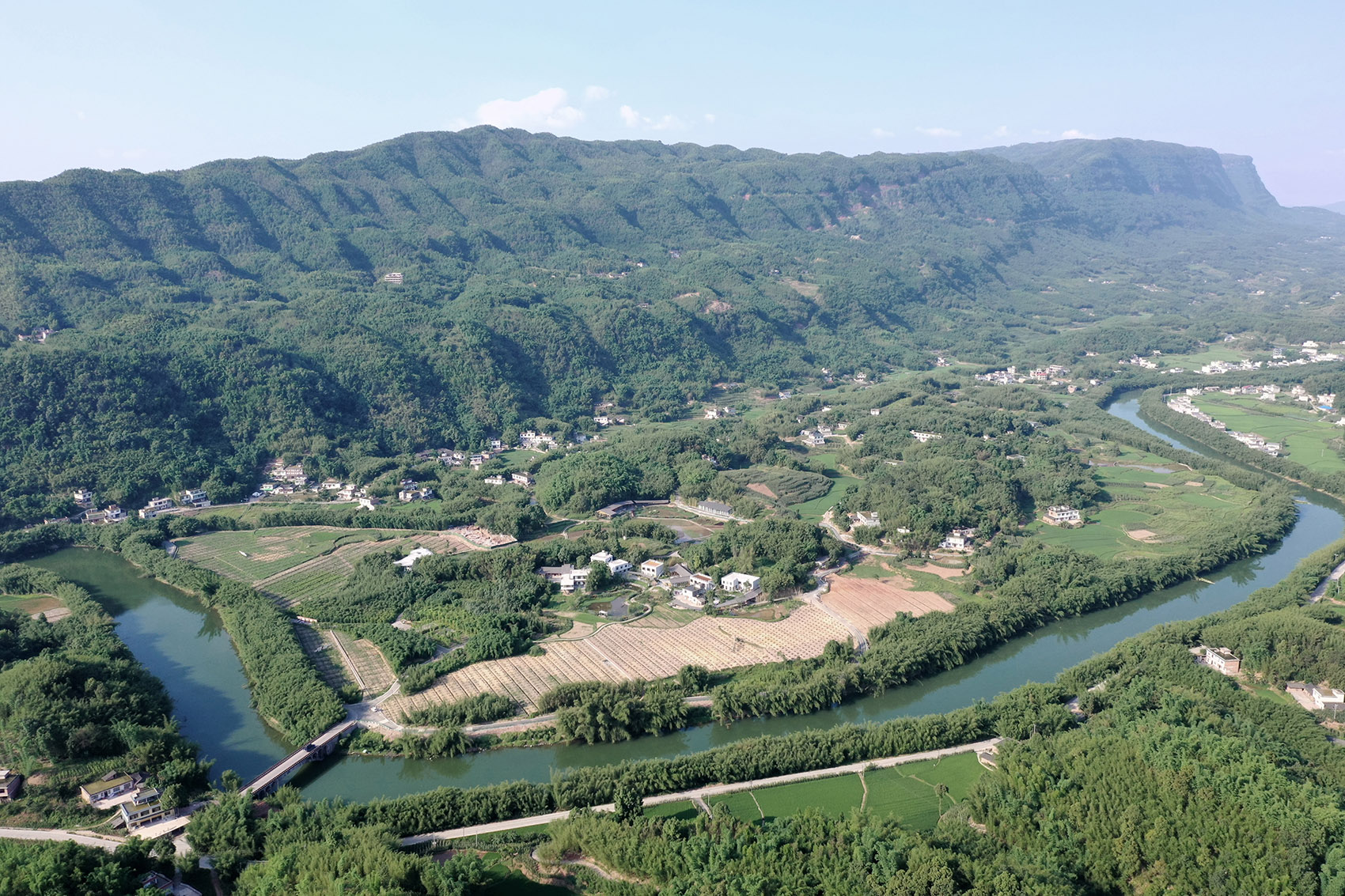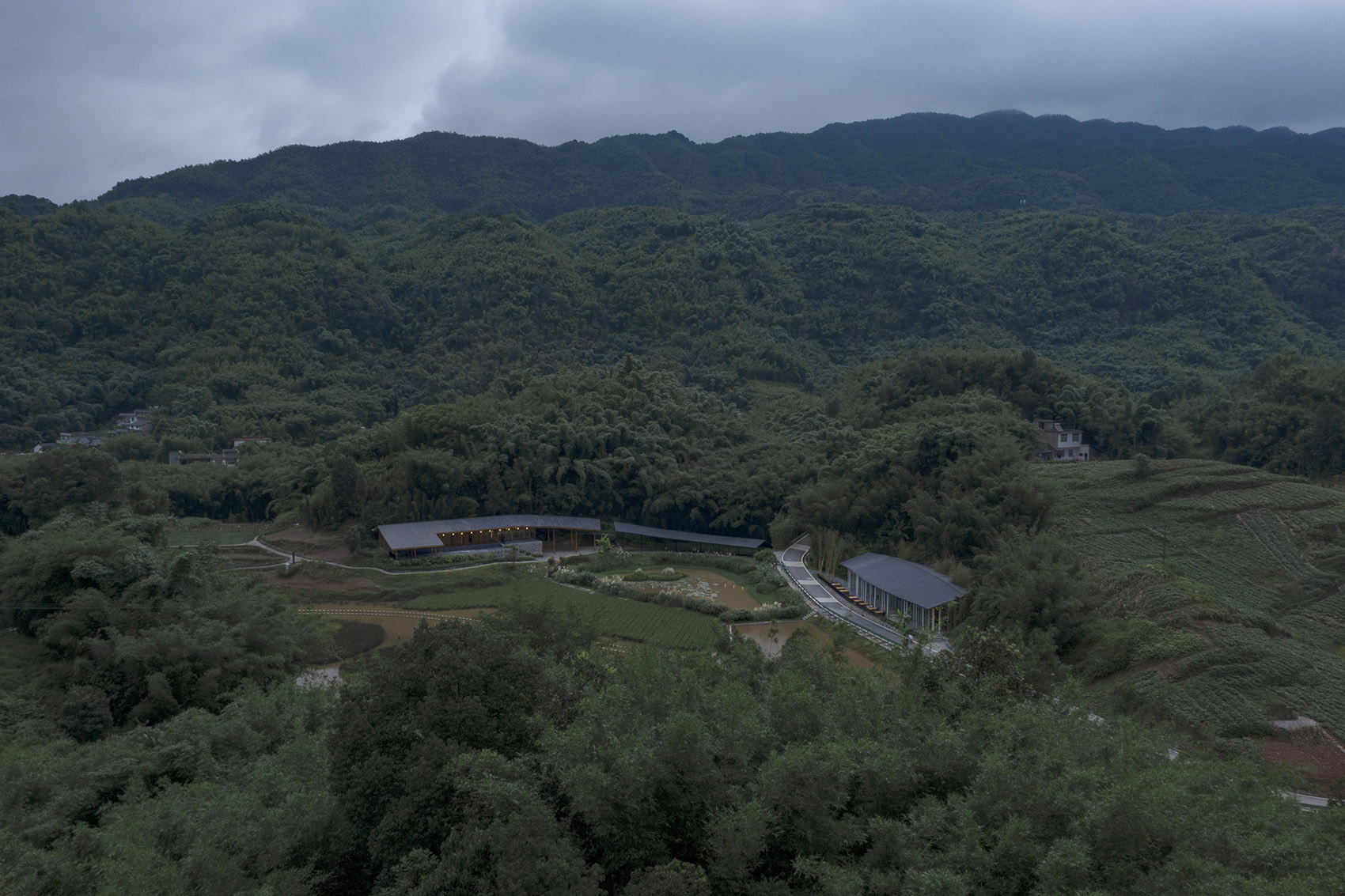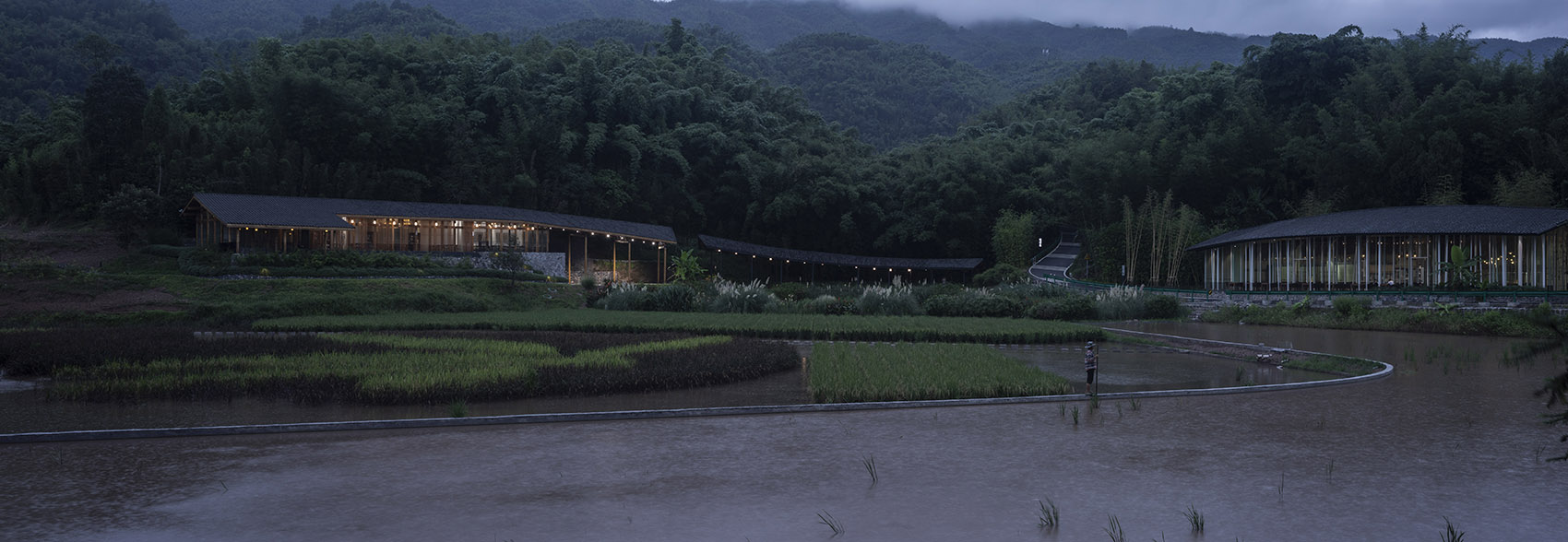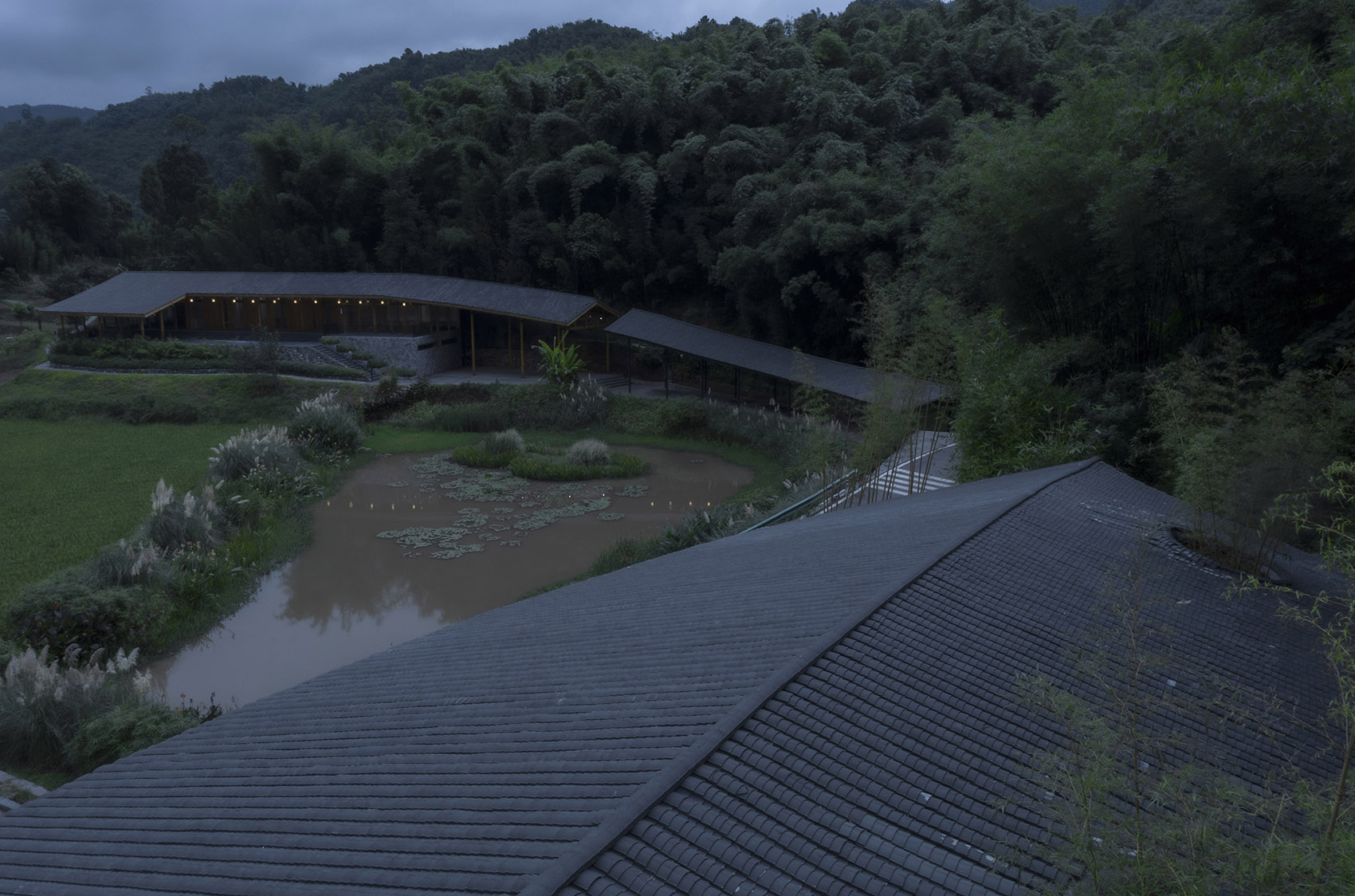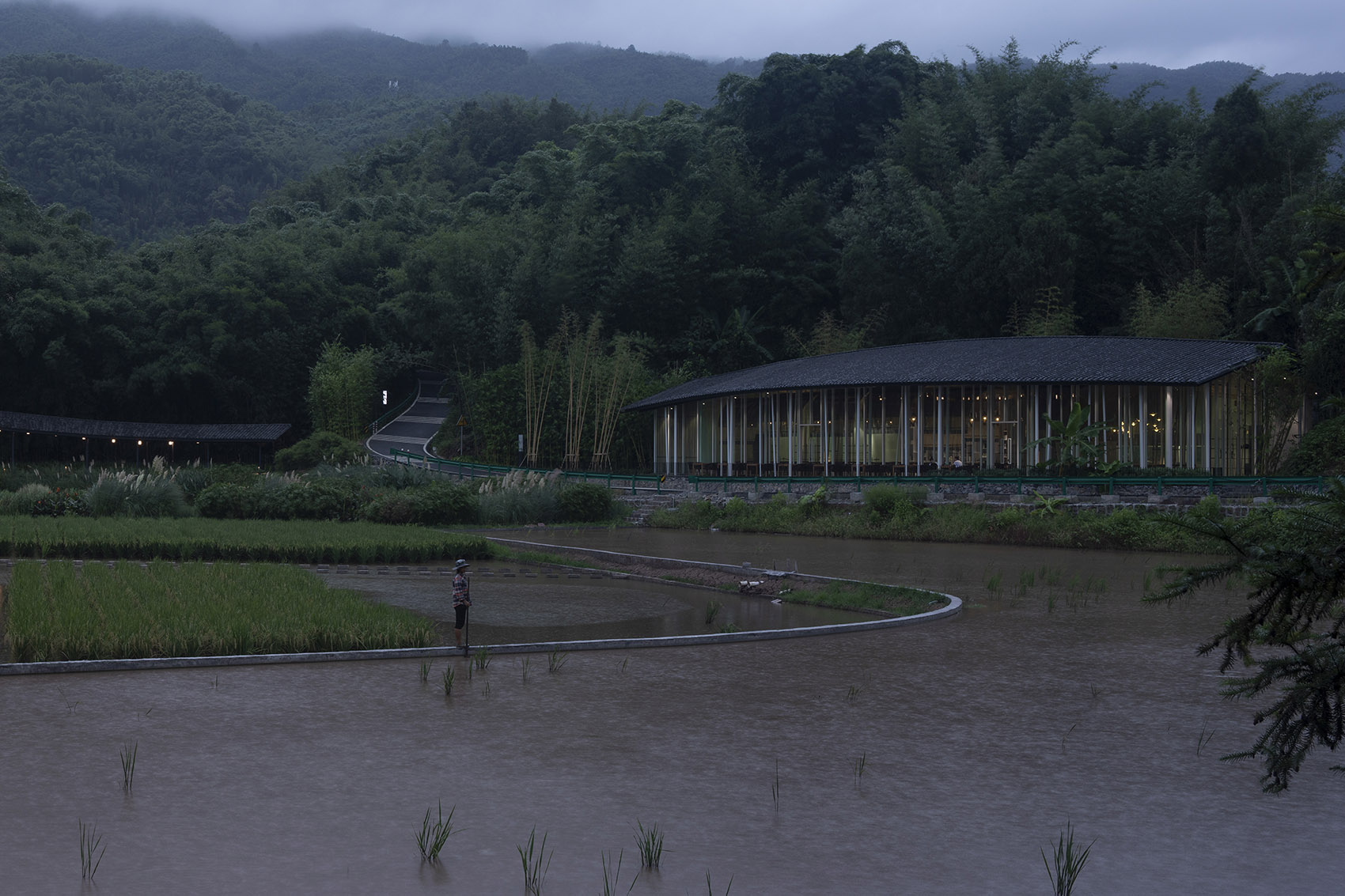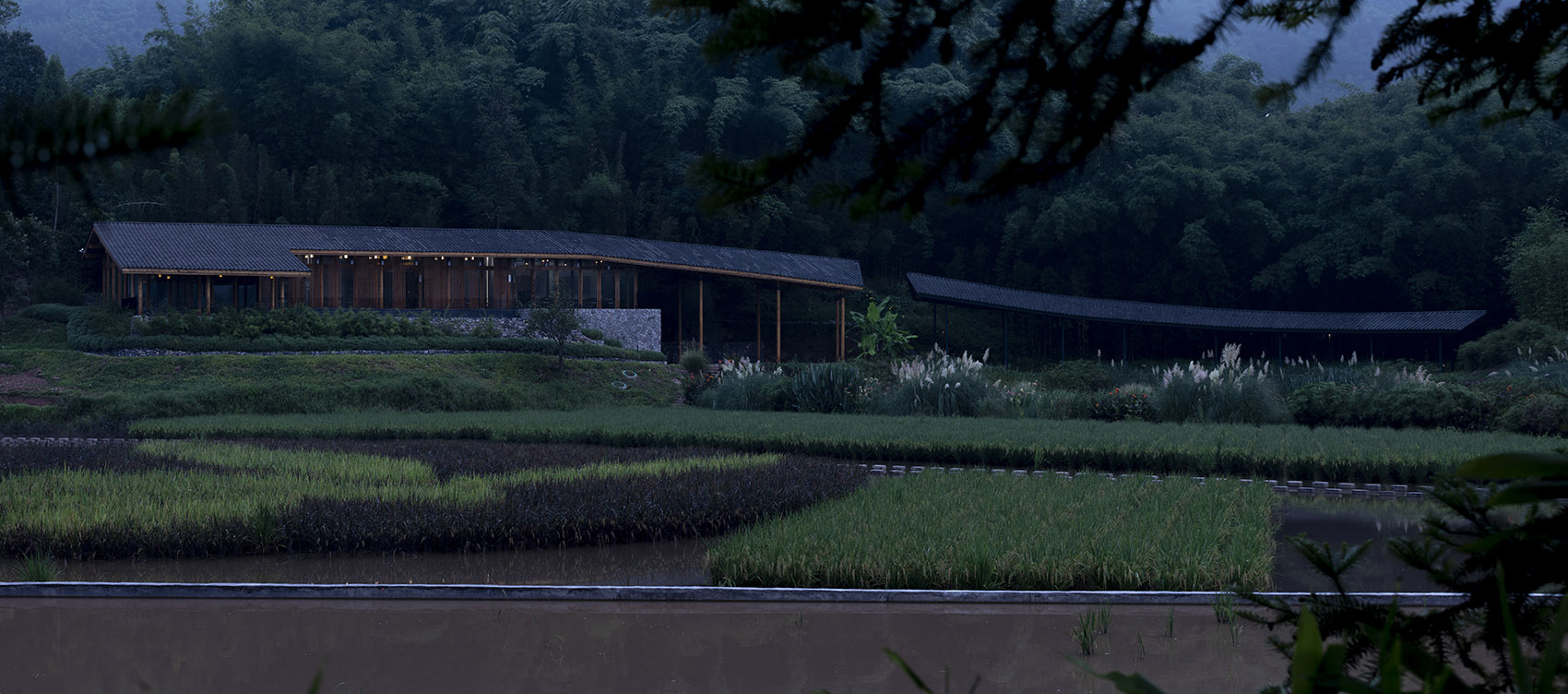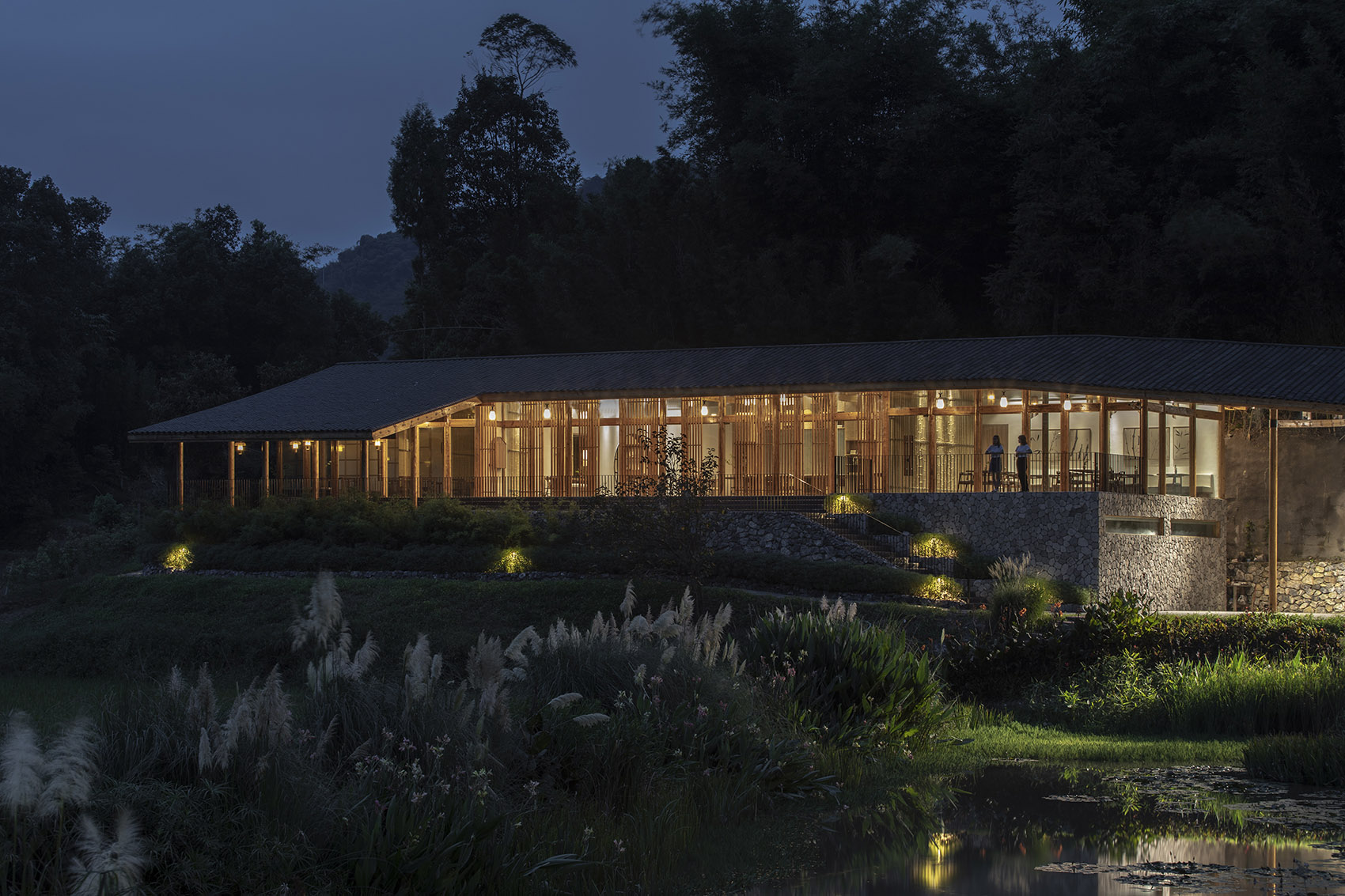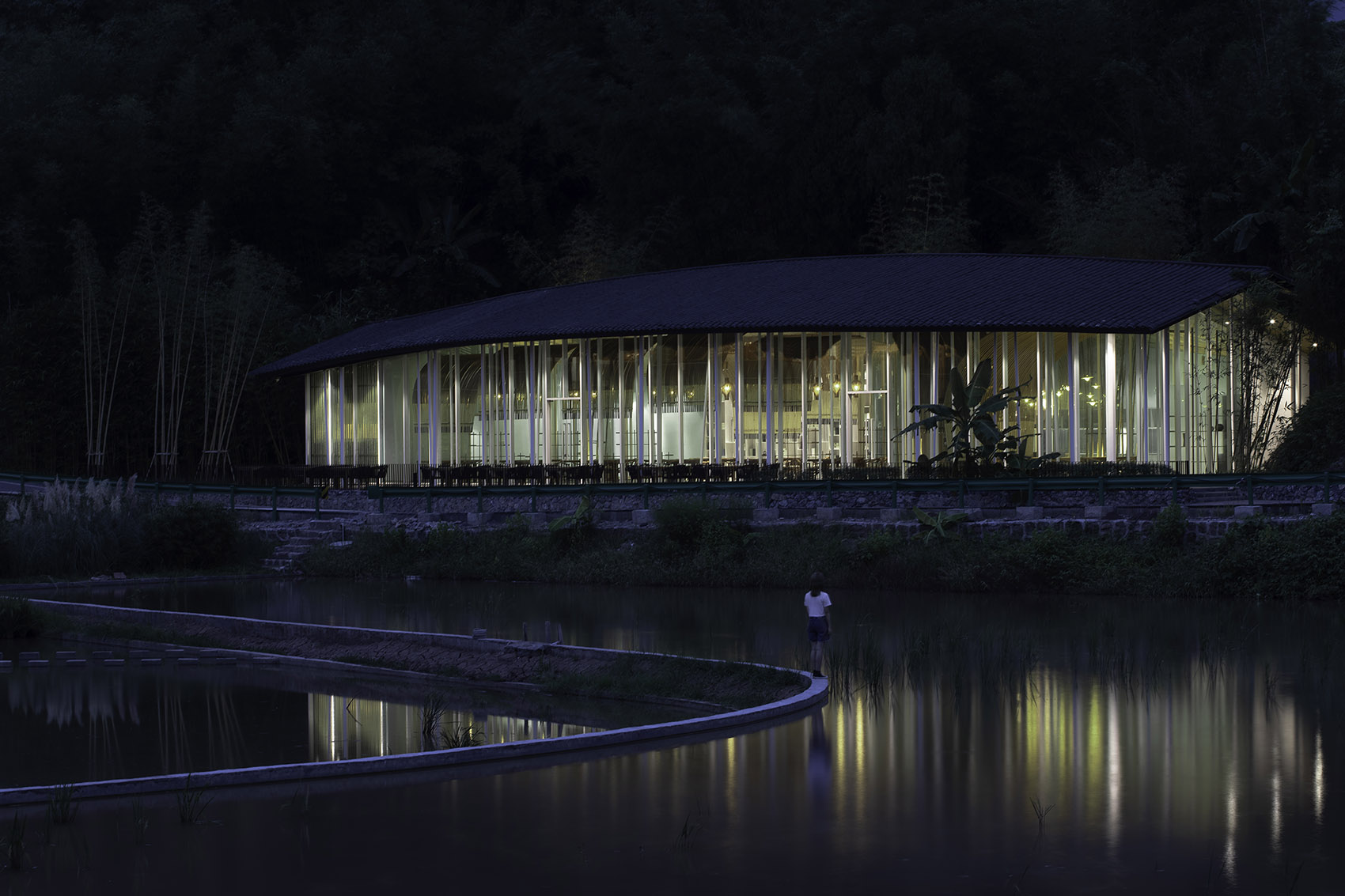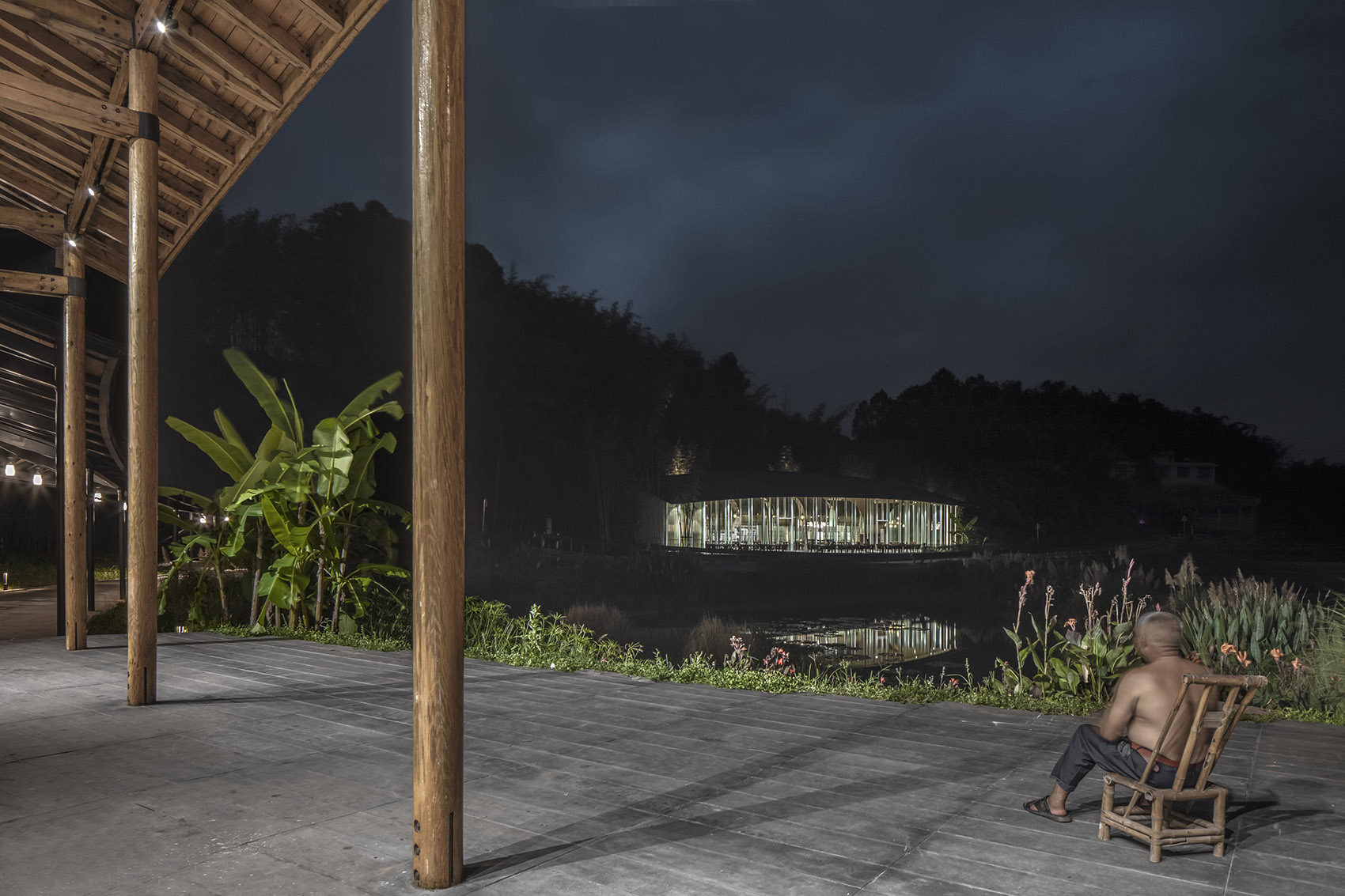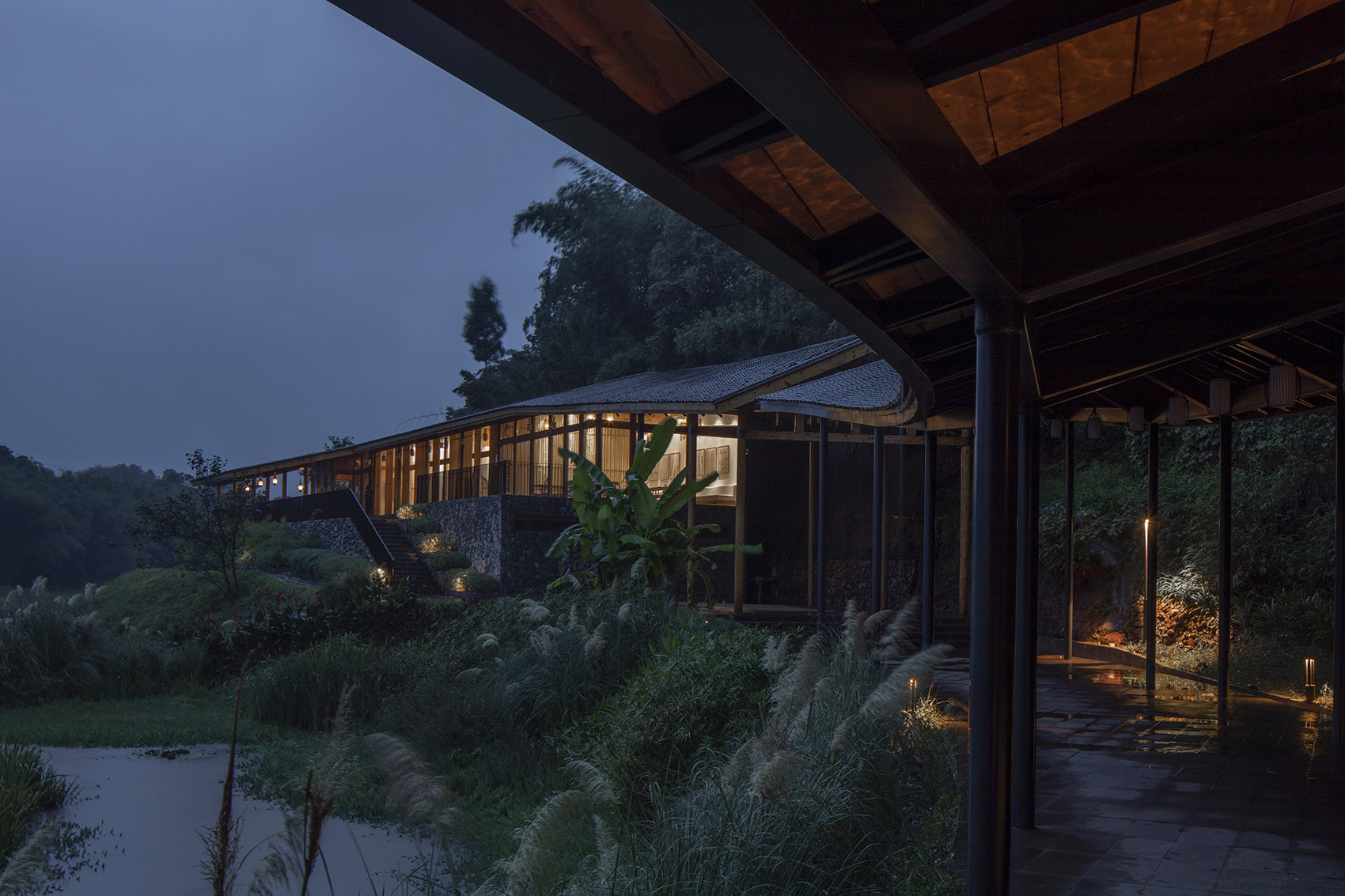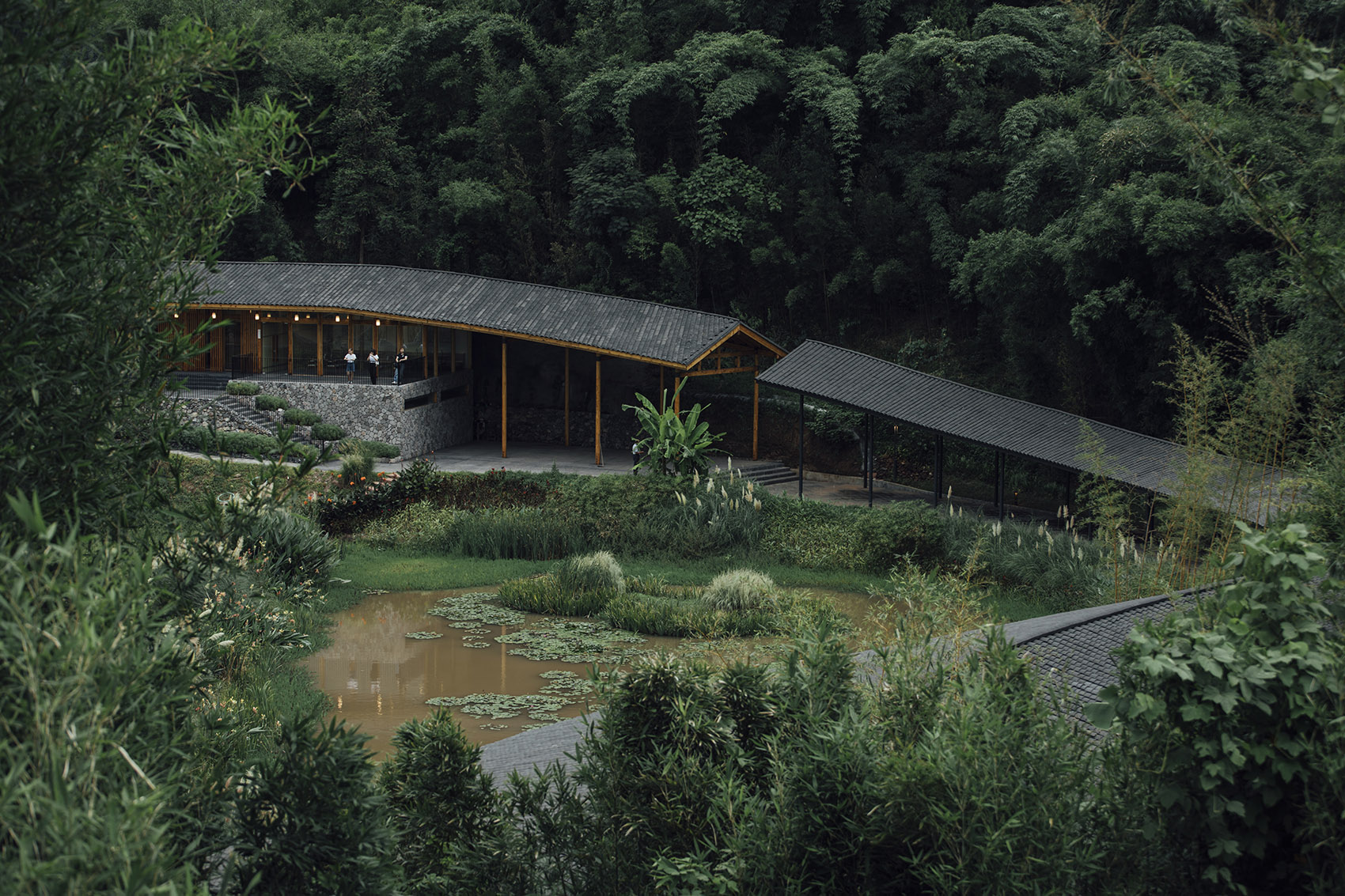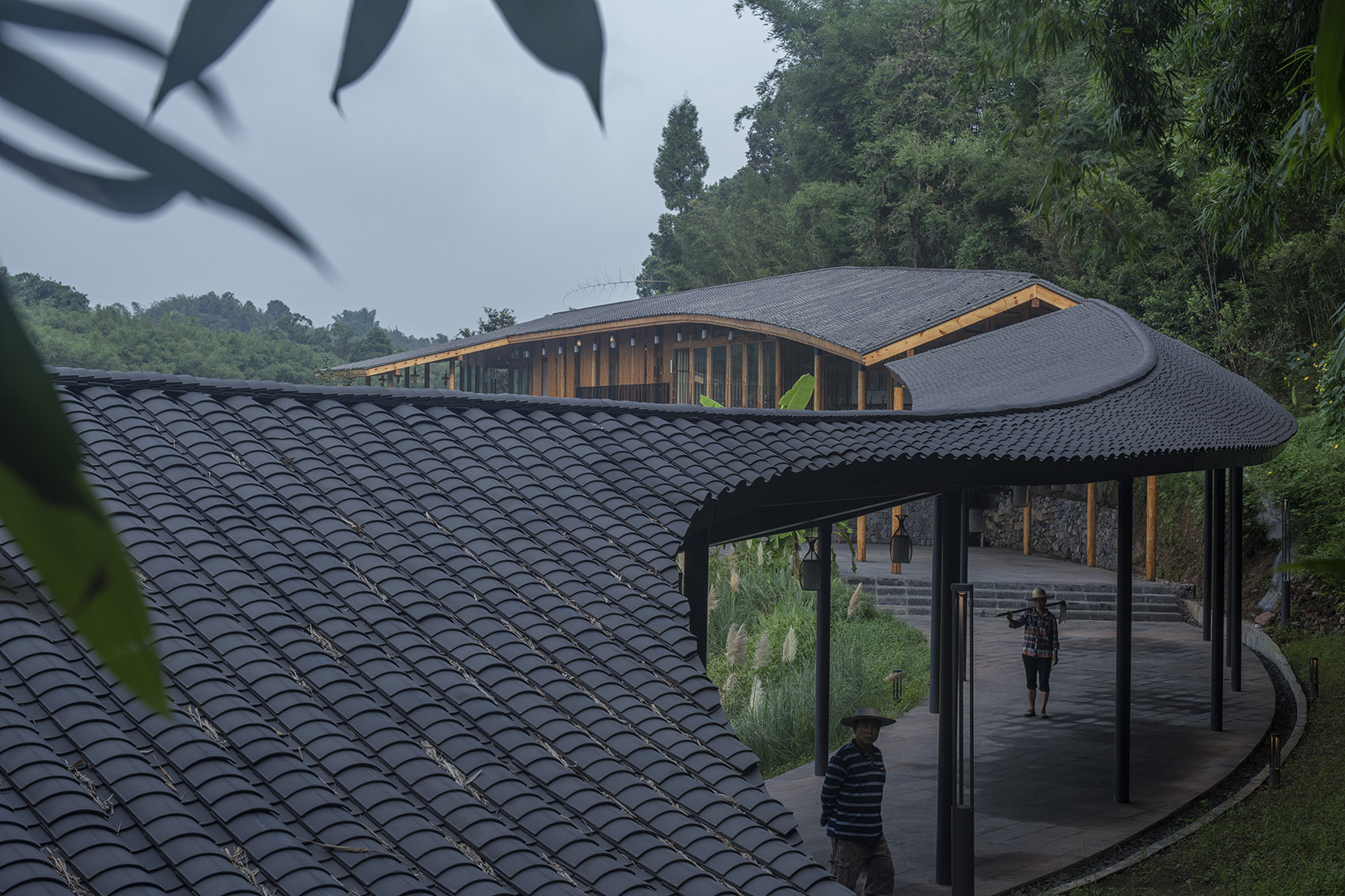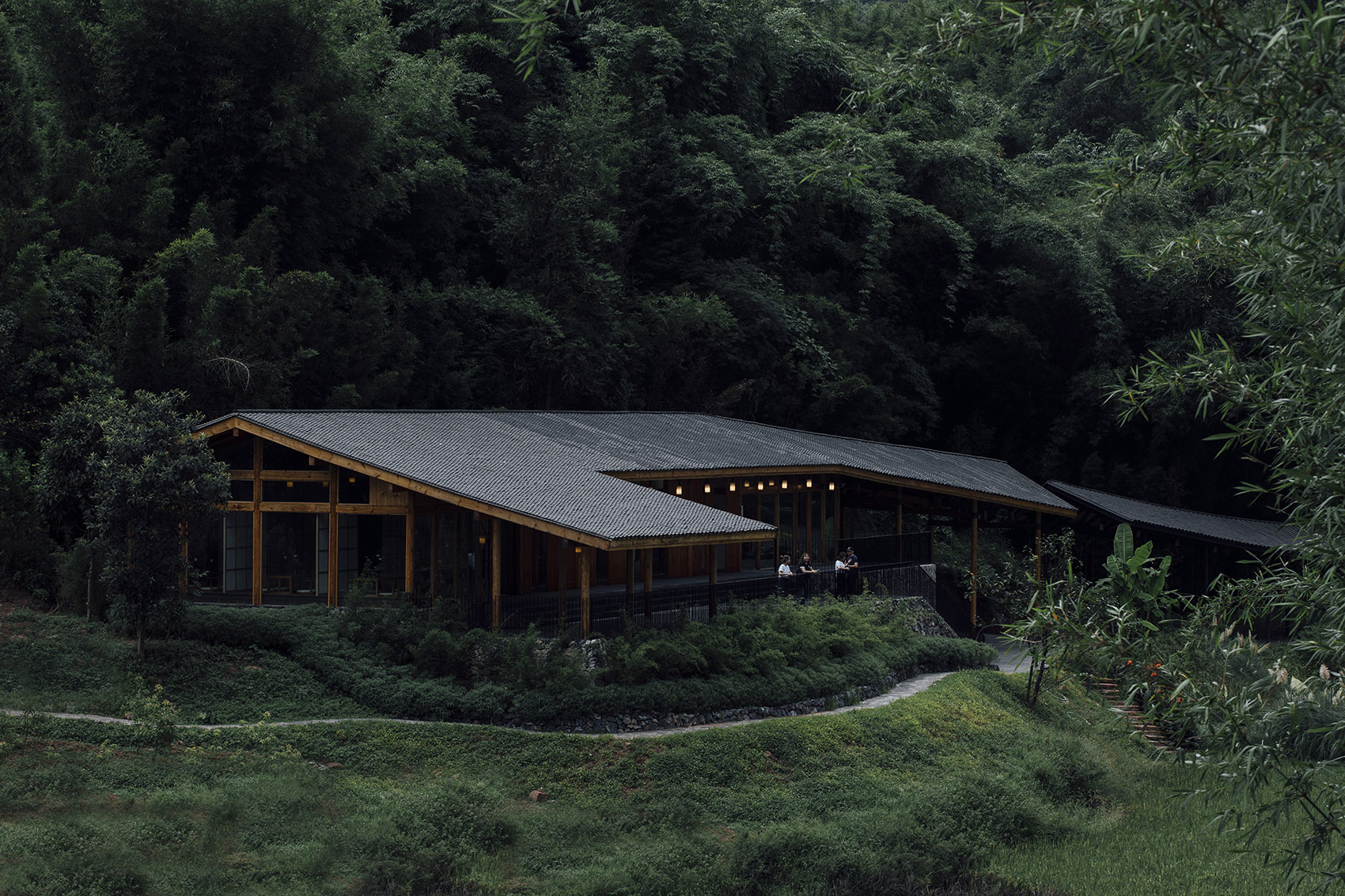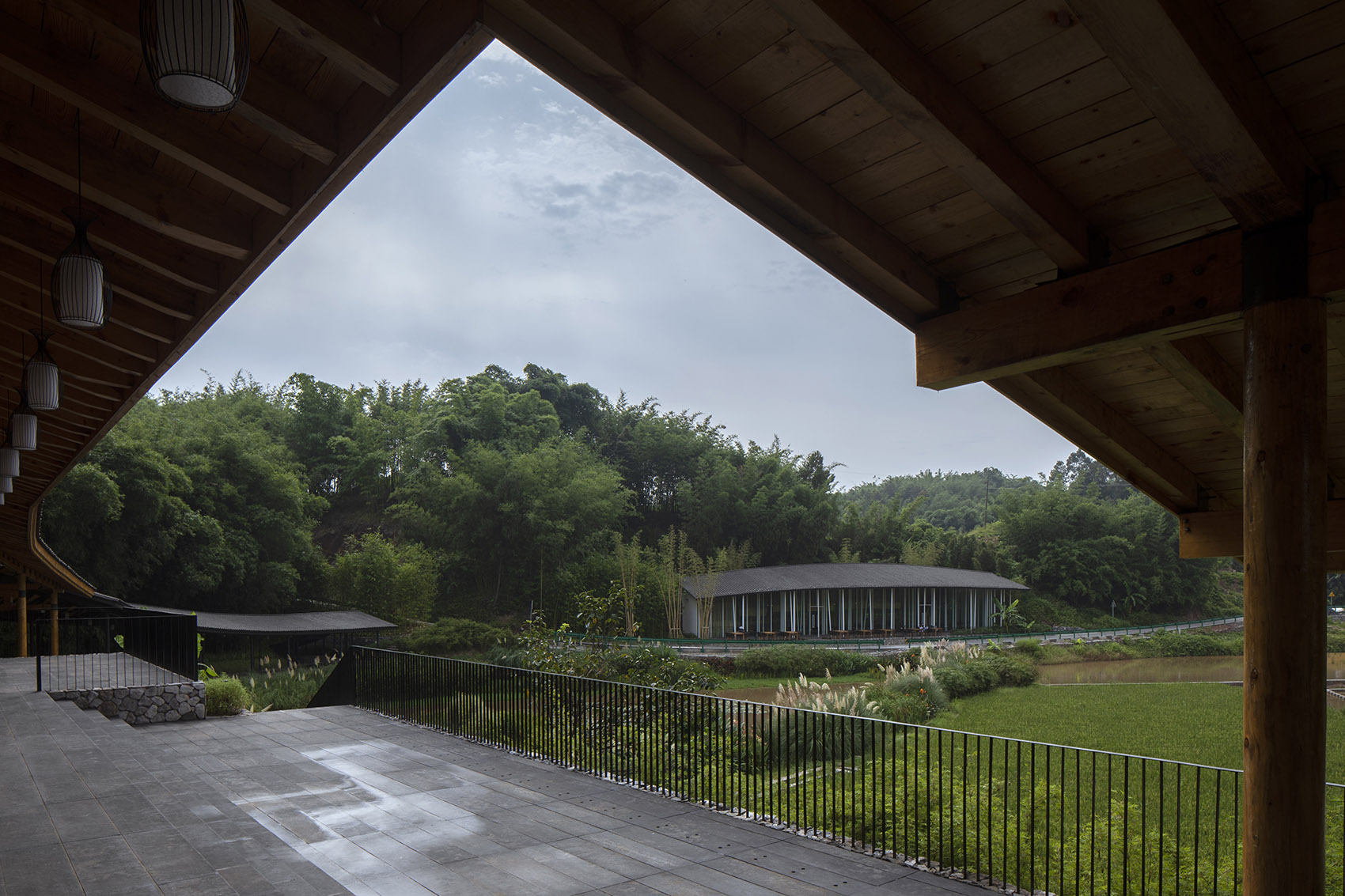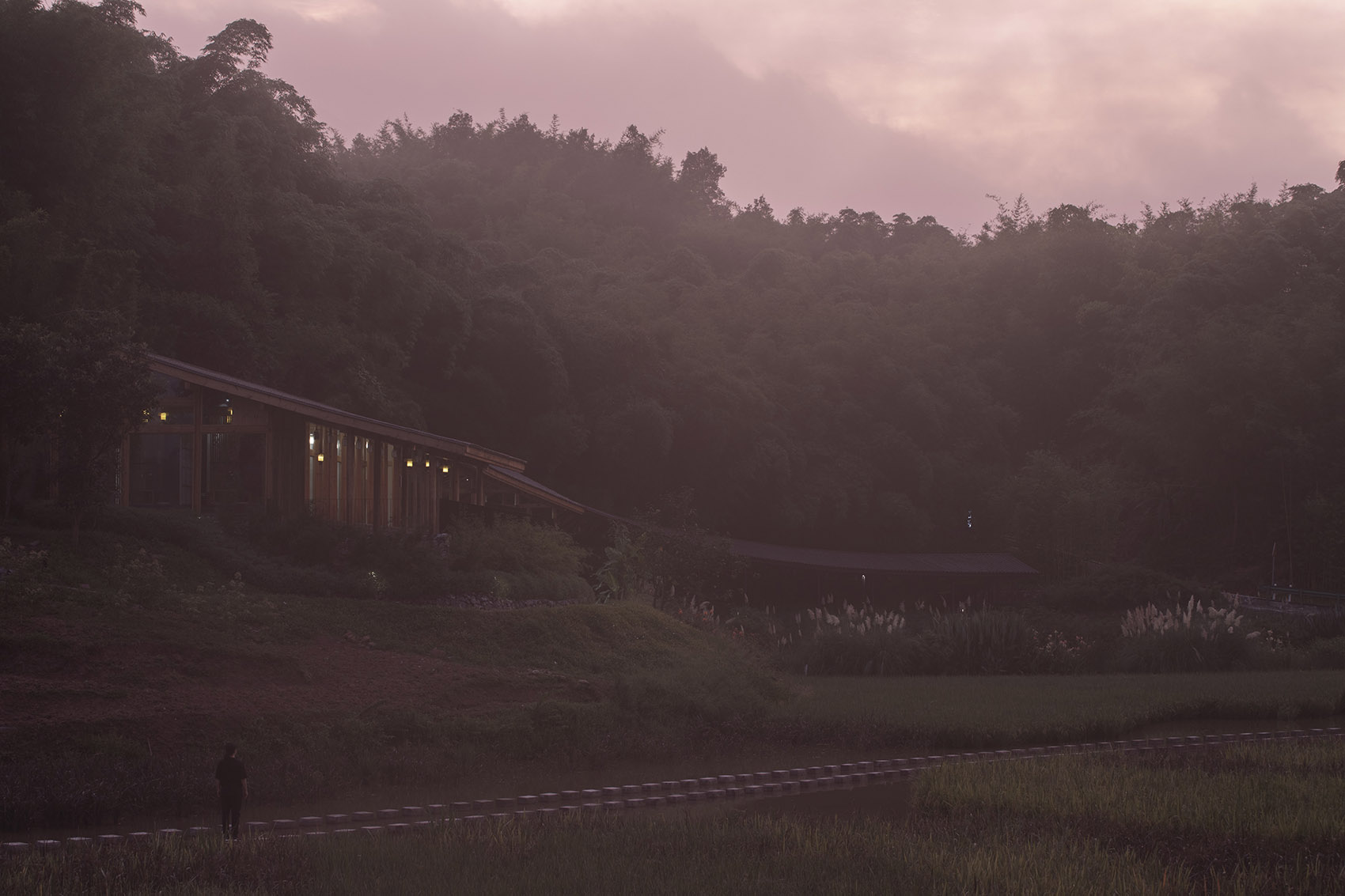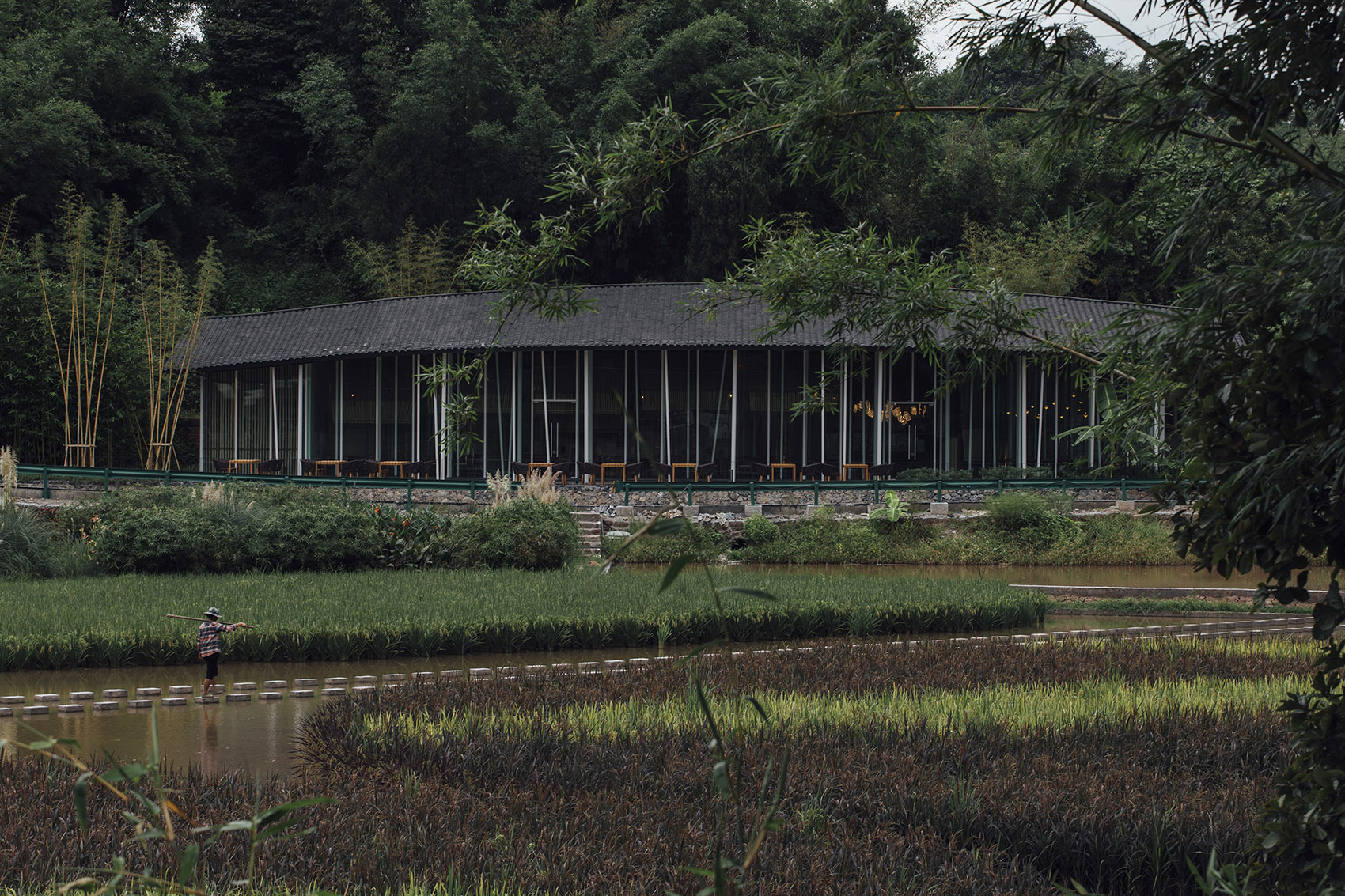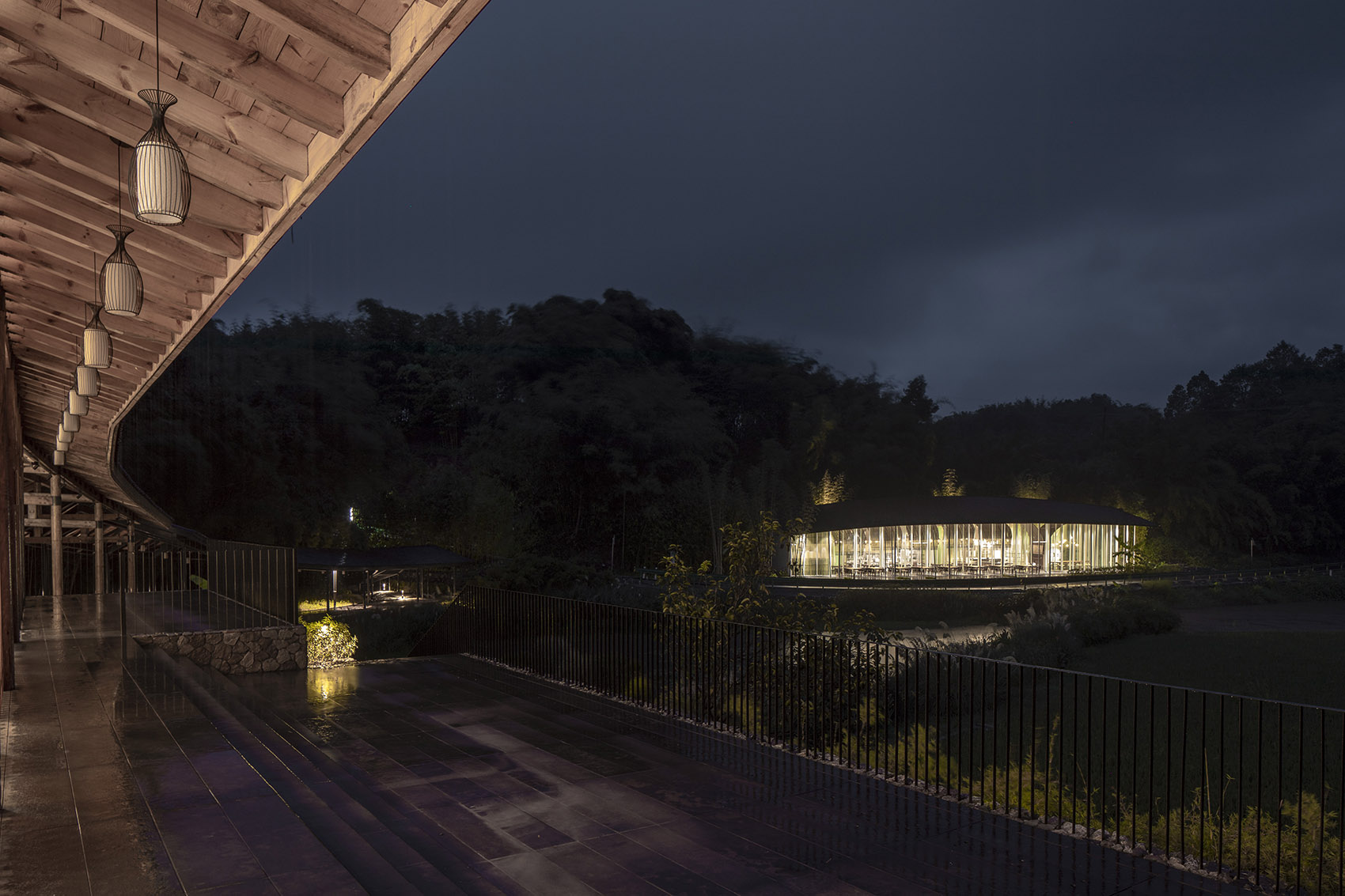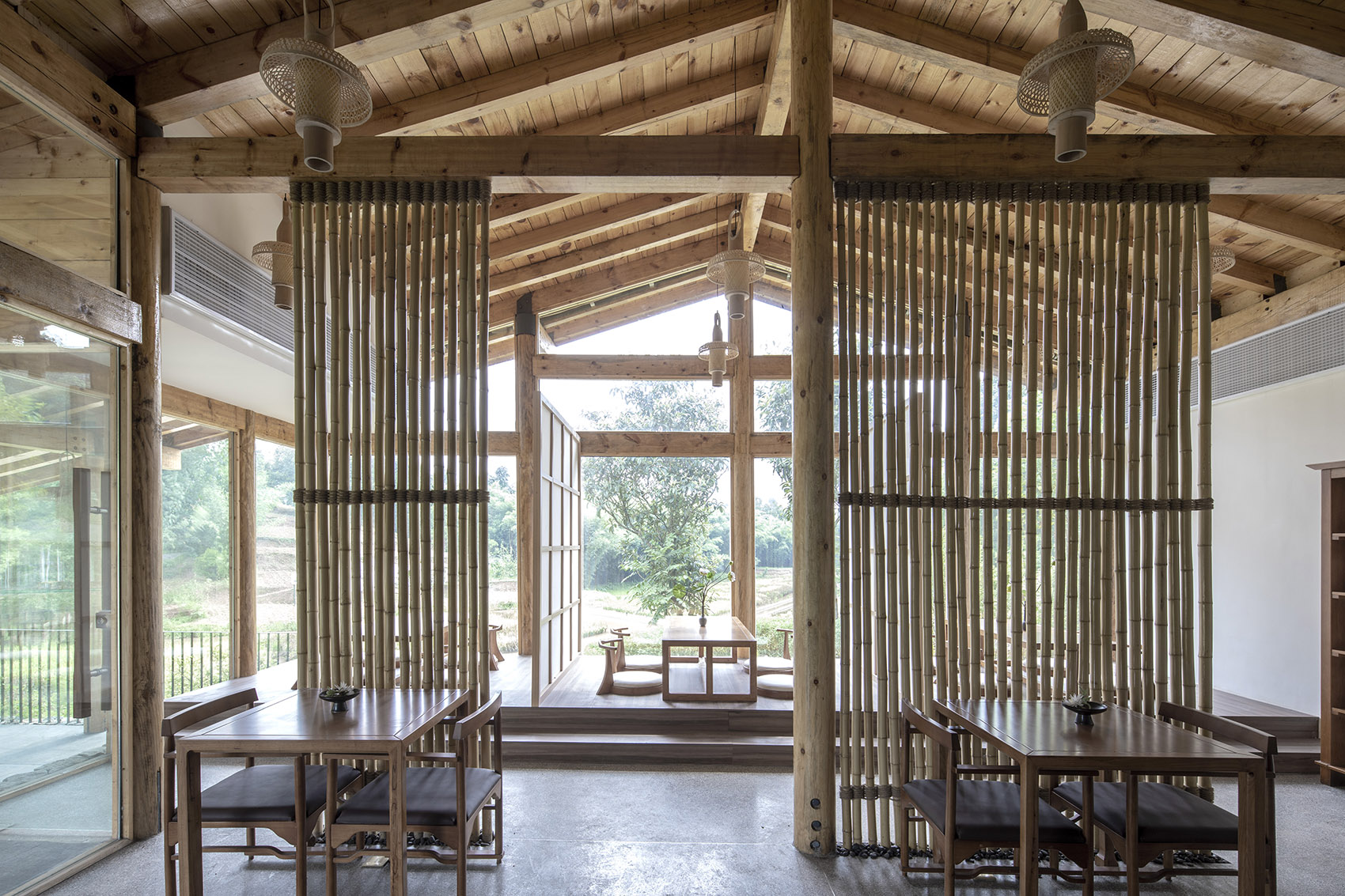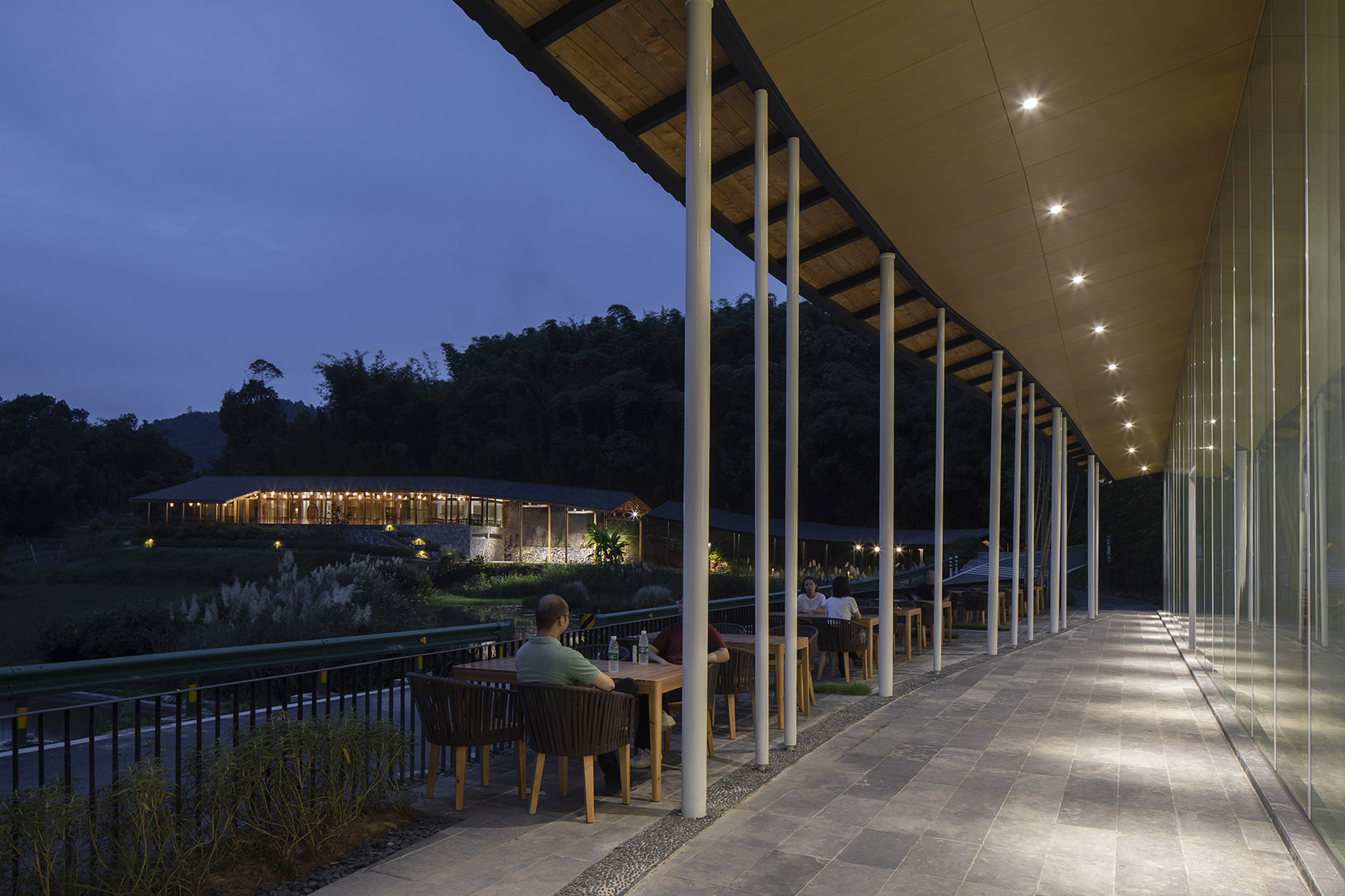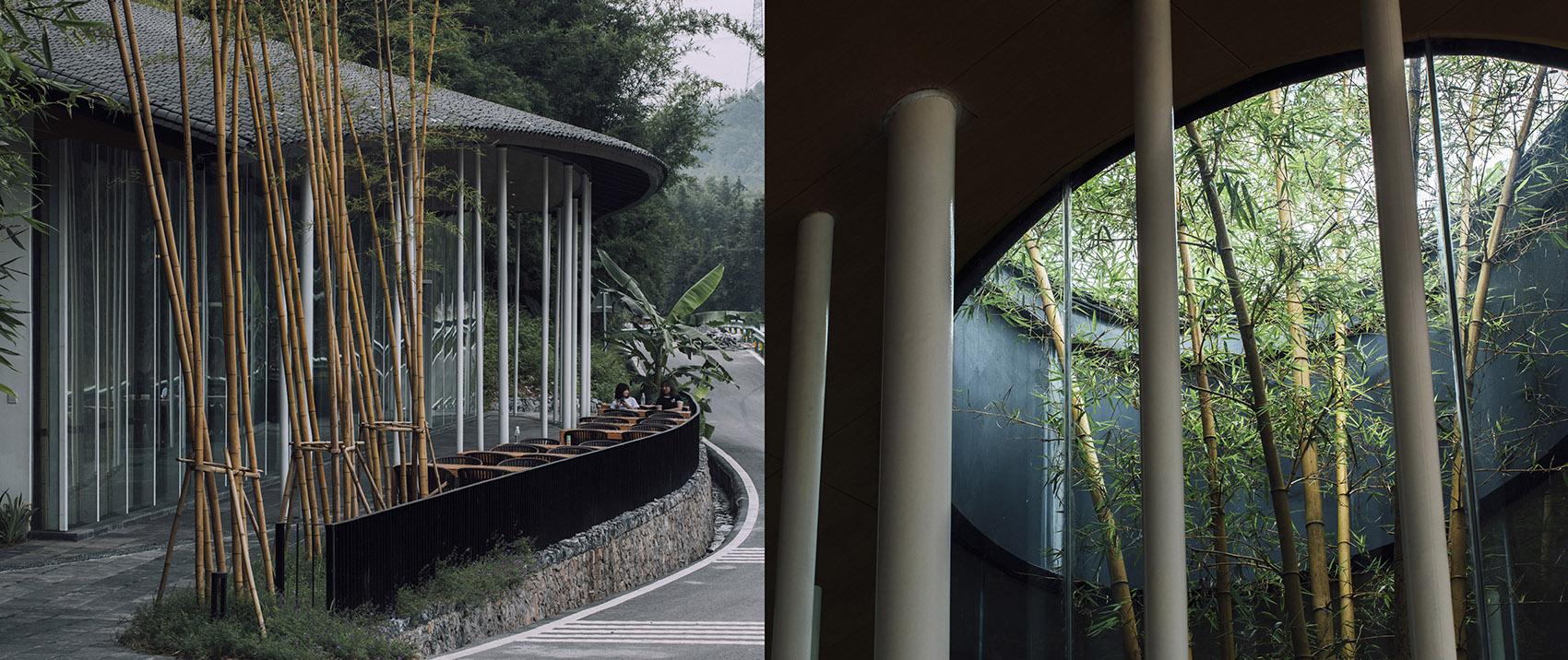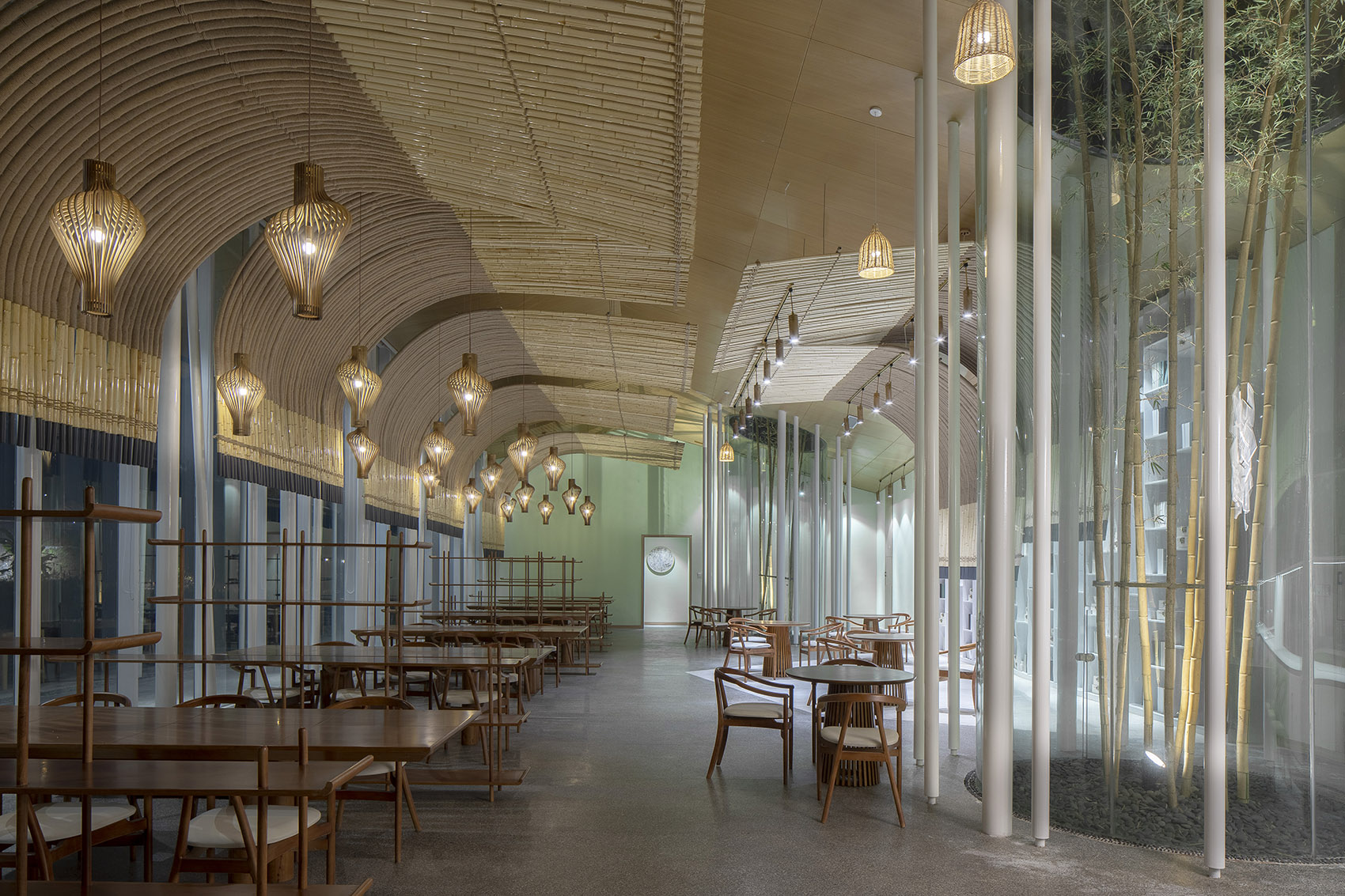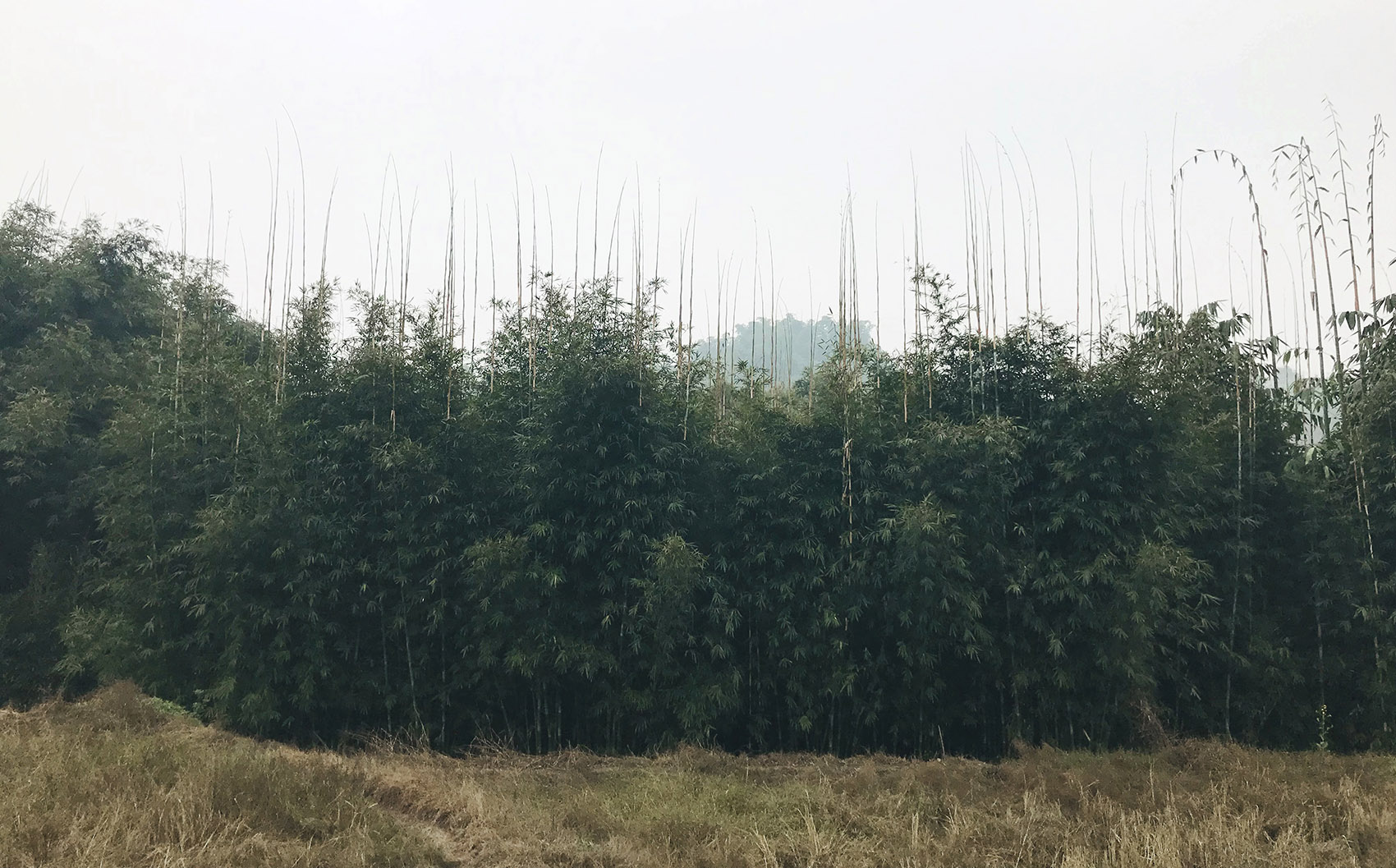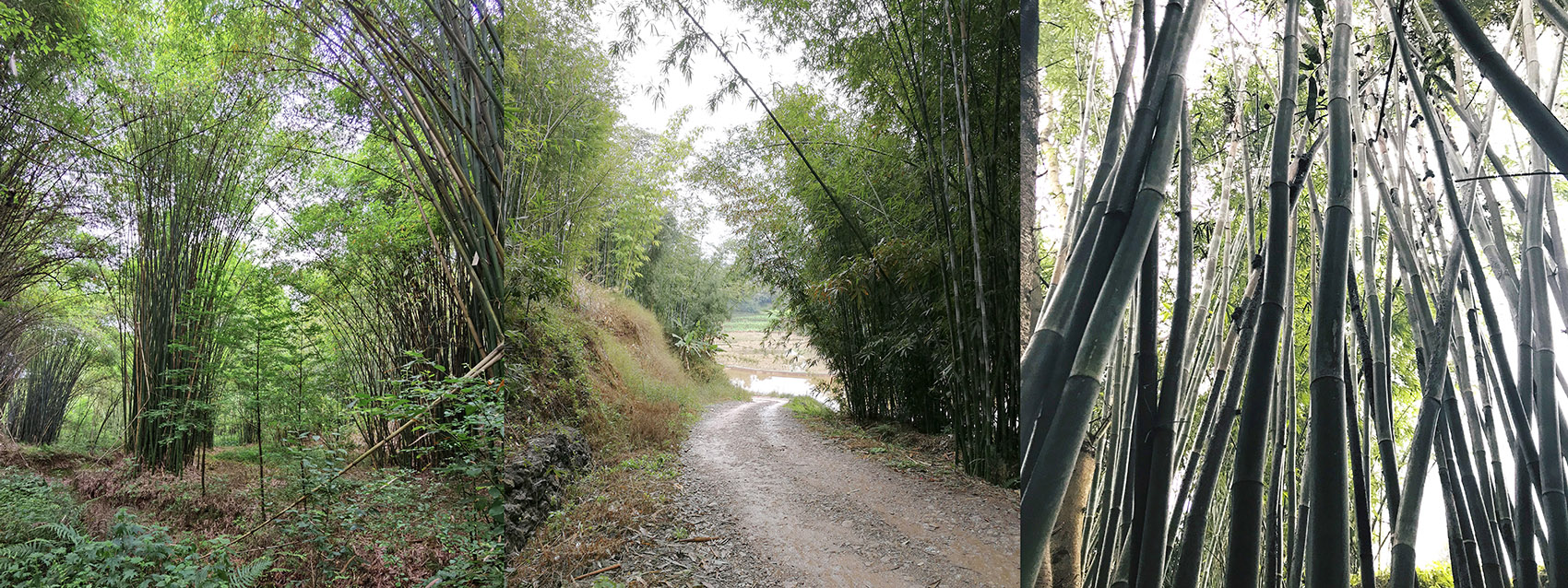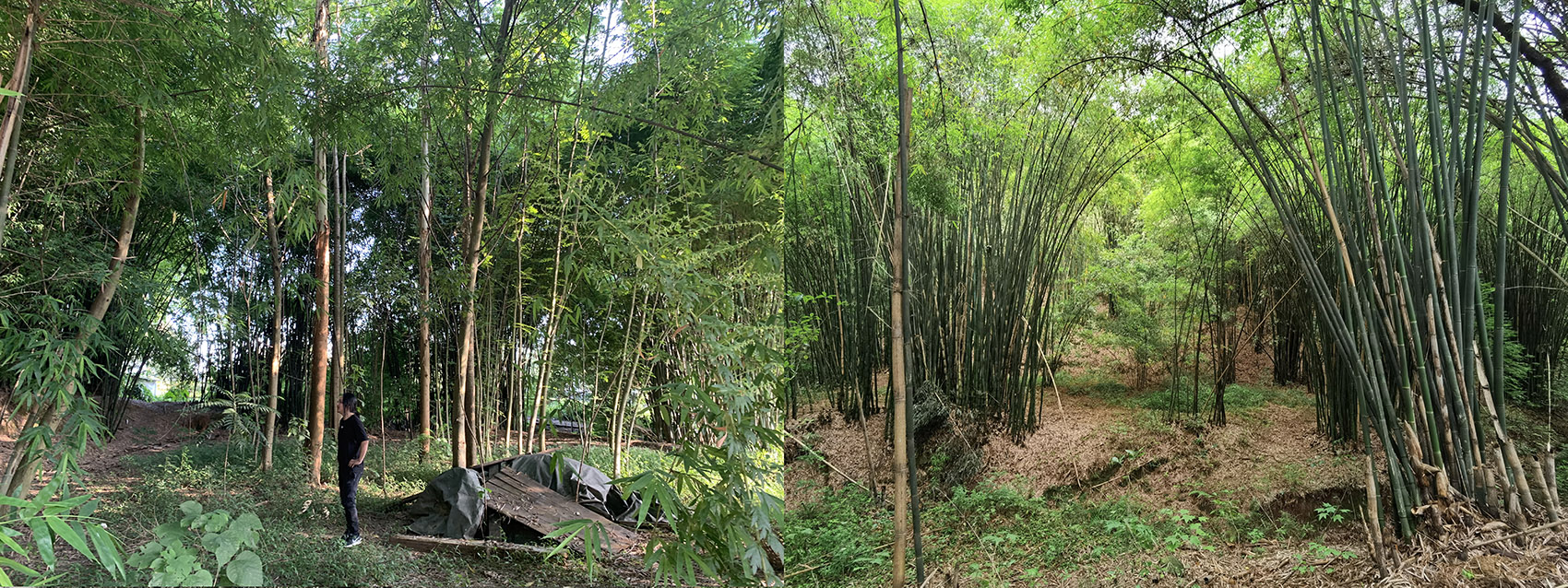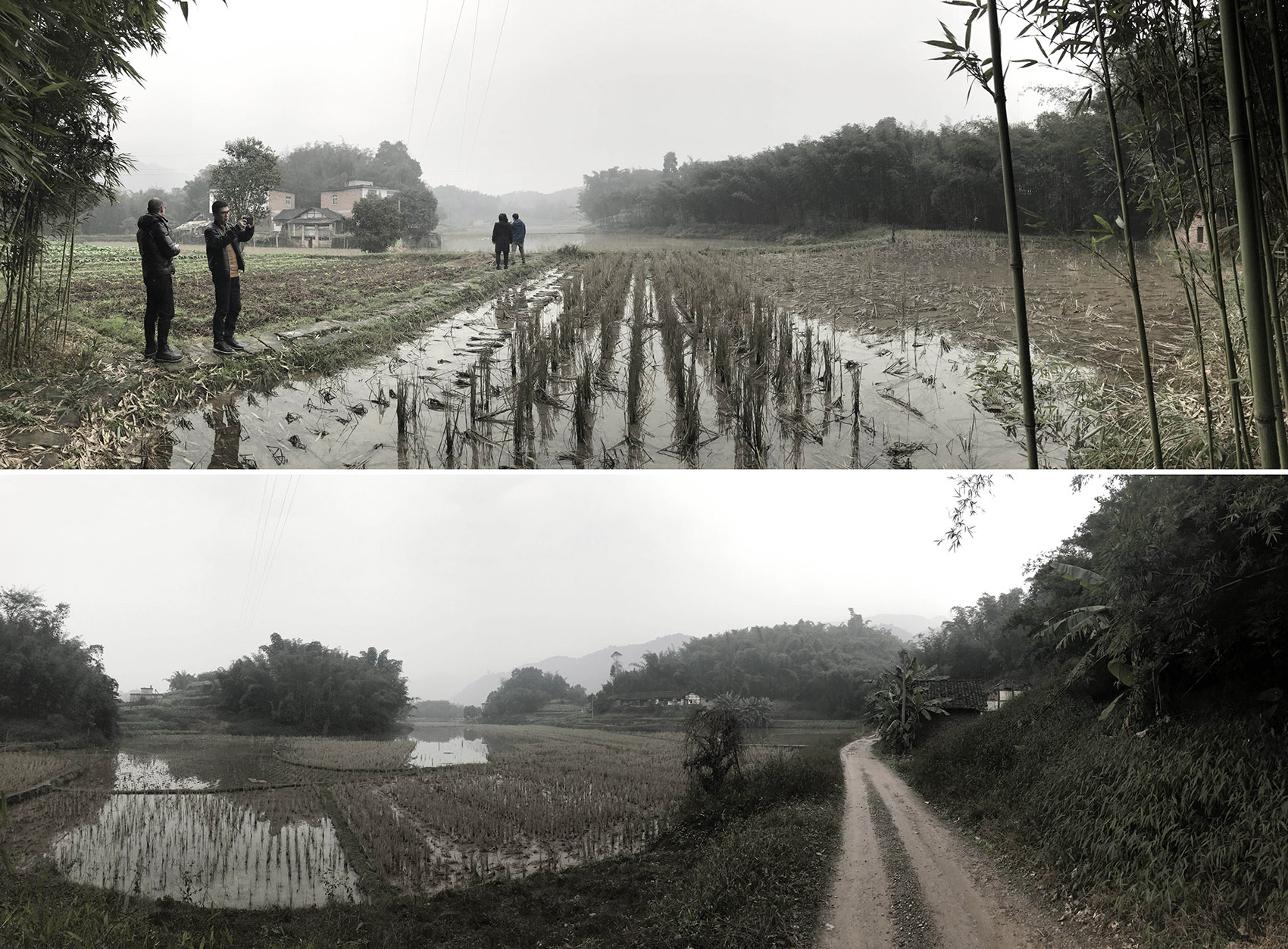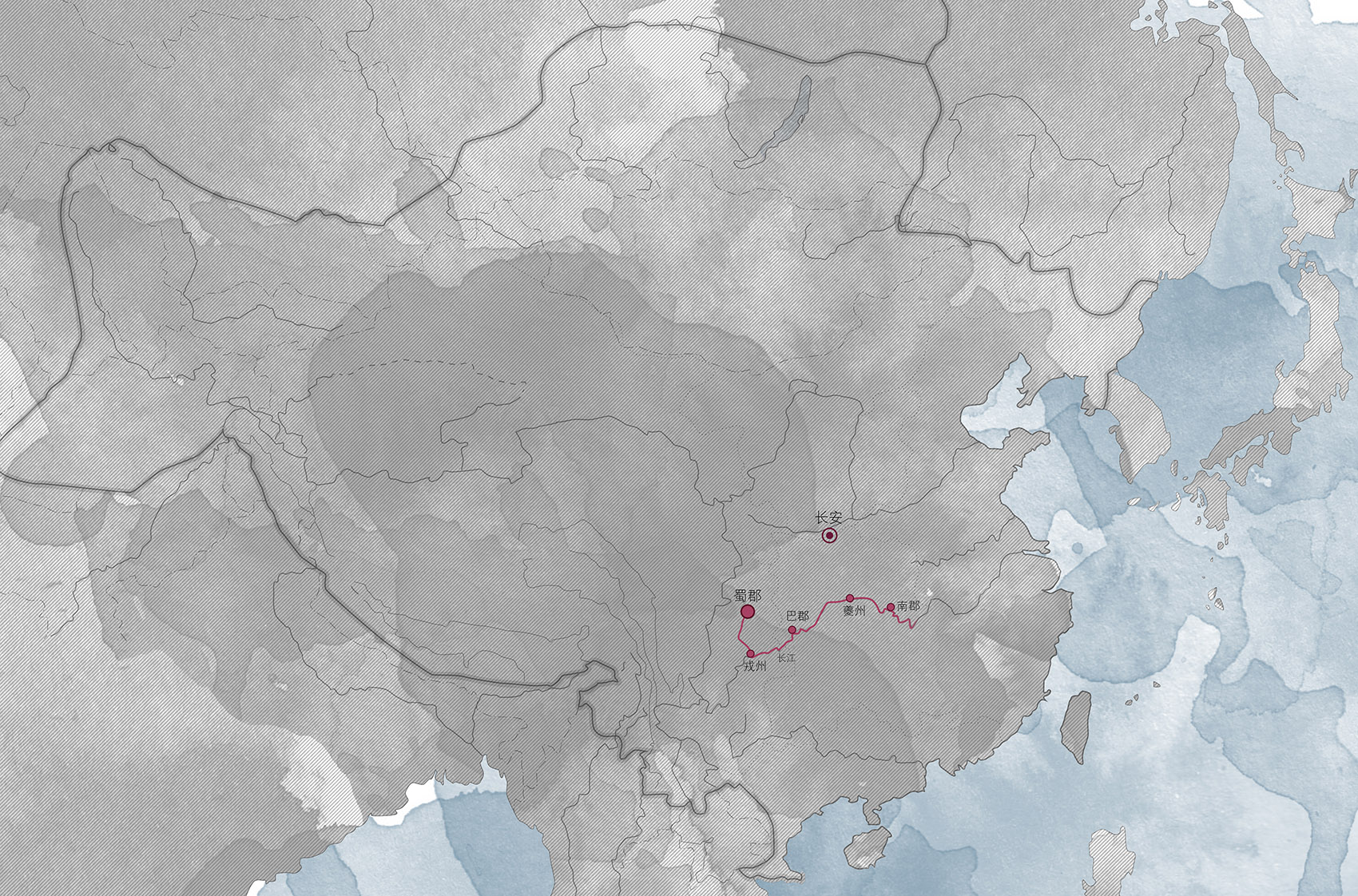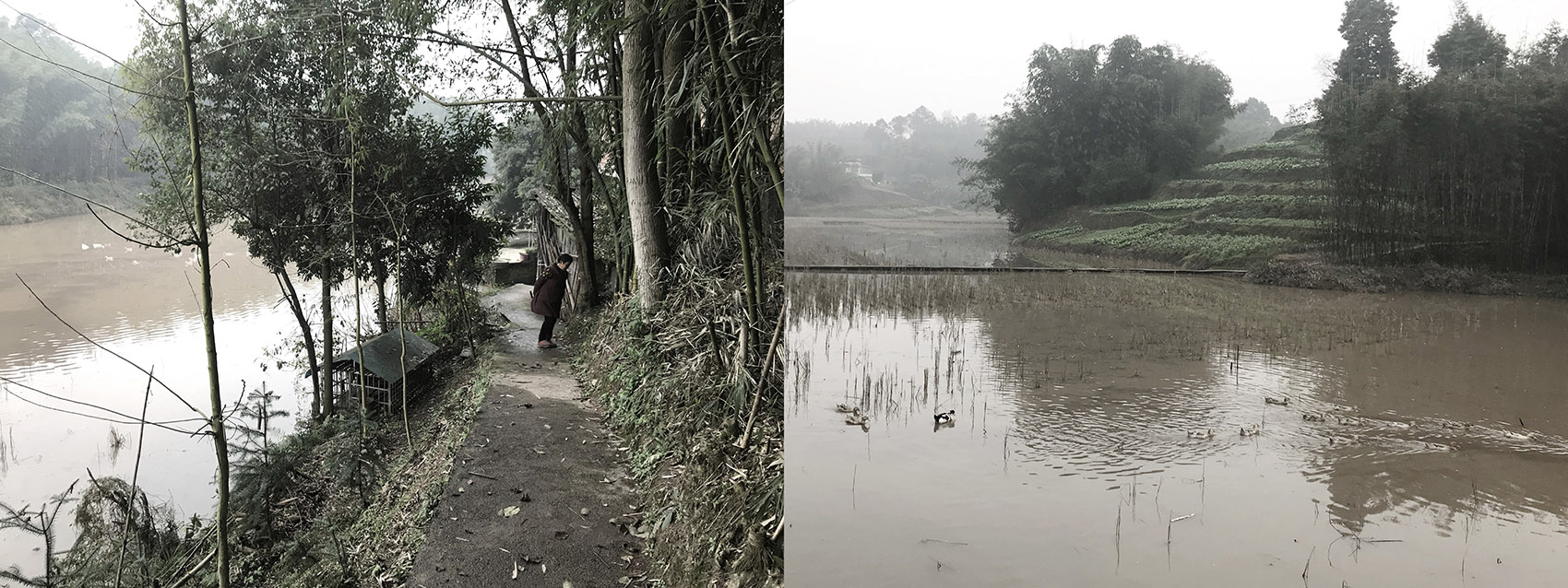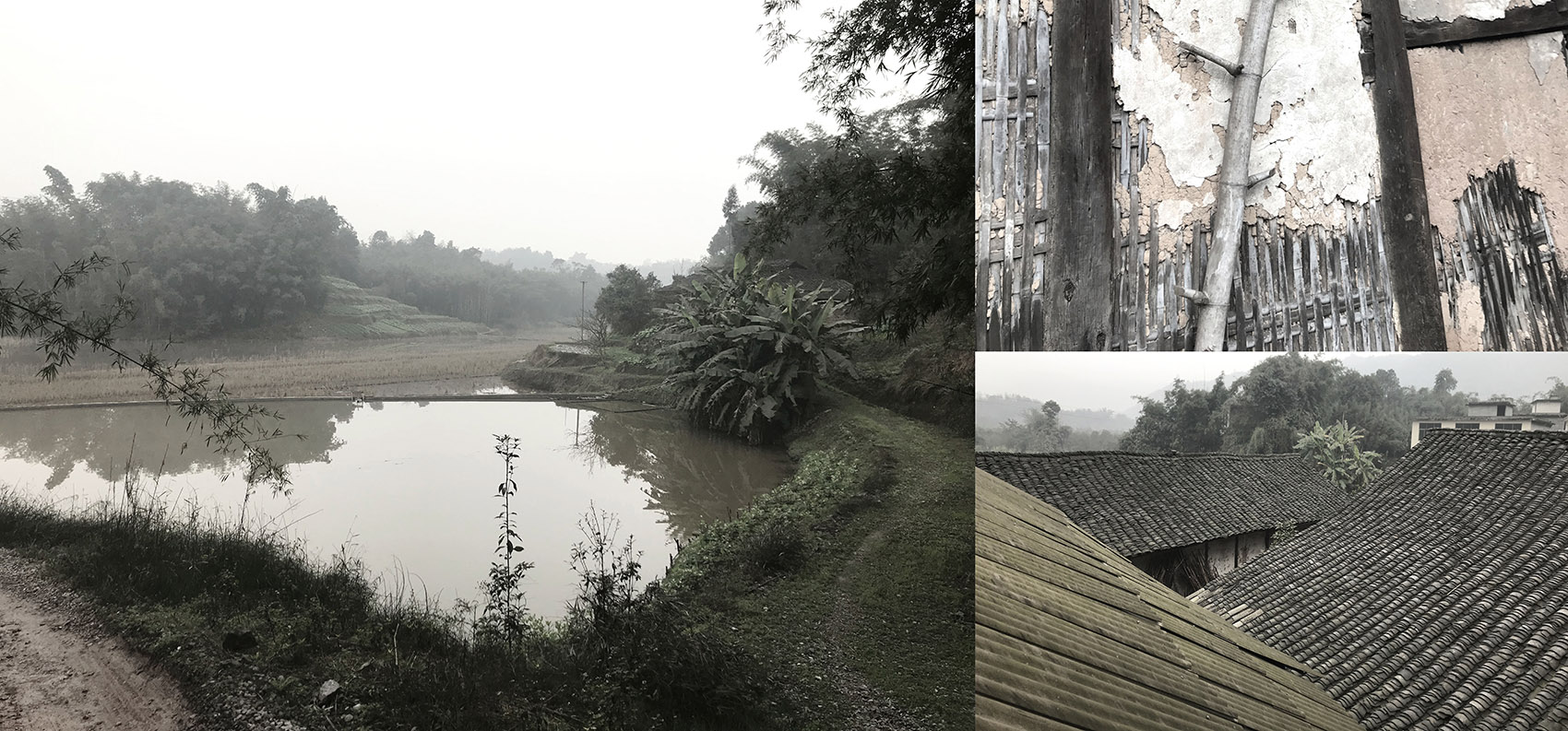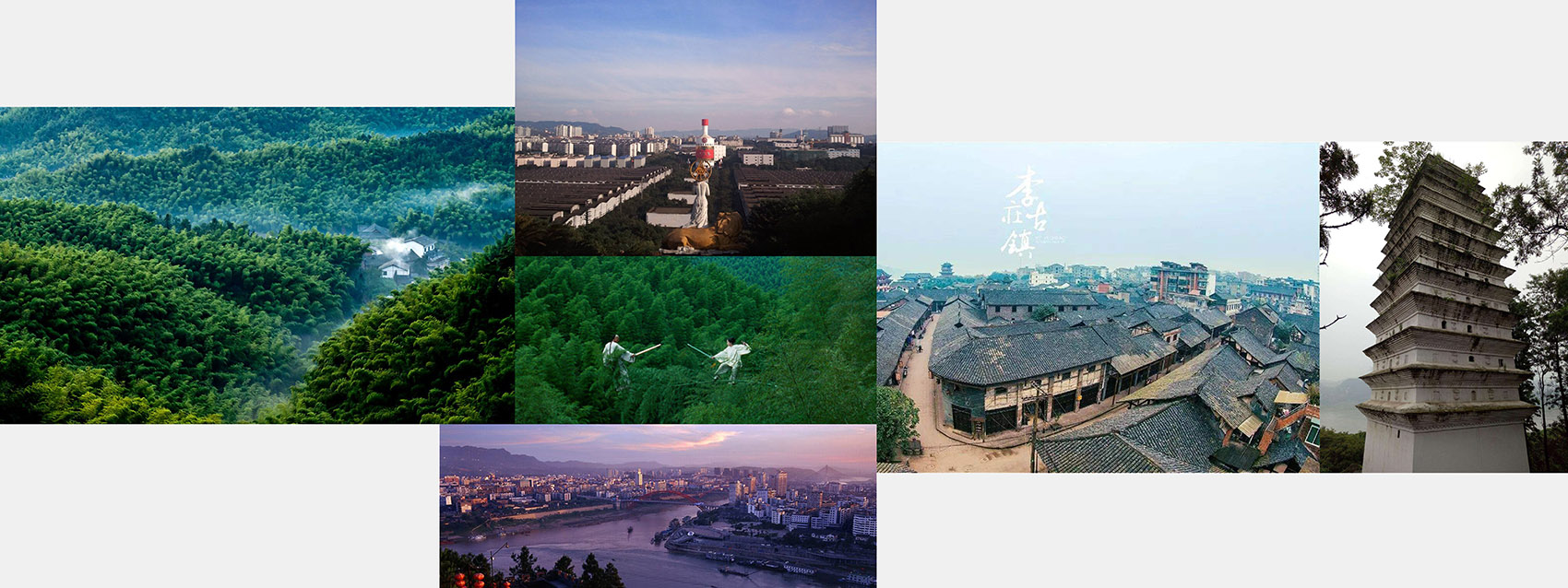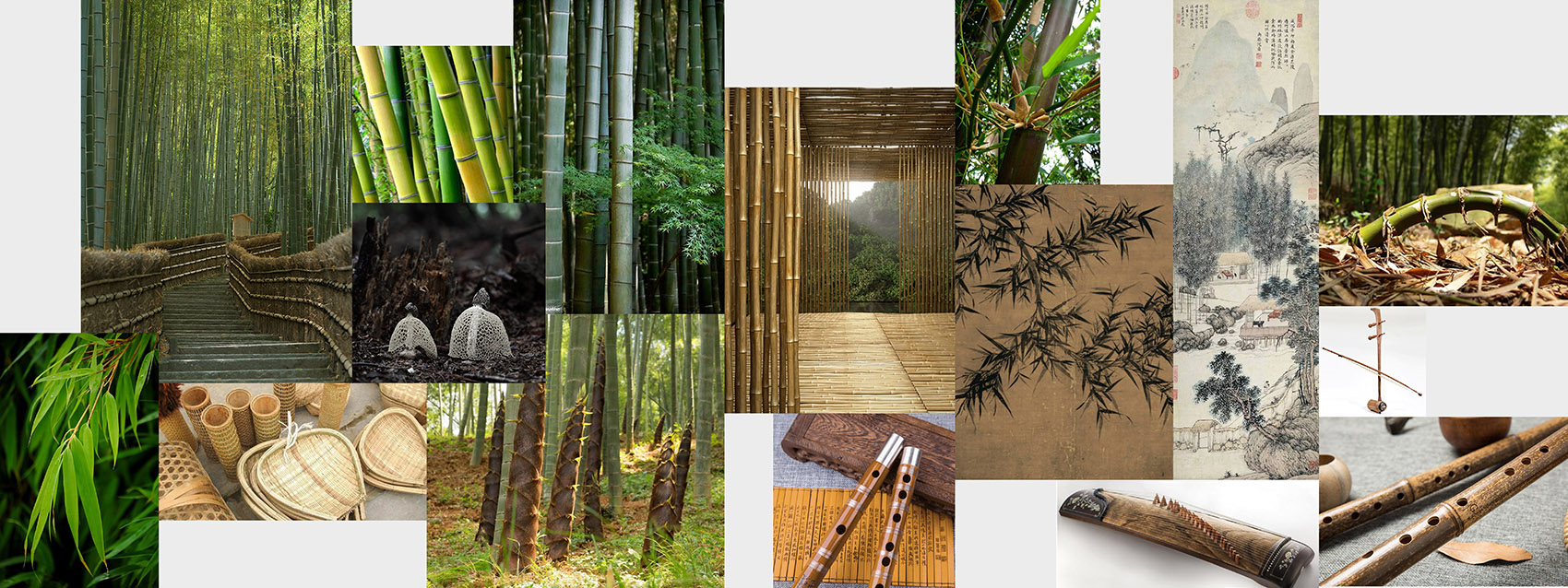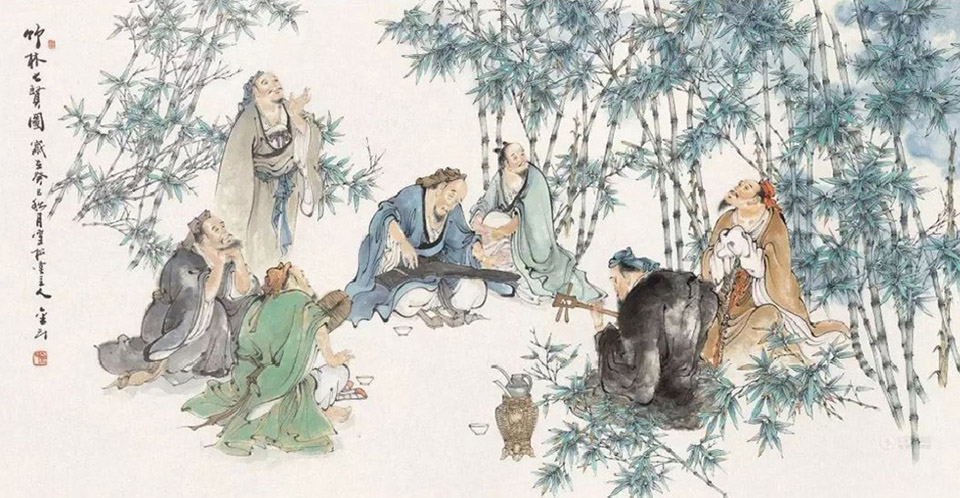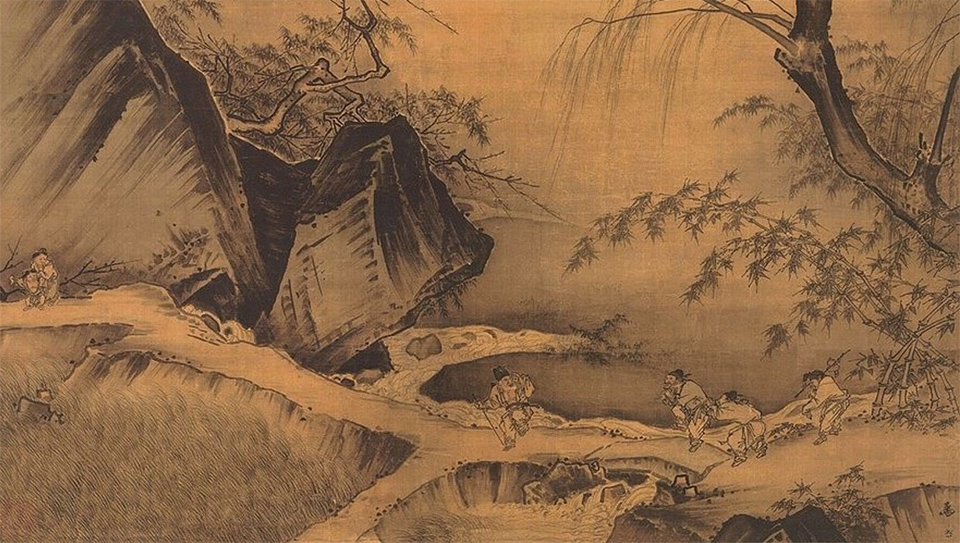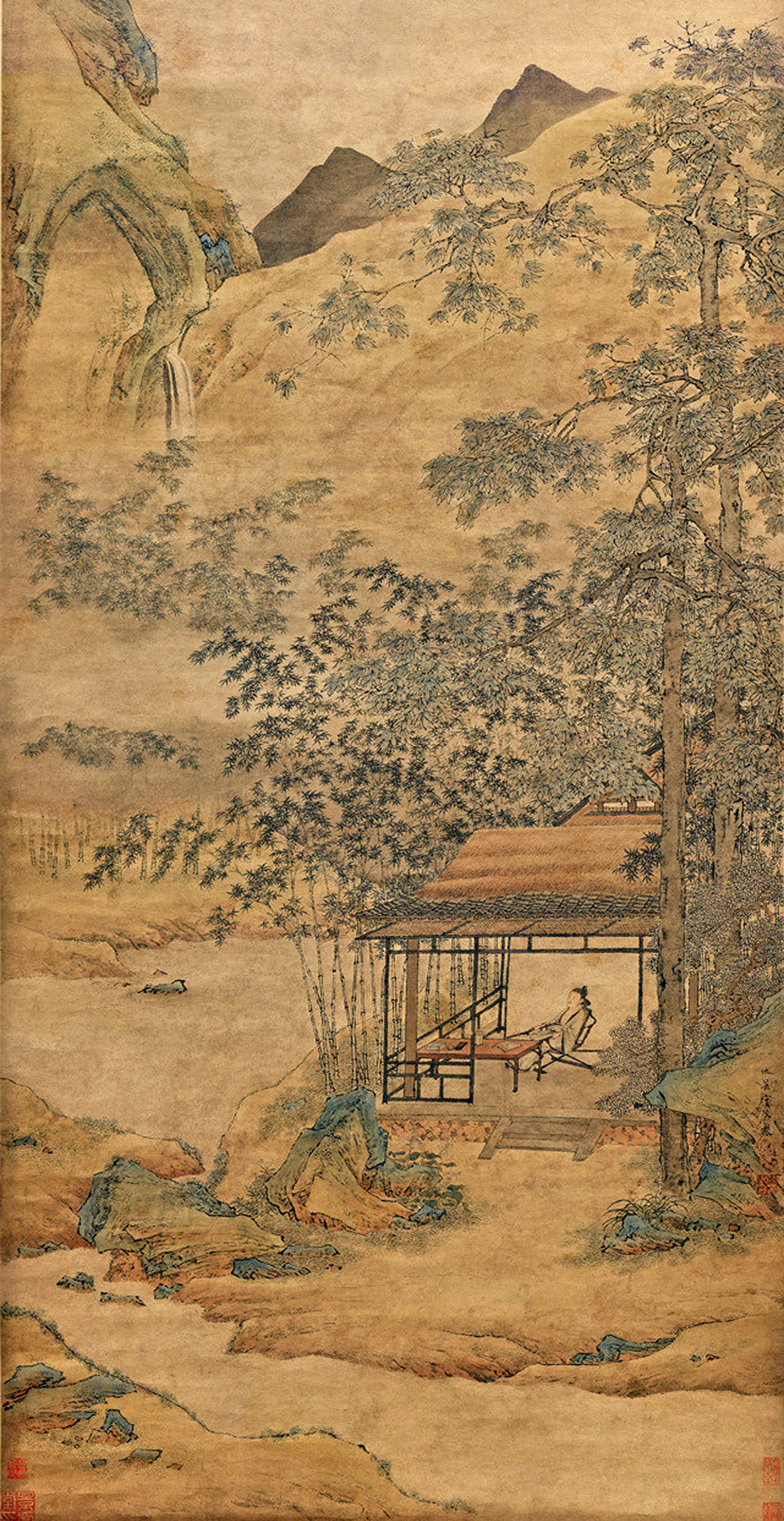意象建筑——中国“天人合一”东方哲学思想的抽象建筑表现形式,是诗意生活的向往和情景再现,是一个先感性后理性的建筑创作过程。从地域文化、自然科学、建筑目的出发,先行想象整体的建筑意境,抽象确立建筑意象,并将其作为核心建筑精神和建筑思想的载体,再以此统领和指导建筑功能、建筑形态、建筑材料的设计,最后选择合适的建筑技术完成建筑建造,使其满足人、自然、建筑三者之间物质与精神的双重需求。
在此,以事务所最新落成的“竹枝书院”项目为例,对“意象建筑论”做一个简单的阐释。
Imagist architecture is an abstract form of architectural expression rooted in ancient Chinese philosophy that seeks harmony between man and nature. Out of longing for a poetic lifestyle and the reproduction of scenes, it is a process of architectural creation that starts with feeling but ends with rationality. Proceeding from the regional culture, natural sciences, and architectural purposes, imagist architecture will start with advance imagination of overall artistic conception, conduct abstract construction of architectural imageries and use them for the core spirit and thought of architecture, and further as the guidance on the architectural function, architecture form and design of construction materials. Finally, proper technology will be chosen so as to satisfy the material and mental needs of man, nature and architecture.
“Imagist architecture” will be illustrated here with “Bamboo Branch Academy,” a project newly completed by Archermit, as an example.
▼竹枝书院鸟瞰,Bamboo Branch Academy aerial view ©存在建筑
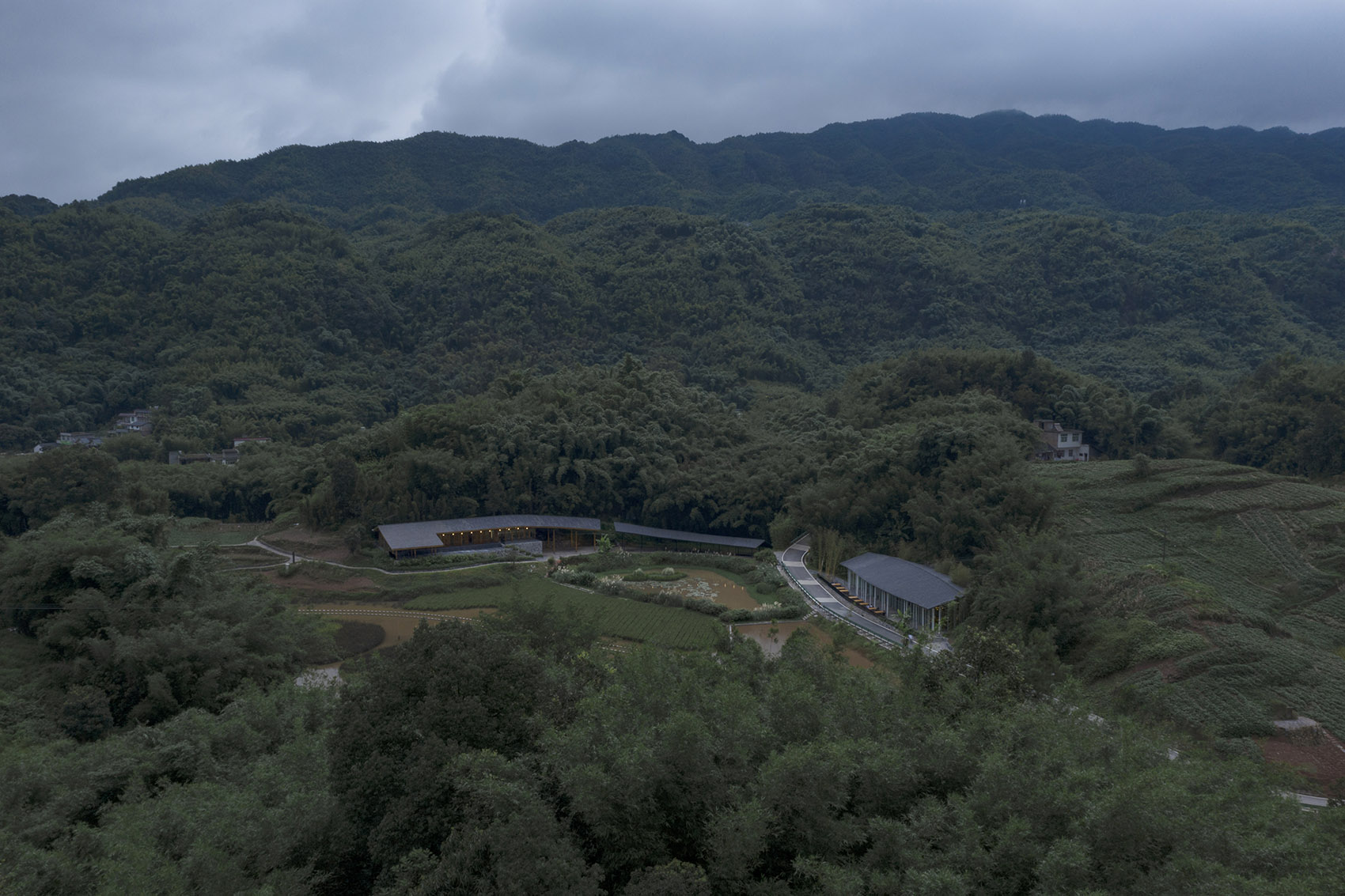
“竹枝书院”位于四川省宜宾市长宁县竹海镇永江村,紧靠著名的蜀南竹海风景区。项目坐落在永江村黄桷滩一个小村落,周围竹林、水田、菜地、山丘环绕,西侧、南侧淯江潺潺而过,北侧蜀南竹海延绵起伏形成一幅层峦叠嶂的绿色巨幕。
“竹枝书院”在中国“乡村振兴”的背景下诞生。“因地制宜发展竹产业,让竹林成为四川美丽乡村的一道风景线”、“宜宾之竹,川南面向世界窗口的生态门户”是其初始的精神层面的建筑目的;竹间乐坊、稻田书院、禅修会馆是其物质层面的建筑目的。
“Bamboo Branch Academy” is located in Yongjiang Village, Zhuhai Town, Changning County, Yibin, Sichuan Province, near the famous Shunan Bamboo Sea Scenic Area. The project, situated in a small village in Huangjuetan, Yongjiang Village, is surrounded by bamboo forests, paddy fields, vegetable fields, and hills. The Yujiang River is babbling in the west and the south, and Shunan Bamboo Sea in the north rolls like a large green screen.
“Bamboo Branch Academy” was developed as China implemented the “rural revitalization” strategy. Mentally, its architectural purpose is to “develop the bamboo industry in accordance with local conditions, and landscape Sichuan villages with bamboo forests” and “make bamboo of Yibin an ecological gateway to introduce southern Sichuan to the world.” Physically, its architectural purpose is to build the Music Workshop under Bamboo, Paddy Field Academy, and Guild Hall for Buddhist Meditation.
▼永江村全景鸟瞰,Yongjiang Village ©小隐建筑
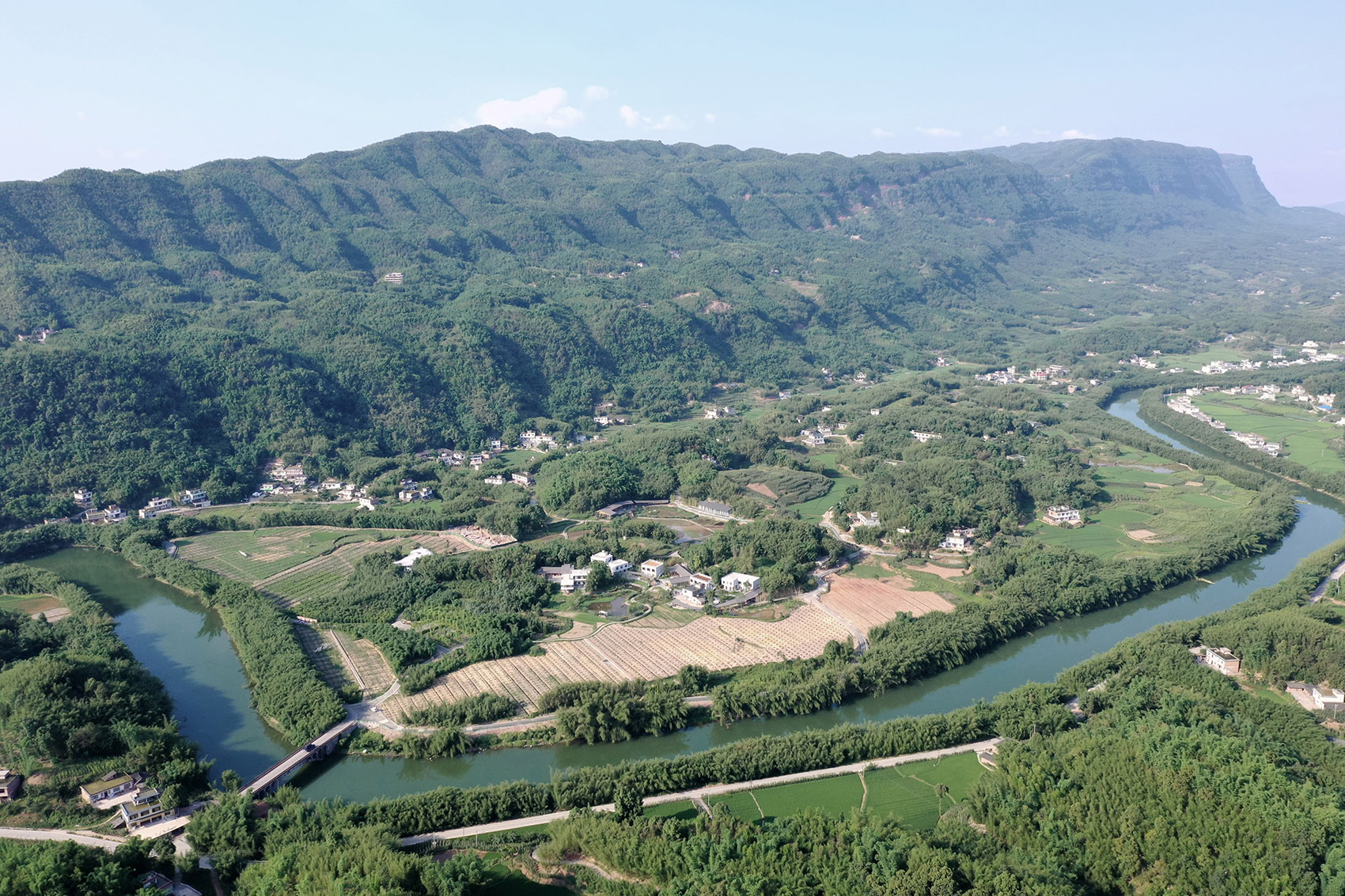
宜宾有万里长江第一城、蜀南竹海、五粮液、戎州、川南印象、李庄古镇、夕佳山民居、旧州塔、僰人……等等众多的地域形象。从大的地域文脉出发,与项目建筑目的直接关联并给团队留下深刻印象的是万里长江第一城、戎州、蜀南竹海这几个形象。
Yibin boasts many regional images such as the first city along the Yangtze River, Shunan Bamboo Sea, Wuliangye, Rongzhou, Southern Sichuan Impression, Lizhuang Ancient Town, Xijiashan Folk House, Jiuzhou Tower, and the Bo People. Considering the cultural panorama and the direct relevance to the architectural purpose, the project team is impressed with the images of the first city along the Yangtze River, Rongzhou, and Shunan Bamboo Sea.
▼宜宾印象,the image of Yibin ©小隐建筑
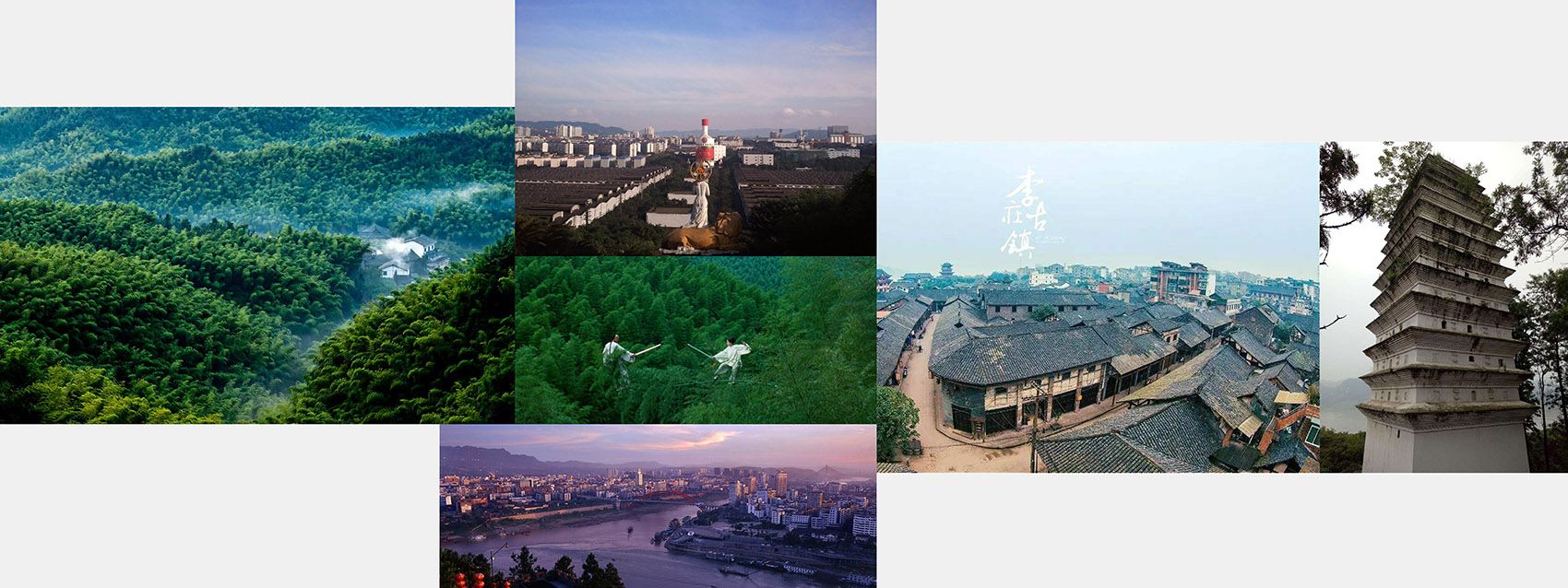
项目建筑精神的核心载体“竹”是中国独具特色的传统文化之一,竹乃君子之化身,竹子中通外直、宁折不屈、卓尔不群、朴实无华、虚怀若谷……的众多形象成为中国古代文人墨客重要的精神文化象征。竹自身的形态——竹根、竹笋、竹叶、竹节、竹枝、竹丛、竹林、竹海……,亦呈现出千姿百态的形象:雨后春笋、竹烟波月、竹影斑驳、曲径通幽、轻柔坚韧……。竹子作为中国日常生活的一种重要材料,衍生出乐器、竹编、家具、农具、医药等等诸多用途。在竹子众多的形象中,建筑意象的抽象确立,还有待进一步的思考、调研。
“Bamboo” is the core carrier of the project’s guiding architectural principles. As an integral part of unique traditional Chinese culture, bamboo is seen as incarnation of junzi (gentleman). Hollow on the inside and straight on the outside, bamboo is considered unyielding, outstanding, unpretentious and modest, and has become an important cultural symbol of ancient Chinese literati. Different parts of the bamboo are related to different images – bamboo roots, bamboo shoots, bamboo leaves, bamboo knots, bamboo branches, bamboo bushes, bamboo forests, and bamboo seas. For example, bamboo shoots after a spring rain are used to describe the emergence of new things in abundance, and the bamboo forest under the moon, the mottled shadows cast by bamboo trees and the winding path through the bamboo forest are used to signify tranquility or fortitude. As a major material used in daily life in China, bamboo has various uses: musical instruments, bamboo weaving, furniture, farm implements, medicine and so on. Among the many images of bamboo, its abstract architectural imagery should be established with further deliberation and investigation.
▼竹之印象,the image of bamboo ©小隐建筑
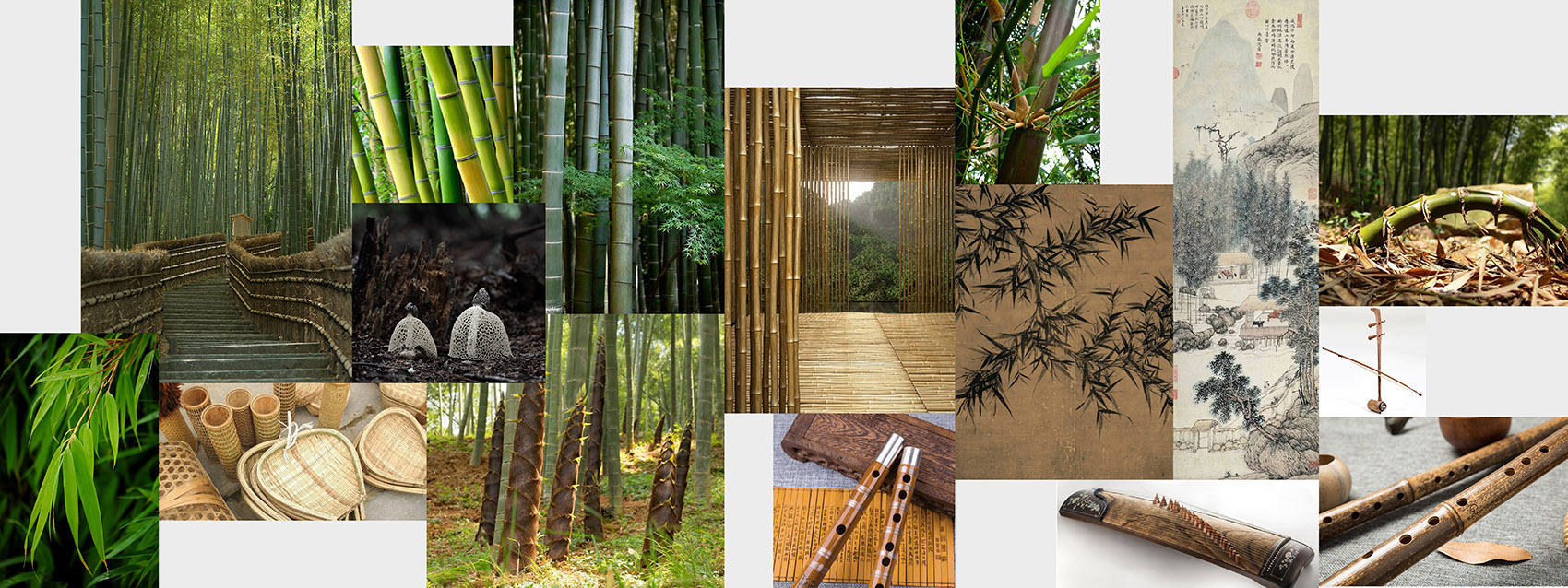
上述这些意象都是我们成长过程中所积累的一些基本认知,这些意象如何与项目结合形成一个整体的、合适的建筑意境?如何满足项目建筑目的?如何体现建筑精神及建筑思想?带着这些疑问,团队进行了三次现场踏勘、调研工作。与项目现场的亲密接触,是众多飘忽的概念形象转化为深刻印象,从而再抽象成为核心建筑意象的必要过程。
第一次到项目现场是二零一九年一月深冬,村子里万物凋零、雨雾弥漫,枯黄水田里嬉戏的鸭子、冲着陌生的我们狂吠的家犬、田间漫步的当地村民,是这里少有的生机。虽有些凋敝但也给人少有的宁静与闲适。
The above-mentioned imageries are known to us as we grow up, but how can they be integrated into the project to form a whole and proper architectural artistic conception? How to meet the architectural purpose of the project? How to embody the guiding architectural principles and ideas? With these questions in mind, the team visited and investigated the site three times. The field visit is a necessary process to transform conceptual images into impressions and abstract the impressions into the core architectural imagery.
The first visit was conducted in the late winter of January 2019. The village was wreathed in mist with all plants withered. Only the ducks playing in the paddy fields, dogs barking at strangers, and villagers strolling in the fields add to its vitality. Though quite bleak and desolate, it brought a rare sense of tranquility and leisure.
▼雨雾弥漫的村子,the village wreathed in mist ©小隐建筑
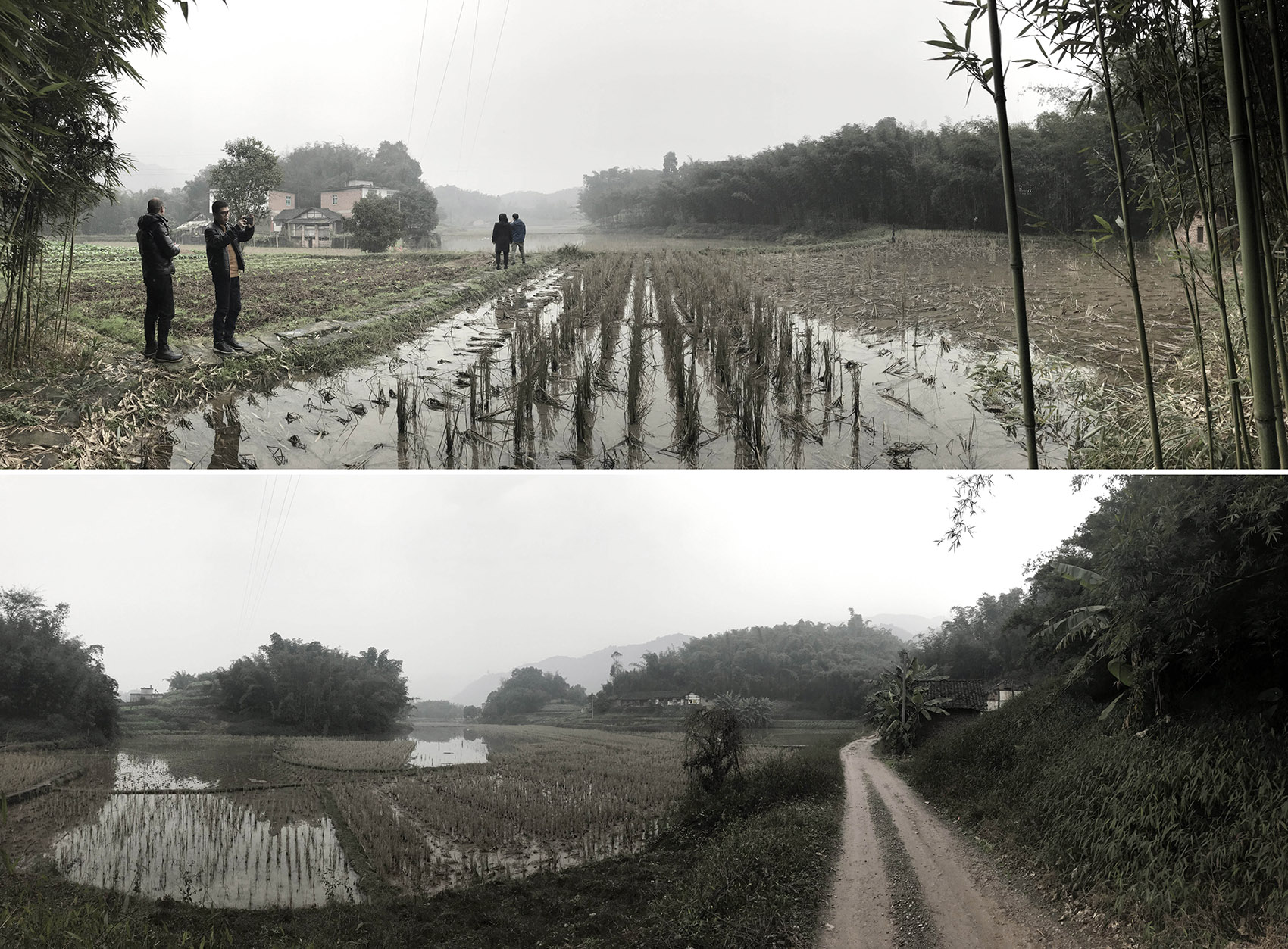
▼漫步的村民和水田里戏水的鸭子,villagers strolling in the fields and the ducks playing in the paddy field ©小隐建筑
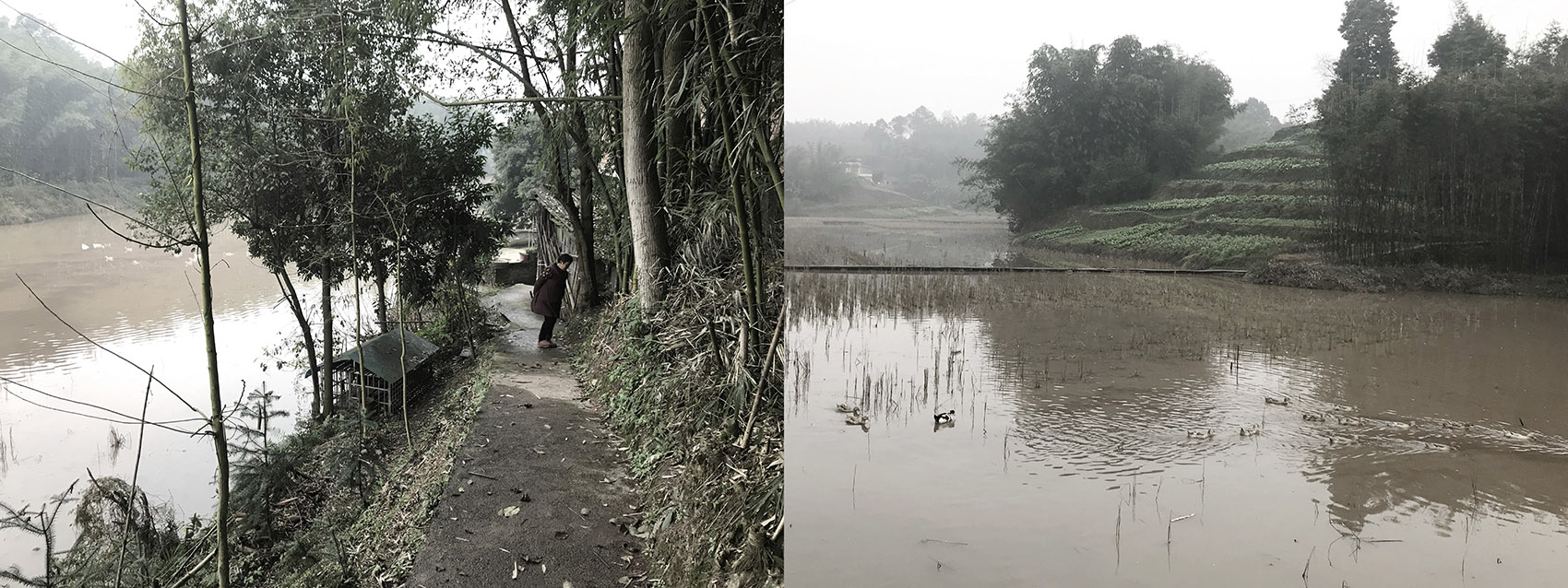
村子的各种形象中,基地周围爬满竹林的小山丘、破败老宅的竹编夹泥墙(竹篾夹生土编制)和小青瓦屋面、老宅旁的芭蕉树都给我们留下了特殊的印象。但这些形象在四川的乡村亦是常见的,很难在记忆中留下深刻的印迹。
We were impressed by the various images here – the bamboo-clad hills around the base, the mud walls covered with bamboo strips surrounding the dilapidated house, the grayish blue tiled roof, and the plantain trees next to the old house. They are common in the countryside of Sichuan, and hardly can leave a deep impression.
▼爬满竹林的山丘、竹编夹泥墙、小青瓦屋面, the bamboo-clad hills, the mud walls and the grayish blue tiled roof ©小隐建筑
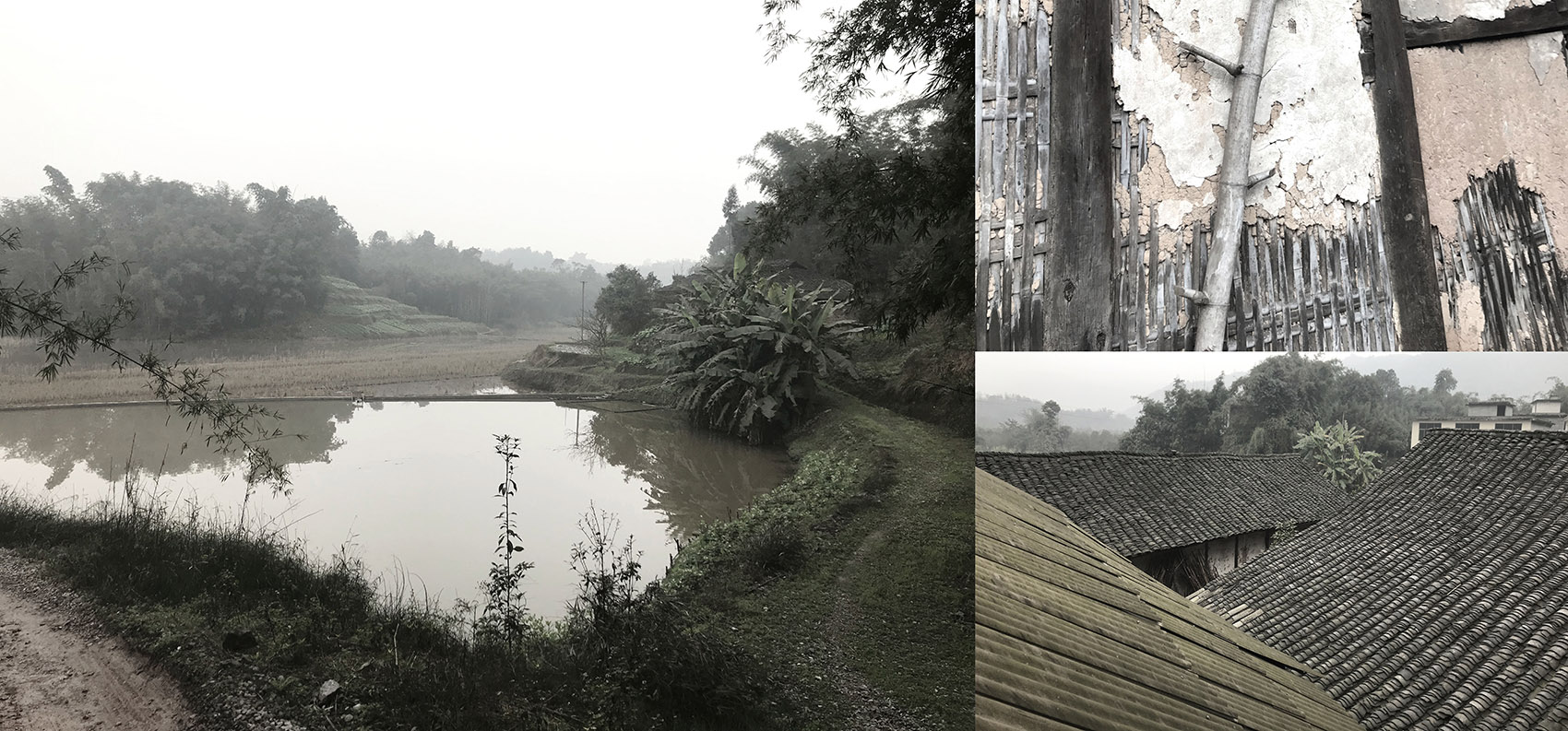
临走时,江边一丛竹林让大家都激动起来,无数新生的竹笋齐刷刷冲破老竹林的遮盖昂首向天,有几根已发出新枝,让人不禁想起张正见的“翠云梢云自结丛,轻花嫩笋欲凌空”。深冬时节得见的这幅景象与之前村子所见形成鲜明的对比,给所有人留下了极其深刻的印象。这个印象不禁让人联想到项目关于“振兴”的主题,“卓尔不群”、“推陈出新”、“新旧共荣”游于脑际。由于下雨的缘故,当天一行人并未到竹林深处一探究竟。
We got excited upon seeing the bamboo forest by the river before leaving. Numerous bamboo shoots thrived with irresistible momentum, rising out of the canopy formed by mature bamboo towards the sky. A few had sprouted, reminding us of a bamboo-themed poem written by Zhang Zhengjian. It was in stark contrast with what we saw back in the village, which impressed us a lot. It reminded us of the motif of the project – “revitalization”, which can be linked up with such words and phrases as “prominence,” “getting rid of the stale and bringing forth the fresh,” and “prosperity of both the new and the old.” We did not go into the depths of the bamboo forest due to the rain.
▼江边的竹林新象,the new rising bamboo forest ©小隐建筑
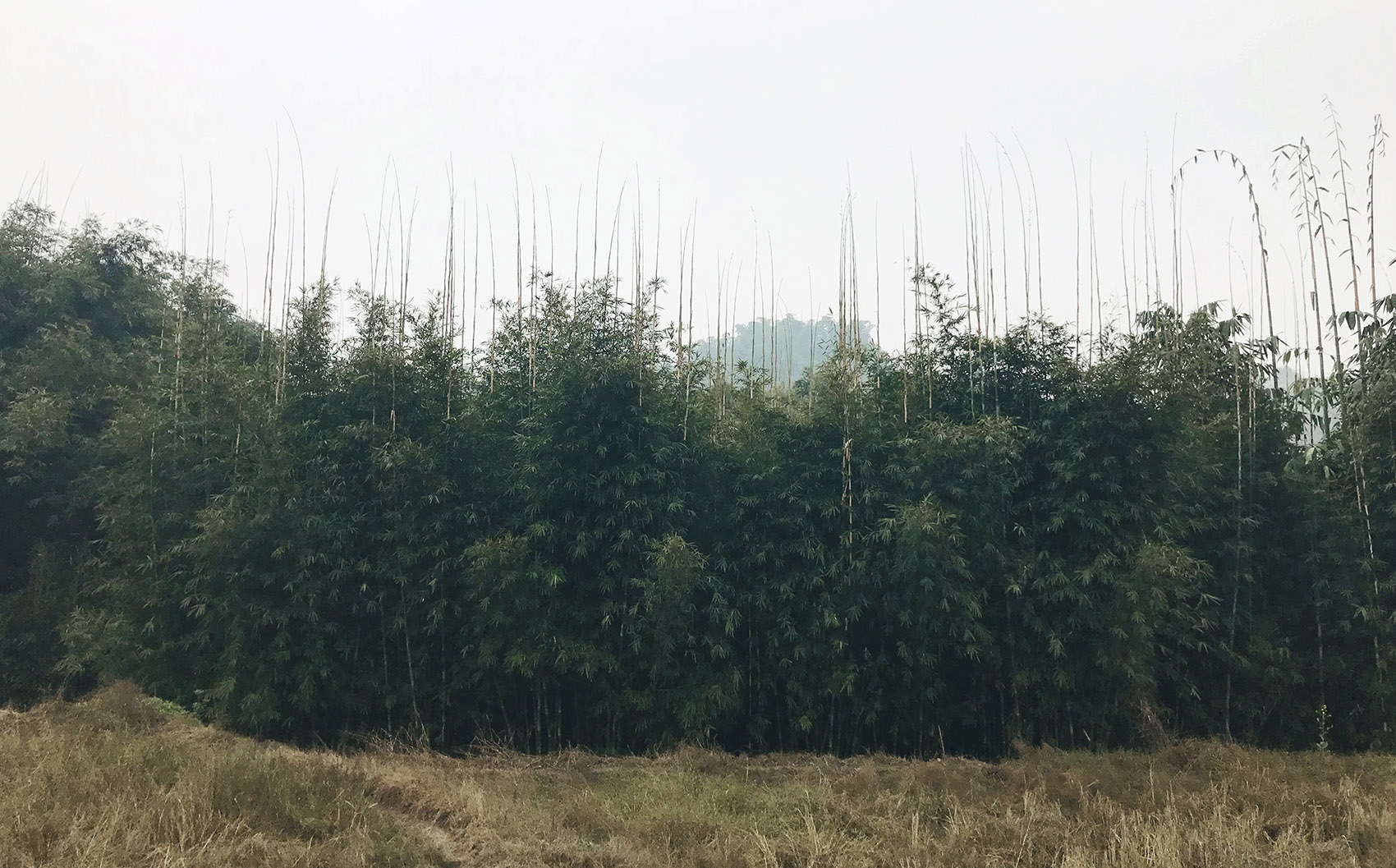
第二次现场探勘是在二月初春,村子四周山丘上的竹林已随处可见“翠云梢云自结丛,轻花嫩笋欲凌空”的景象。
We came here the second time in the early spring of February. The bamboo trees on the hills around the village were about to reach the sky with tender shoots like clusters of green clouds.
▼随处可见的“欲凌空”意象,“ clusters of green clouds” ©小隐建筑
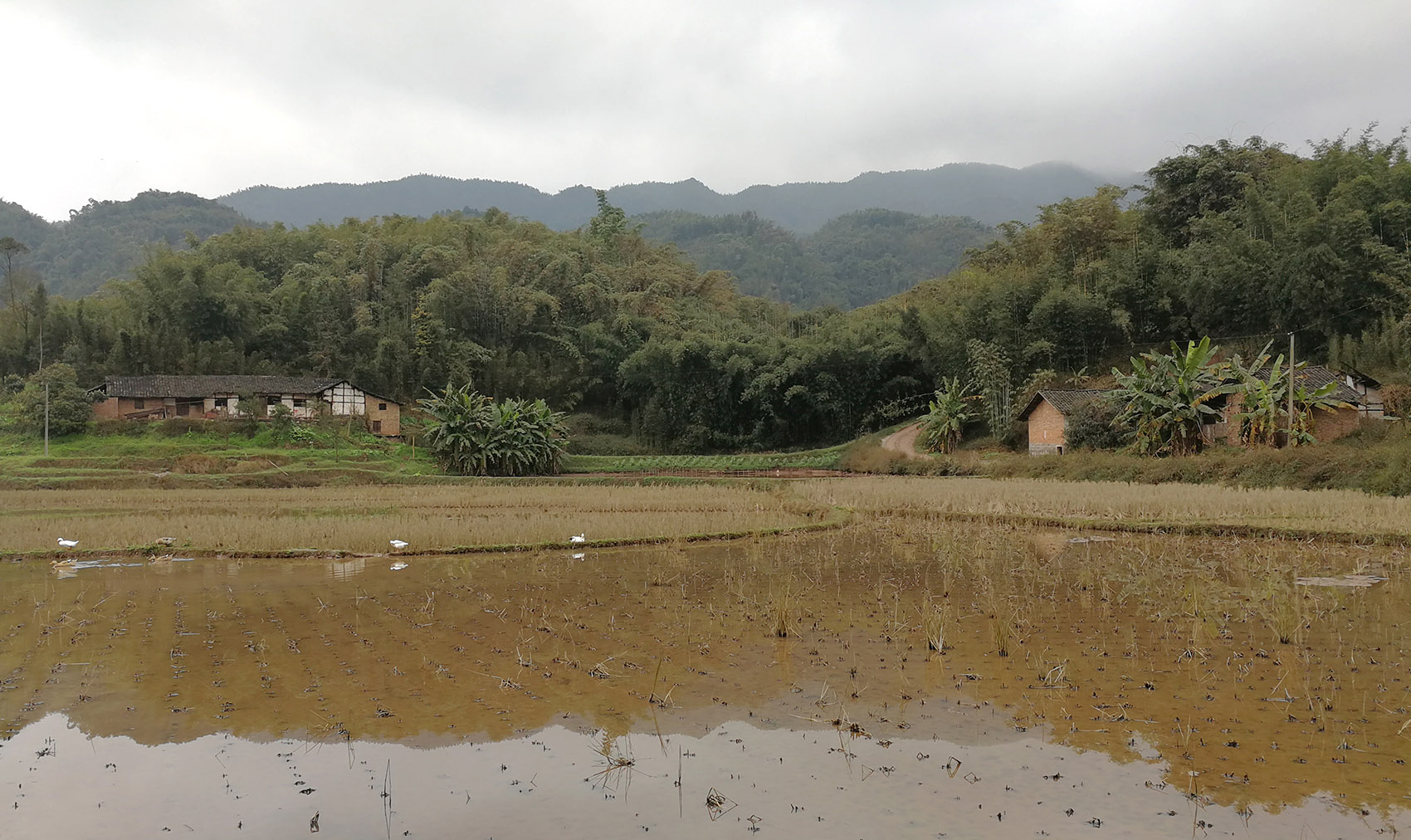
当天风和日丽,是竹林探秘的好时机。“竹影斑驳”、“竹烟波月”、“竹径通幽”这些游离的意识形态得以在现场亲身体验,竹林自然形成的廊、拱、光影、气味、声音都给大家留下了非常深刻的印象。
It was a breezy and sunny day to explore the bamboo forest. We saw first hand the images like “mottled shadows cast by bamboo trees,” “the bamboo forest under the moon,” and “the winding path through the bamboo forest.” We were impressed by the corridors naturally formed by bamboo trees, and their light and shadow, smell and sound.
▼竹影斑驳、竹径通幽,the winding path through the bamboo forest in the mottled shadows cast by bamboo trees ©小隐建筑
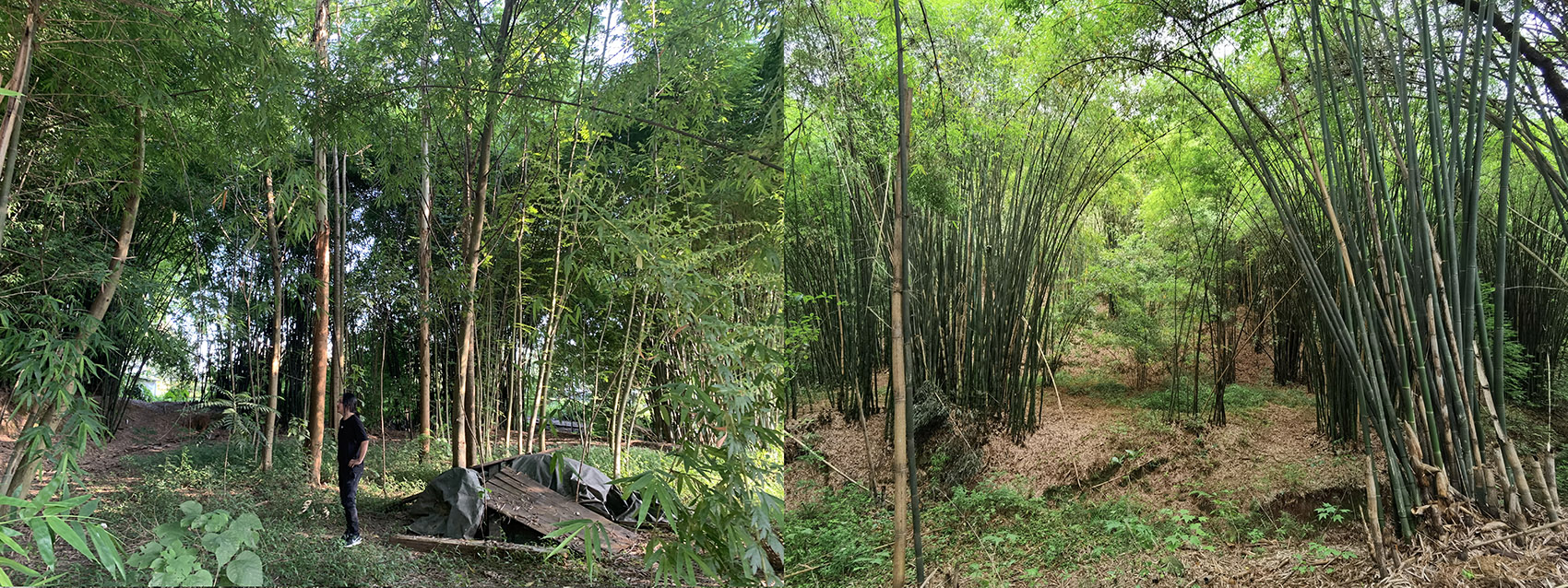
▼竹廊、竹拱,bamboo corridors and arches ©小隐建筑
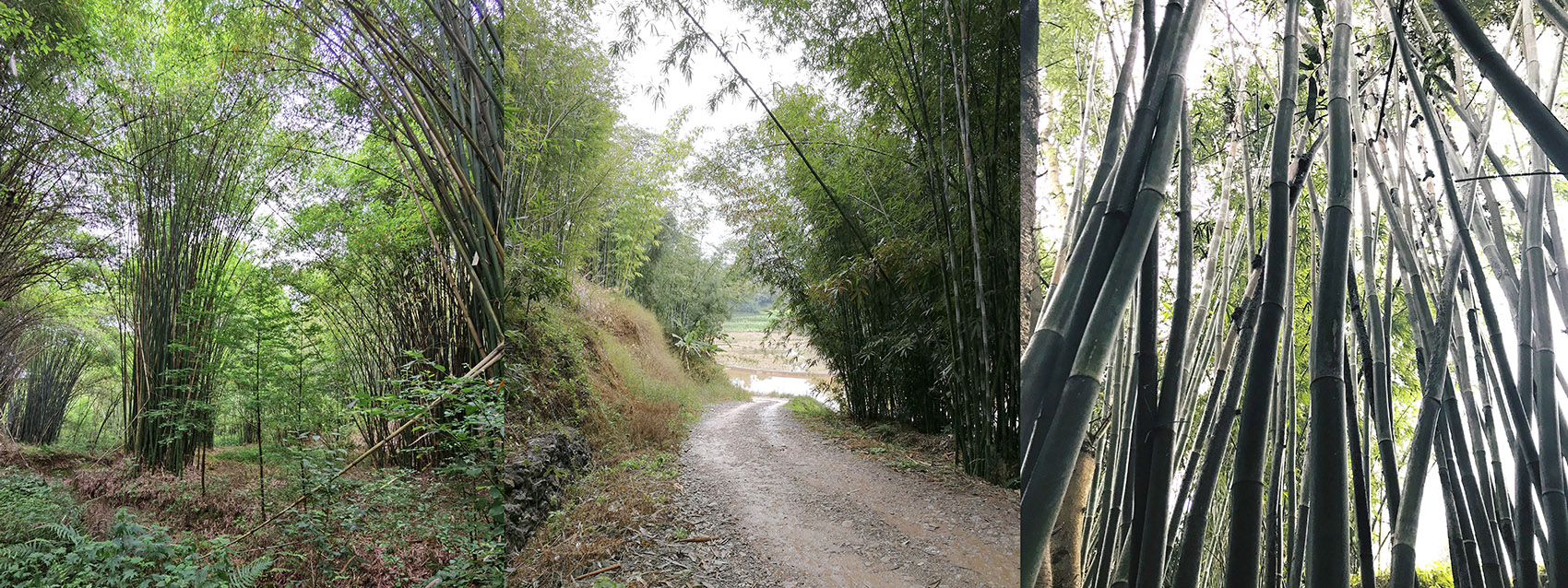
两次现场探勘获得的这些印象将会成为整个项目建筑意境营造的直接来源,这些形象亦将抽象成为整个项目的核心建筑意象,统领和指导后续的建筑创作工作。
The impressions from the two visits will become the direct source of the architectural artistic conception of the project. These images will be abstracted into the core imagery as guidance for future creation.
▼书院竹林意象,the Bamboo Branch Academy ©存在建筑
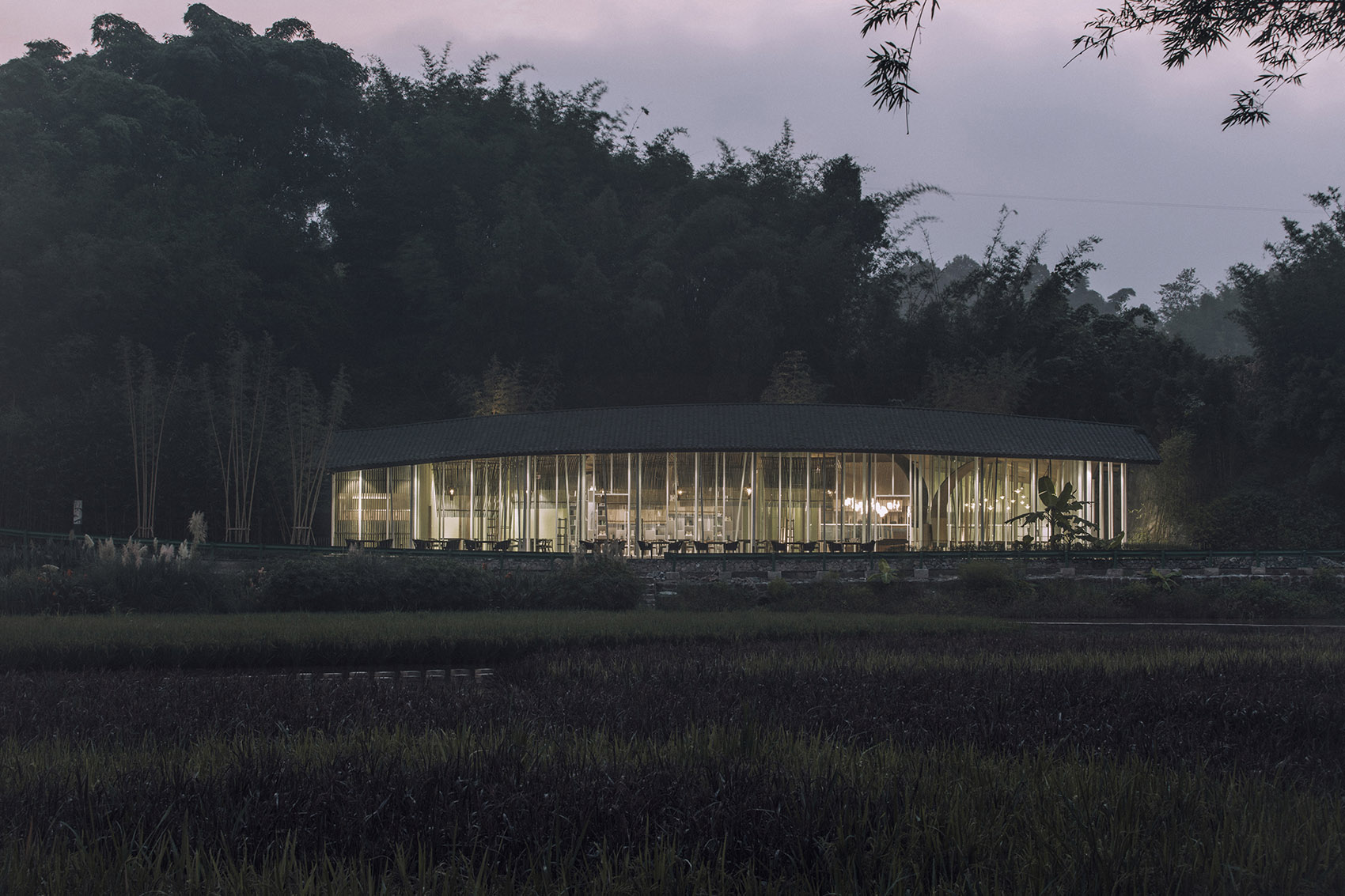
现场探勘之后,如何将现场获得的这些概念意象与建筑目的、竹文化、地域文化合理巧妙的融合,并抽象获得核心建筑意象,成为这一阶段的主要工作。项目物质层面的建筑目的:竹间乐坊、稻田书院、禅修会馆与竹文化如何结合是思考的重点。有没有一种竹的意象是可以同时融合乐坊、书院、禅修这三者关系的呢?中国古时称音乐为“丝竹”,中国传统乐器如笛、箫、笙、筝、二胡……等皆离不开竹。而中国古典音乐与诗歌联系紧密,中国古代以入乐与否,区分歌与诗,入乐为歌,不入乐为诗。诗从歌中分化而来,为语言艺术,而歌则是一种历史久远的音乐文学。
The major tasks after the field visit include the fusion of the conceptional images from the site with the architectural purpose, bamboo culture and local culture in an ingenious way, and the abstraction of the core architectural imagery. The architectural purpose in the physical sense is to build the Music Workshop under Bamboo, Paddy Field Academy, and Guild Hall for Buddhist Meditation in conjunction with the bamboo culture. Is there any bamboo imagery that can simultaneously integrate the workshop, academy, and meditation? In ancient China, music was called “Sizhu”, and traditional Chinese musical instruments such as flute, xiao, sheng, zheng and erhu are all made of bamboo. Chinese classical music is closely related to poetry. Songs were distinguished from poems in ancient China as the former was accompanied by music and the latter was not. Poems, a linguistic art, were derived from songs that fall under the musical literature with a long history.
▼竹林七乐意象,seven sages of the bamboo grove ©靳金斗-竹林七贤
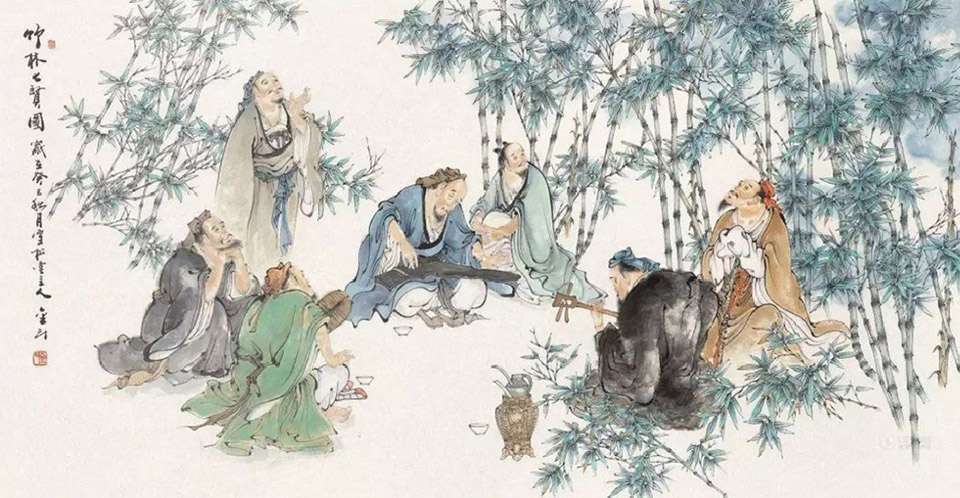
中国书院的萌芽可以追溯到汉代,最初是文人雅士聚集生徒、私家讲学之所,后发展成为讲学、辩论、研学、藏书的场所,是众多文人雅士集聚之地。中国古代书籍竹简更是与竹密不可分。
The emergence of Chinese academies can be traced back to the Han Dynasty. They were places where literati and scholars gathered for giving lectures at first, and later developed into venues for lectures, debates, research, and collection of books. The books in ancient China were made of bamboo slips.
▼竹林书院意象,Chinese academy in the forest ©仇英-竹林七贤
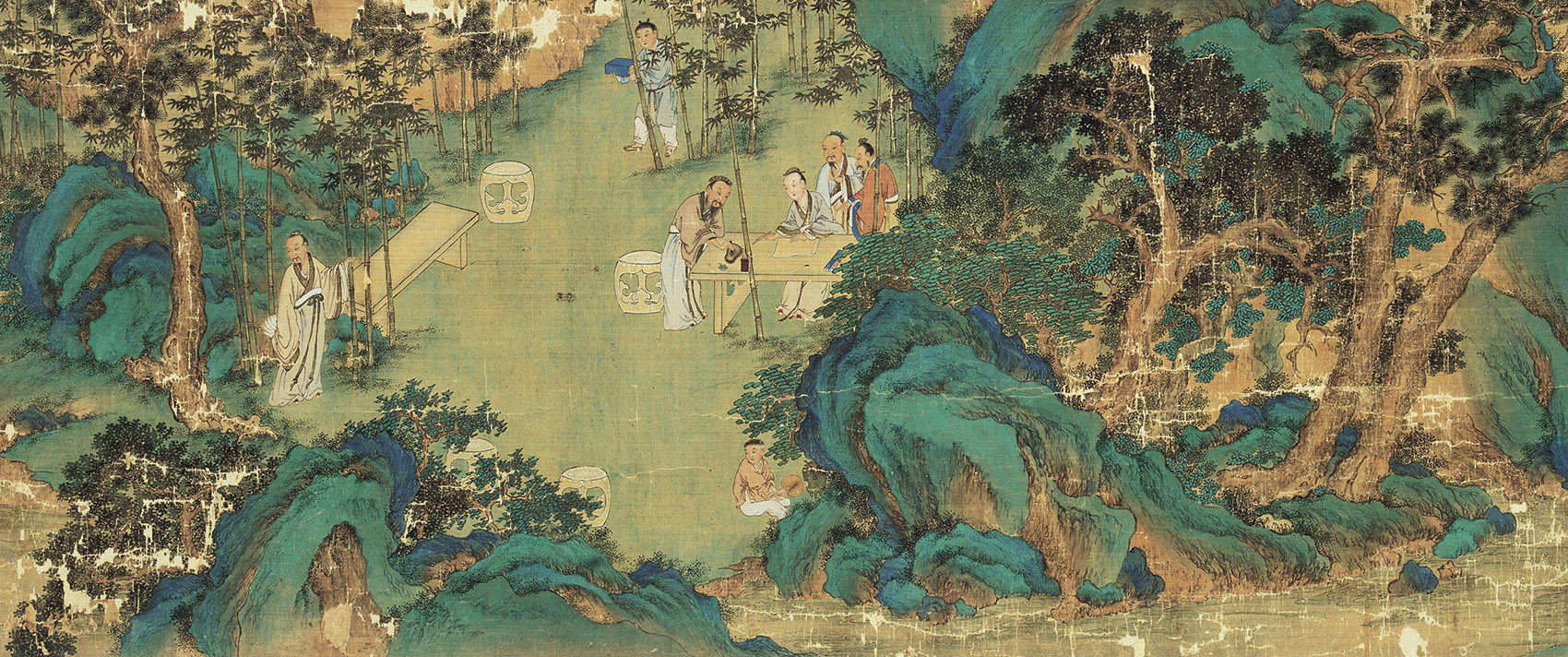
禅修广泛来讲是一种静心、修身、养性的方法,其功能与乐坊、书院有着极强的融合性。经过大量与之相关资讯的梳理、归纳、联想、论证,“竹枝”最终成为项目的核心建筑意象。
Meditation is generally a method of promoting peace of mind and self-cultivation, and highly compatible with music workshops and academies in terms of function. By sorting out, summarizing, associating, and demonstrating related information, we have established “bamboo branches” as the core architectural imagery of the project.
▼书院竹影、竹径、竹廊意象,night view of the academy, the bamboo path and the bamboo corridor ©存在建筑
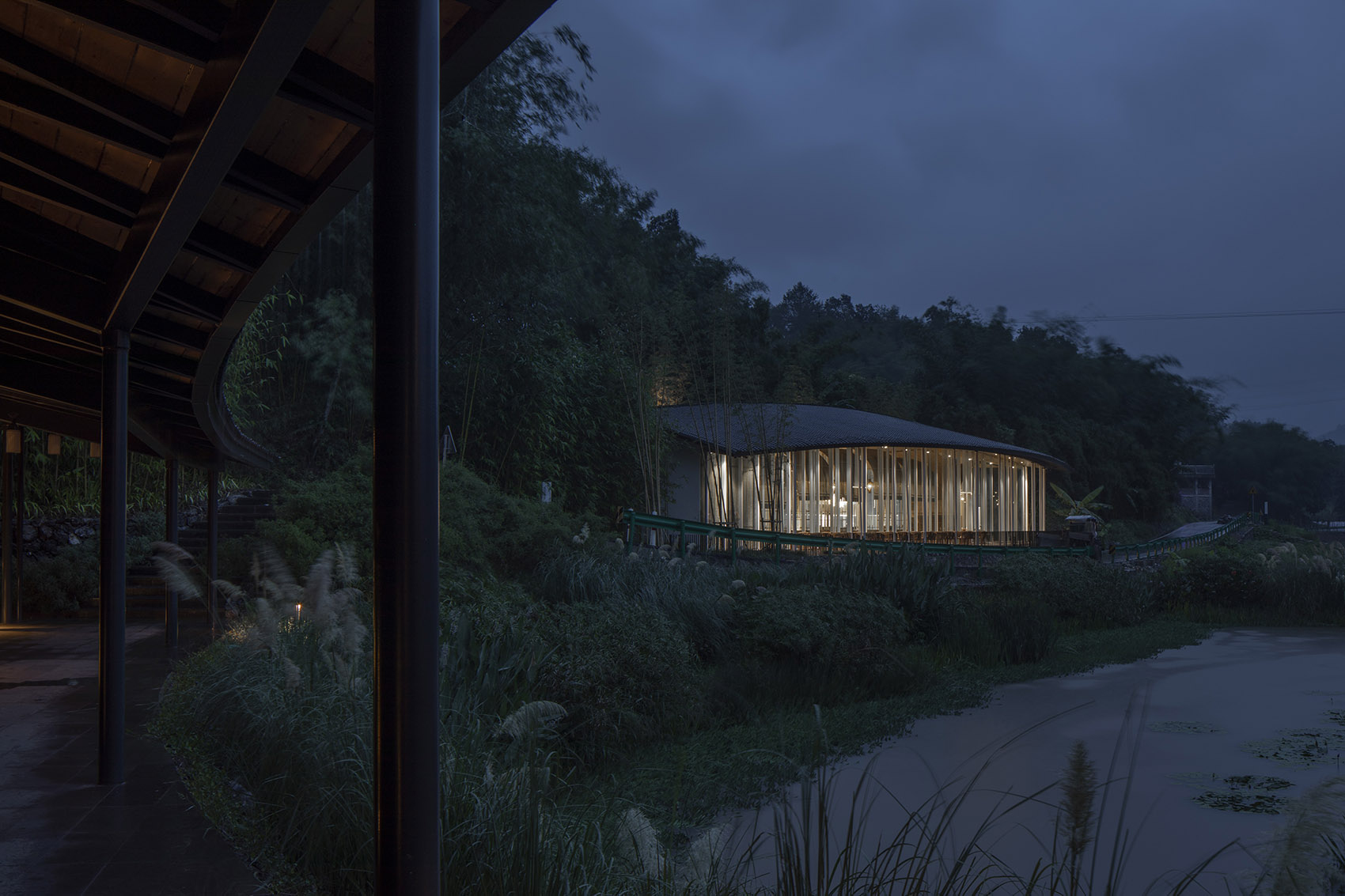
竹枝——词牌名,乐府《近代曲》之一,古巴渝地区民歌演变而来,唐代诗人刘禹锡任夔(kuí)州刺史时,依调填词,据以改作新词,吟咏节物风光、民风习俗为其主要特色。唱时,以笛、鼓伴奏,同时起舞。夔州(今重庆奉节)为唐代川东地区的政治、经济、文化和军事中心;戎州(今宜宾)为唐代川南地区重镇,万里长江第一城。戎州与夔州以长江相连,两地联系紧密,自古就有“巴山蜀水”之美誉,两地自古亦是众多文人墨客游历之地,李白、杜甫、白居易、刘禹锡、苏轼、黄庭坚……等等,描写两地山水人文的著名诗词不计其数。
Zhuzhi (bamboo branch) is the name of a tune and one of the Yuefu poems. It evolved from the folk songs in the ancient Ba and Yu areas. Li Yuxi, a poet in the Tang Dynasty, composed a poem for the tune when he served as the prefectural governor of Kuizhou to depict the climate, natural phenomena and customs. It was performed by the singer with dancers accompanied by flute and drum. Kuizhou (now Fengjie, Chongqing) was the political, economic, cultural, and military center of eastern Sichuan in the Tang Dynasty. Rongzhou (now Yibin) was a place of strategic importance in southern Sichuan in the Tang Dynasty and the first city along the Yangtze River. Rongzhou and Kuizhou are so closely connected by the Yangtze River geographically and culturally that the “mountains of Ba and waters of Shu” have enjoyed a reputation since ancient times. Many literati and scholars traveled here, such as Li Bai, Du Fu, Bai Juyi, Liu Yuxi, Su Shi, and Huang Tingjian, and wrote countless poems about this region.
▼唐代时期戎州与夔州, Rongzhou and Kuizhou in Tang Dynasty ©小隐建筑

竹枝作为民歌与乐坊有着密切的关联,作为诗词亦与书院联系紧密。竹枝既是竹的重要构成元素,更是中国传统文学不可或缺的一部分。竹枝具象和抽象的意象与建筑目的(乐坊、书院、禅修)以及现场探勘时“翠云梢云自结丛,轻花嫩笋欲凌空”那种极其深刻的印象三者不谋而合,“竹枝书院”之名应运而生。
Zhuzhi is closely related to the music workshop as the folk song, and to the academy as the poem. Bamboo branches are important not only to bamboo itself, but also to traditional Chinese literature. The concrete and abstract imageries of bamboo branches coincided with the architectural purpose (music workshop, academy and meditation) and the scene that “the bamboo trees on the hills around the village were about to reach the sky with tender shoots like clusters of green clouds” greatly impressed us.
▼竹枝书院与竹林、山丘、稻田的共荣,the Bamboo Branch Academy coexists with the surrounding forest and fields ©存在建筑
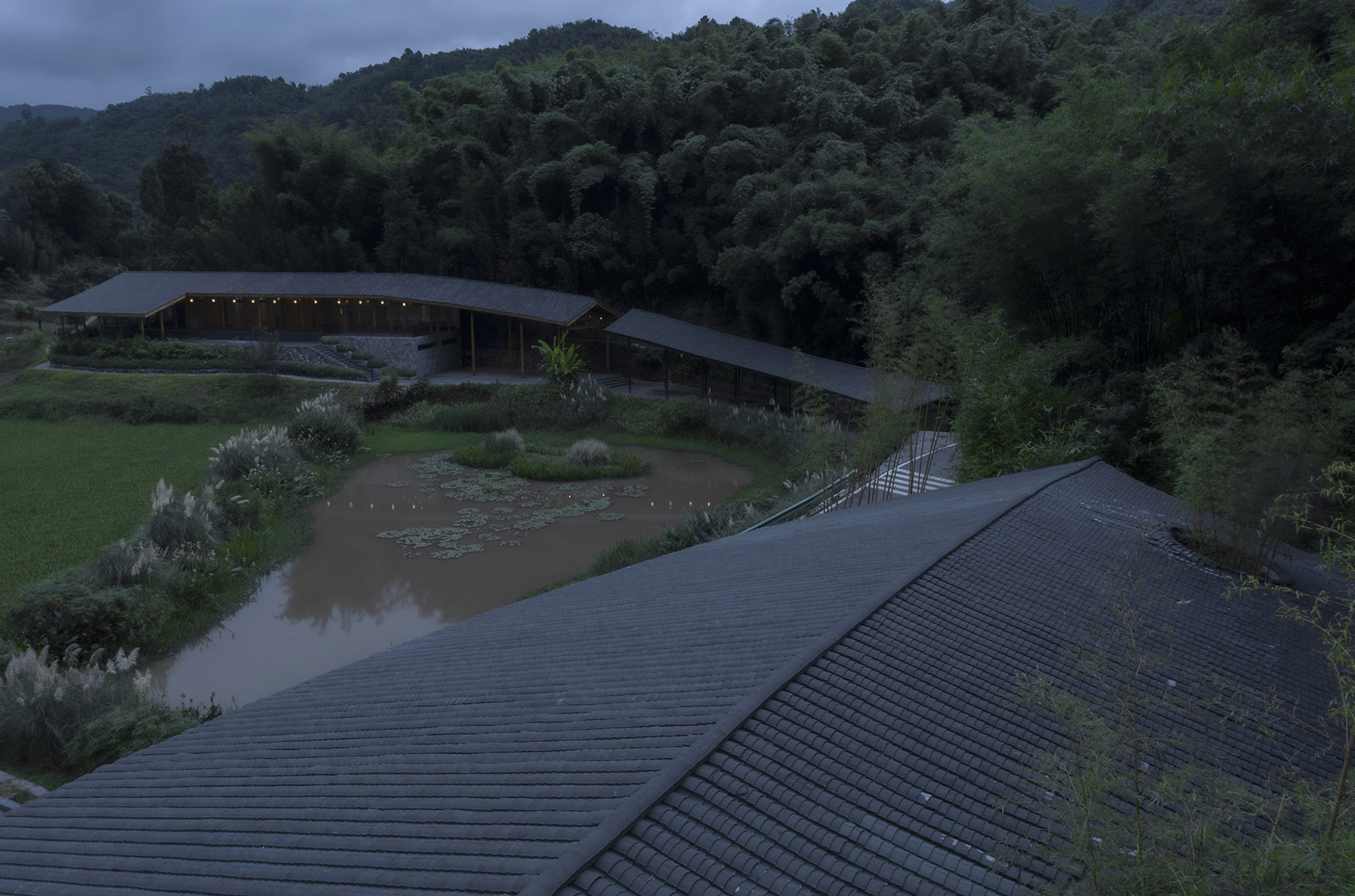
竹枝作为源自唐代的古诗体,多是对田园生活真实生动的记录描写,带有浓郁的地域特色,洋溢着鲜活的文化个性和浓厚的乡土气息,对于社会文化和人文地理等领域的历史研究,具有极为重要的史料价值。而如今知道竹枝这种诗体的人屈指可数,这也是团队毅然采用”竹枝”作为建筑意象的另一个重要原因。
As a poetic style deriving from the Tang Dynasty and a vivid description of pastoral life with distinct regional characteristics, cultural personality and rich local flavor, Zhuzhi is of great historical value to the research on social culture, geography and other fields. The fact that few people know about Zhuzhi currently is another important reason why the team chose it as the architectural imagery.
▼竹枝书院乡土氛围,a rich local flavor ©存在建筑

竹枝这个核心建筑意象,即竹枝书院建筑精神的意象表达,具有极强的象征意义。而建筑具体形象的表现,当由竹枝这个形象衍生的通象来承载。现场踏勘及前期调研所获取的那些零碎意象:竹节、竹丛、竹影斑驳、竹径通幽、竹烟波月、芭蕉、小青瓦屋面、爬满竹林的小山丘……此时既可由这个建筑精神有机的组合在一起,成为营造建筑意境的基石。
Zhuzhi as the core architectural imagery represents the guiding architectural principles of Bamboo Branch Academy with great symbolic significance. The concrete image of the architecture should be expressed with the synaesthetic image deriving from Zhuzhi or bamboo branches. The fragmentary imageries obtained from the field visits and preliminary investigations including bamboo knots, bamboo groves, mottled shadows cast by bamboo trees, paths flanked by bamboo, bamboo under the moon, plantain trees, grayish blue tiled roof and hills covered with bamboo forests can be integrated by the guiding architectural principles organically and function as the cornerstone for creating a proper architectural artistic conception.
▼雨雾中的竹枝书院,the Bamboo Branch Academy in the mist ©存在建筑
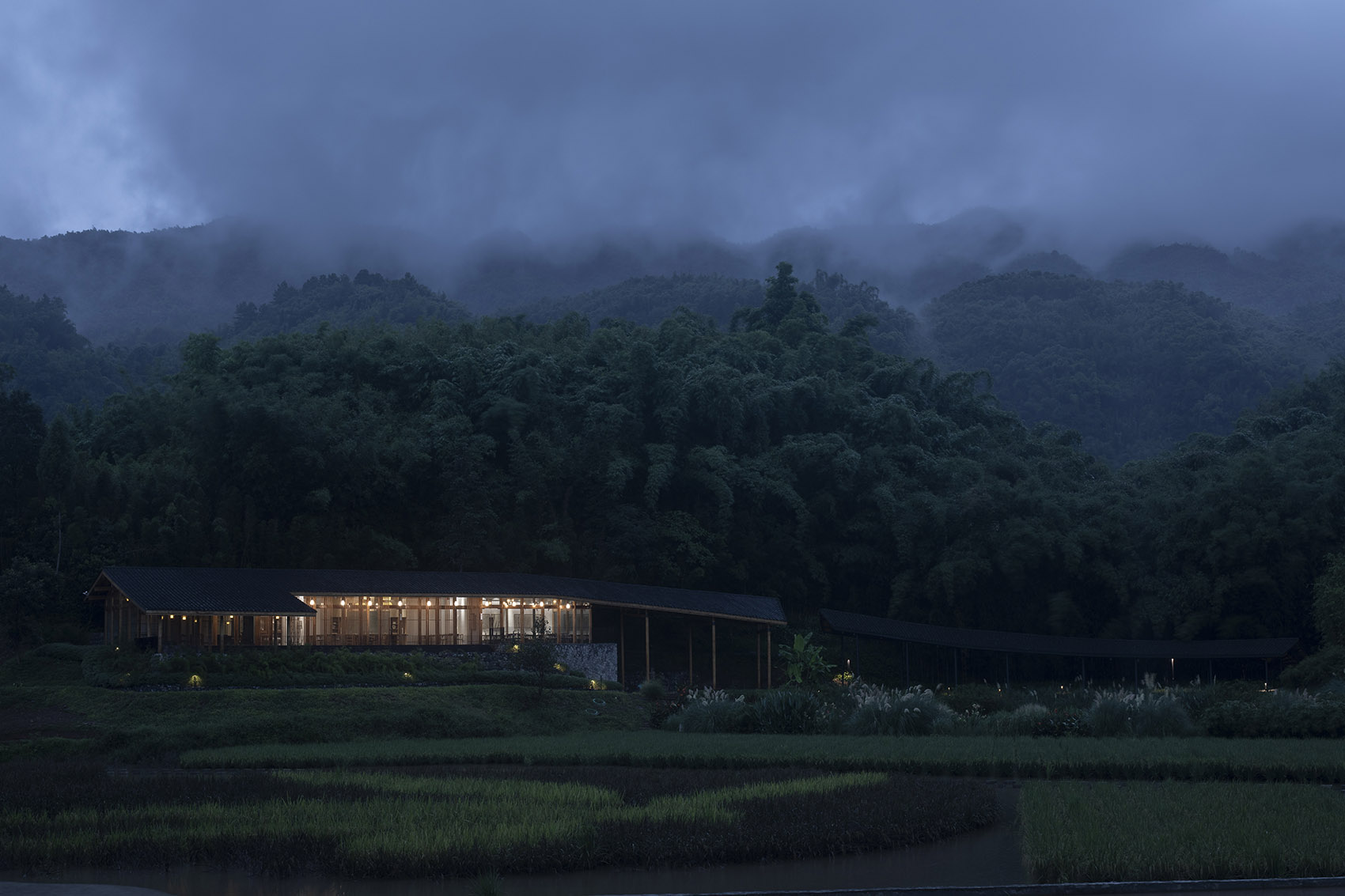
▼夜幕下的竹枝书院,night view ©存在建筑
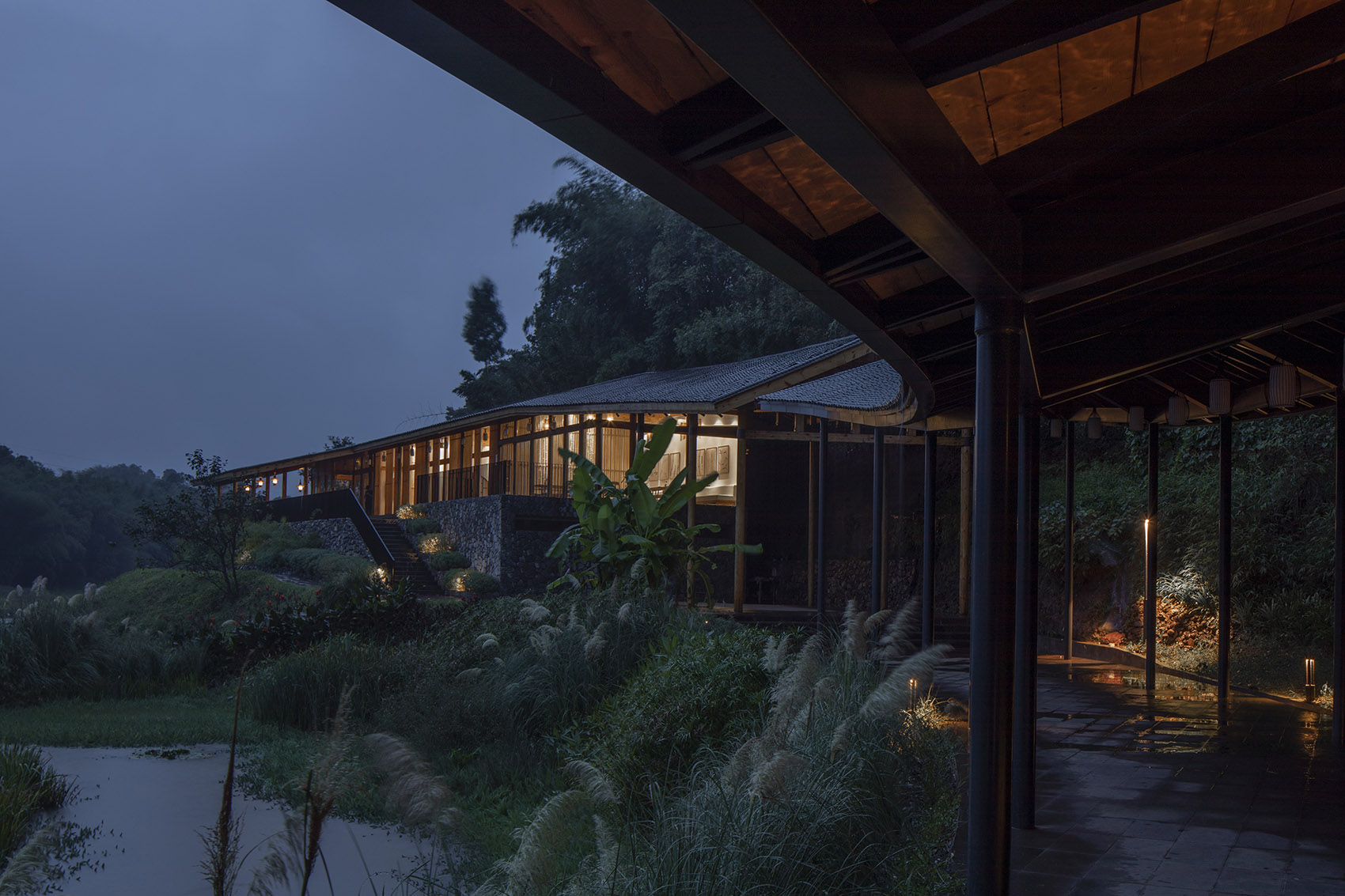
川南地区有着浓郁的竹林村落传统人居文化,“一田一房一院”是其典型格局,房前屋后必有竹林相伴。牟巘(yǎn)五的《题水竹居》“绕屋清波隔翠绡,鱼鳞发发鸟悠清。画阑影漾清涟动,书几阴来绿雨摇。”几乎是项目整体建筑意境的真实写照。
People in southern Sichuan live in villages built with and surrounded by bamboo traditionally, as characterized by “one house with one patch of farmland and one courtyard.” Mou Yanwu’s Written while Living near Water and Bamboo offers a prime example. By its barrage of beautiful imagery—such as a cabin encircled by clear water, green chiffon, vibrant fish and birds, the reflection of a balustrade on the rippling water, a small writing desk, a gentle green drizzle— the poem truly portrays the project’s architectural concept.
▼一田一房一院意象 ©仇英-梧竹书堂图局部 “one house with one patch of farmland and one courtyard”
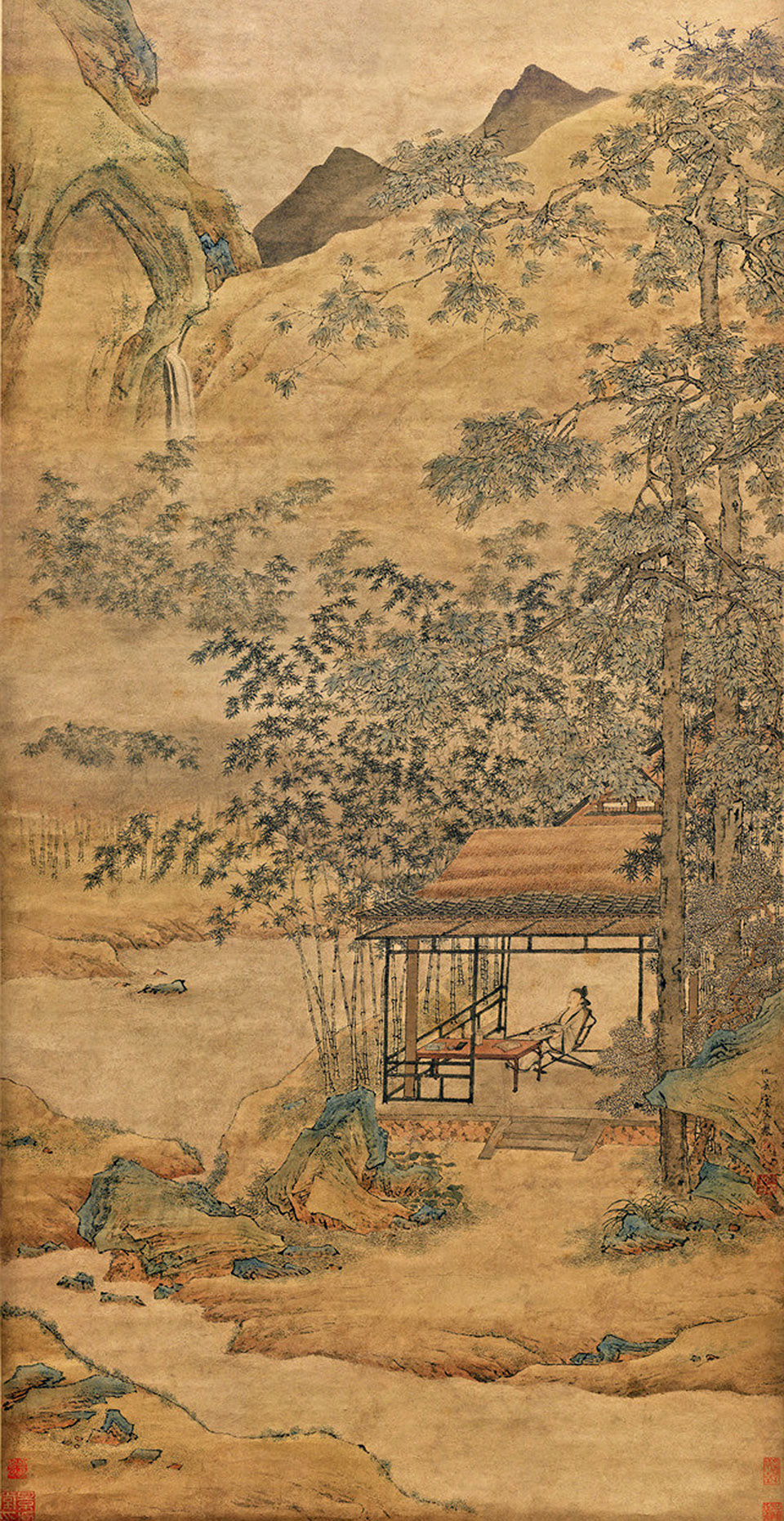
“绕屋”即延绵起伏的建筑形态,“画阑影漾”即变化丰富的檐廊,“书几”即是对书院功能的刻画;“隔翠绡、鸟悠清、清涟动、绿雨摇”更是建筑与竹林、飞鸟、水田、细雨等自然环境完美融合的生动描绘。
The “cabin encircled by clear water” is a metaphor for the rolling architectural form, “the reflection of a balustrade on the rippling water” indicates the ever-changing eaves galleries, and the “small writing desk” the function of the academy; the “green chiffon, vibrant birds, reflection of a balustrade on the rippling water and a gentle green drizzle” vividly depicts a tiny world where architecture is in perfect harmony with nature, which is represented by bamboo forests, flying birds, rice paddies, and the light rain.
▼绕屋之象,the cabin encircled by clear water ©存在建筑

▼书院檐廊,the covered gallery ©存在建筑
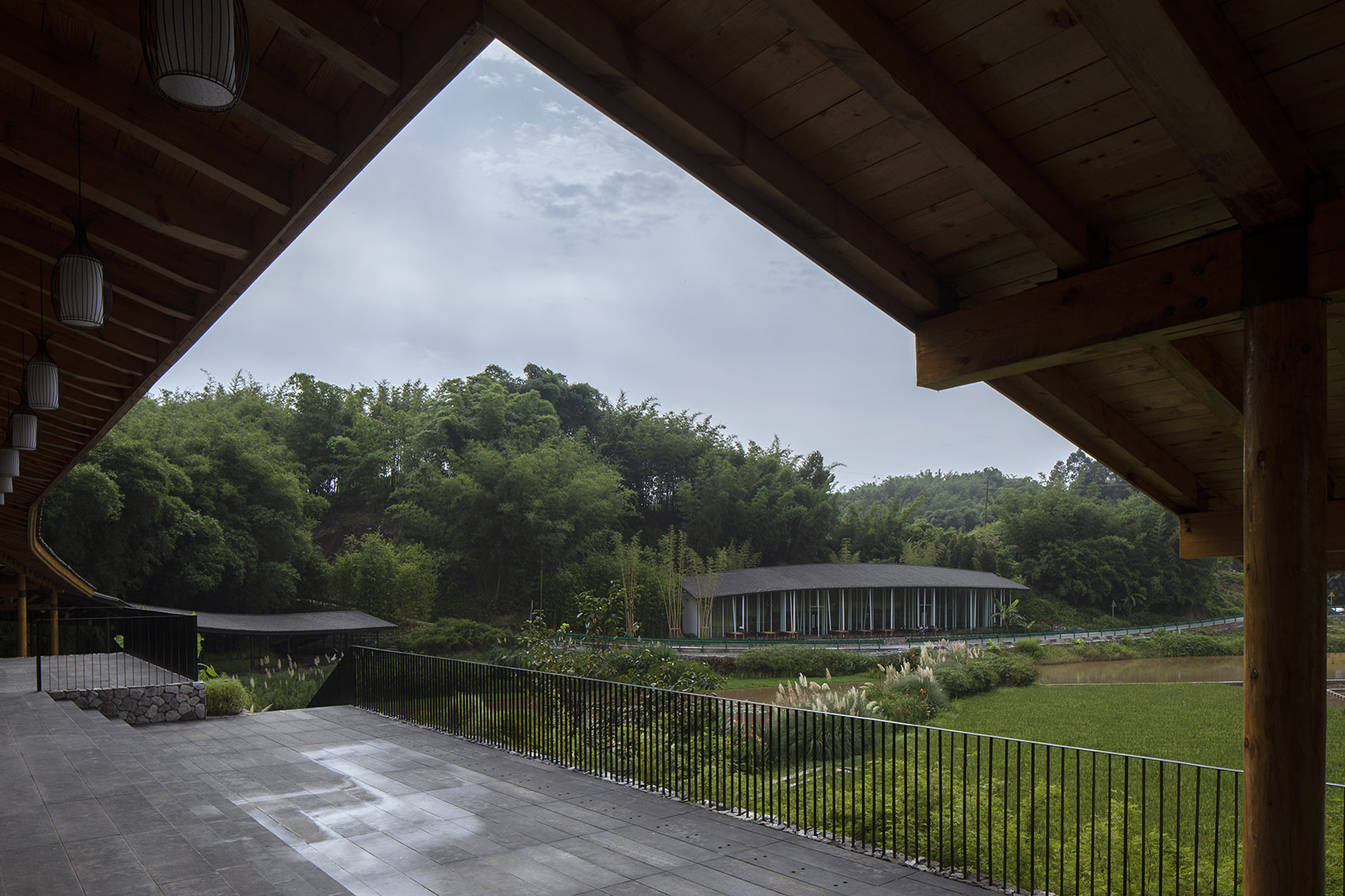
▼雨中书院,the academy in the rain ©存在建筑
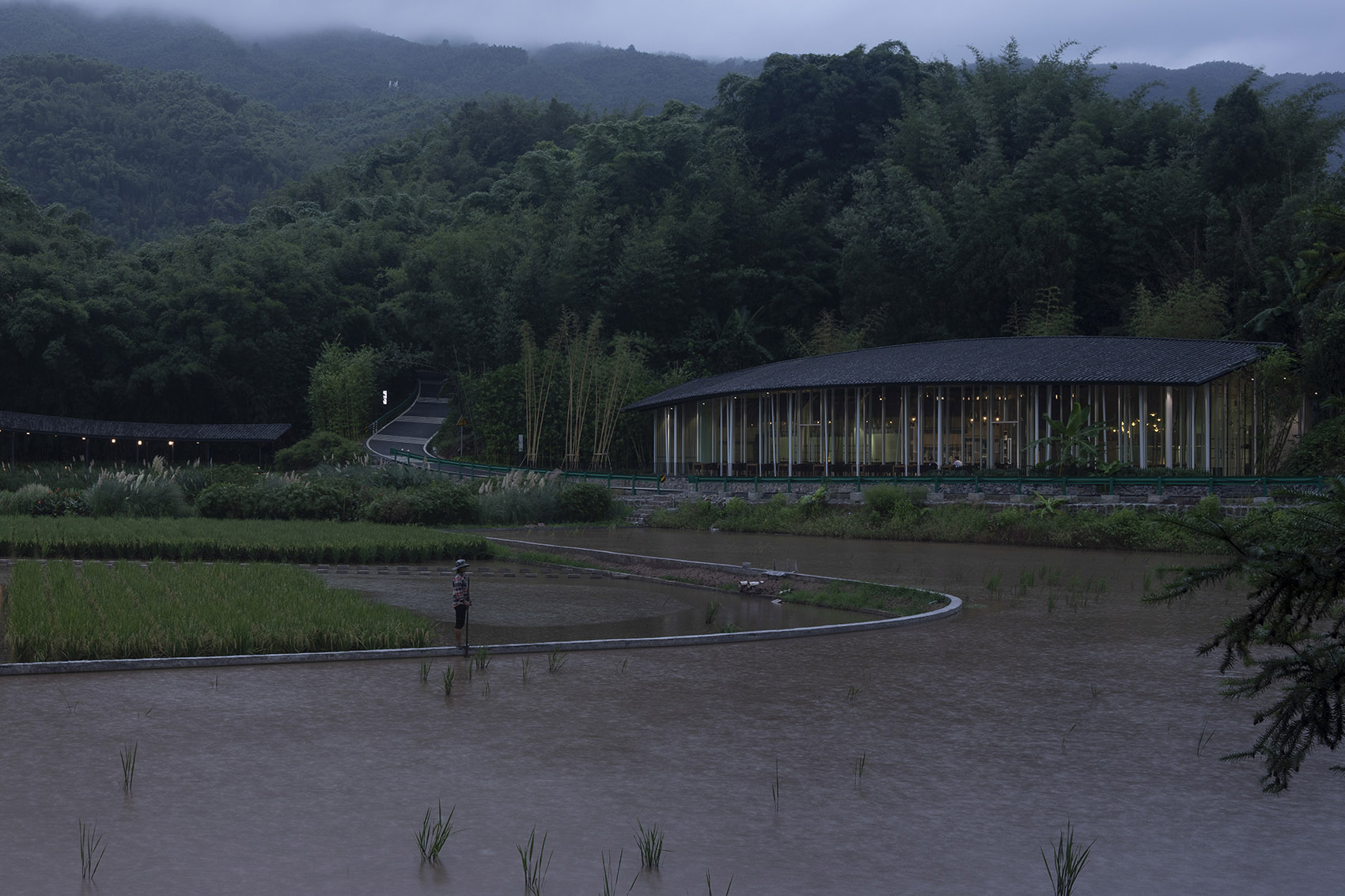
刘禹锡的《竹枝词》“杨柳青青江水平,闻郎江上踏歌声。东边日出西边雨,道是无晴却有晴。”这首词所描绘的田园意境,与竹枝书院所设想的一些人与人若即若离的互动场景亦极其相似。
“Between the willows green the river flows along; I hear my beloved from a boat breaking into song. The west is veiled in rain, the east enjoys sunshine; My beloved is as deep in love as the day is fine.” Liu Yuxi’s Bamboo Branch Song depicts an idyllic mood very similar to the scenes of interaction circulating for the architectural project of Bamboo Branch Academy.
▼场景意境,artistic conception ©马远-踏歌图局部
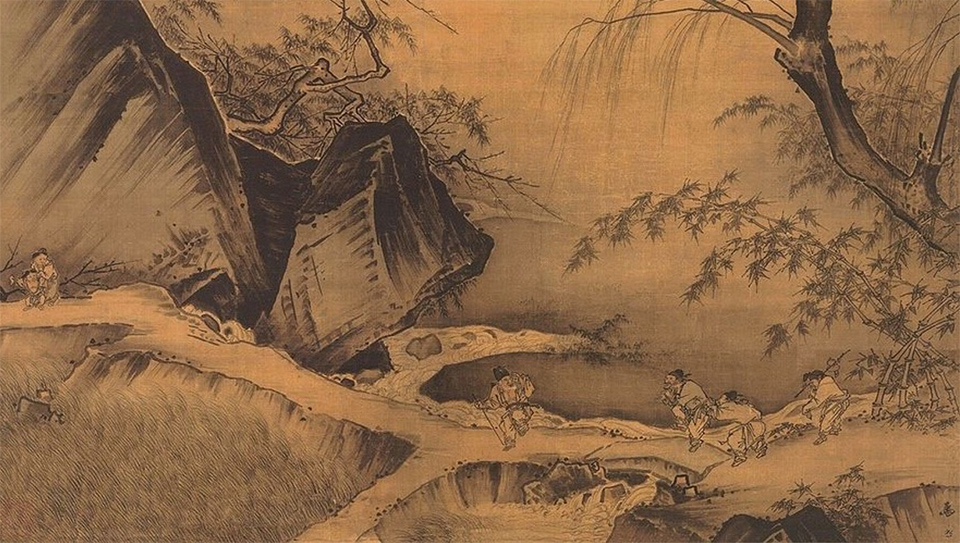
▼书院晨曦,the academy in the dawn ©存在建筑
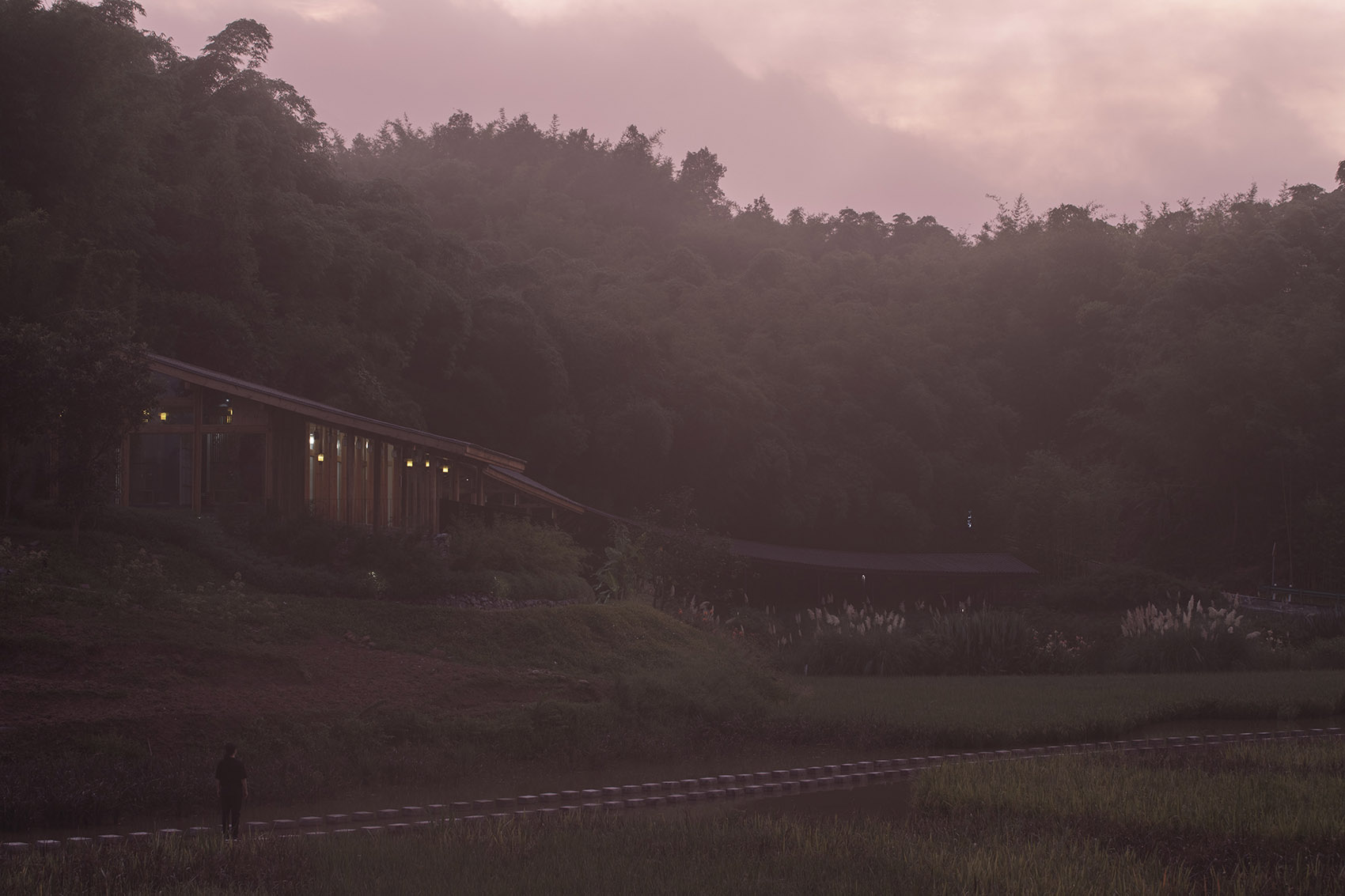
“竹枝书院”由两座川南老宅重塑而成,两座建筑要将乐坊、书院、禅修三个功能安置妥当,根据三个功能的融合性,将书院分置两地。远离道路清幽静谧的一座保护较好,拆除改造,与禅修结合形成相对静谧的禅修书院;紧临道路开敞嘈杂的一座破损严重,拆除新建,与乐坊结合形成相对开放的乐坊书院。两座书院之间用廊相连,营造“绕屋”之“象”的同时,增加户外多功能空间,赋予书院更多元的生命力。
“Bamboo Branch Academy” is created by remodeling two old houses in southern Sichuan. The functions of the music workshop, academy, and meditation should be well combined to separate Bamboo Branch Academy into two parts. The house far away from the road is serene and properly protected. It is renovated and turned into an academy for meditation. The one near the road and thus noisy is severely damaged and should be rebuilt into the music workshop. The two academies are connected by a corridor to create an “image” of “surrounding the house” and a multi-functional outdoor space to add vitality.
▼禅修书院雨景,the academy for meditation ©存在建筑
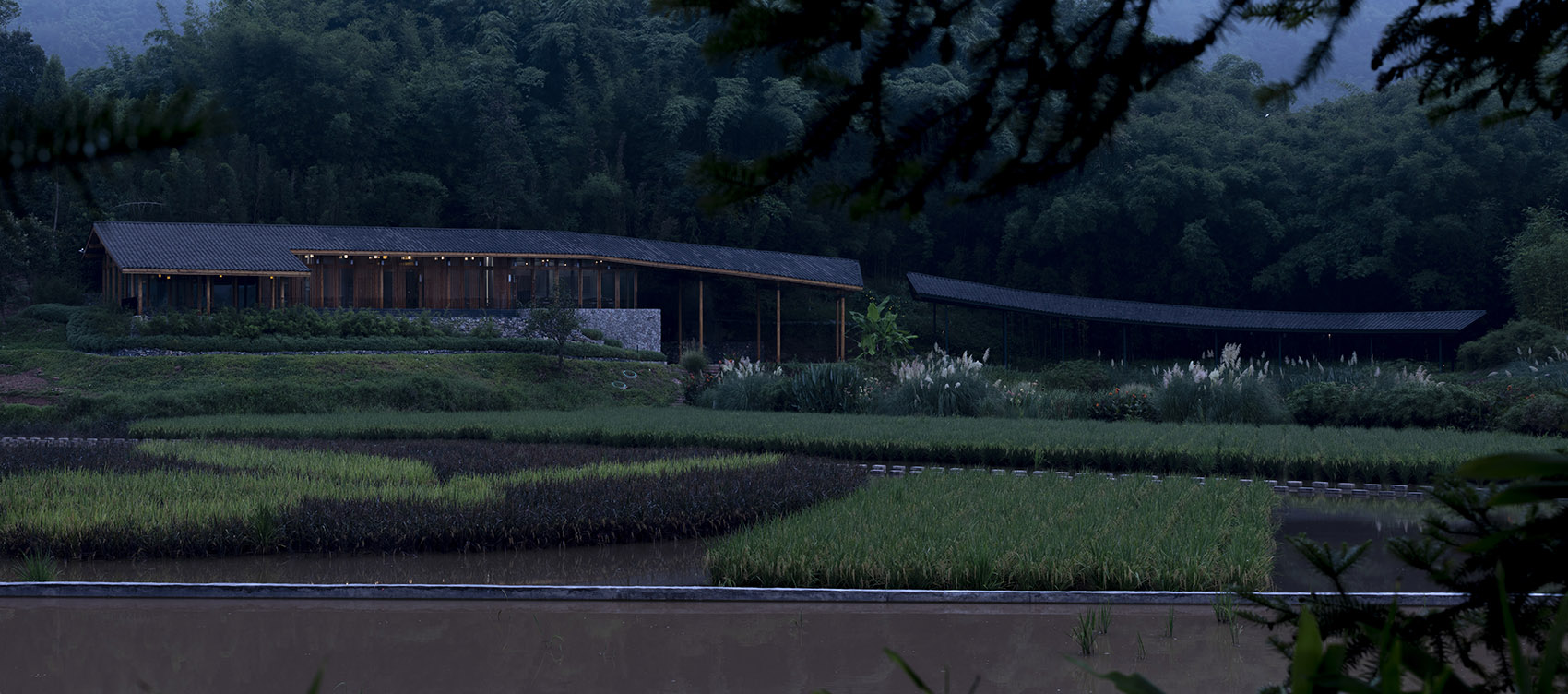
▼禅修书院夜景,night view ©存在建筑
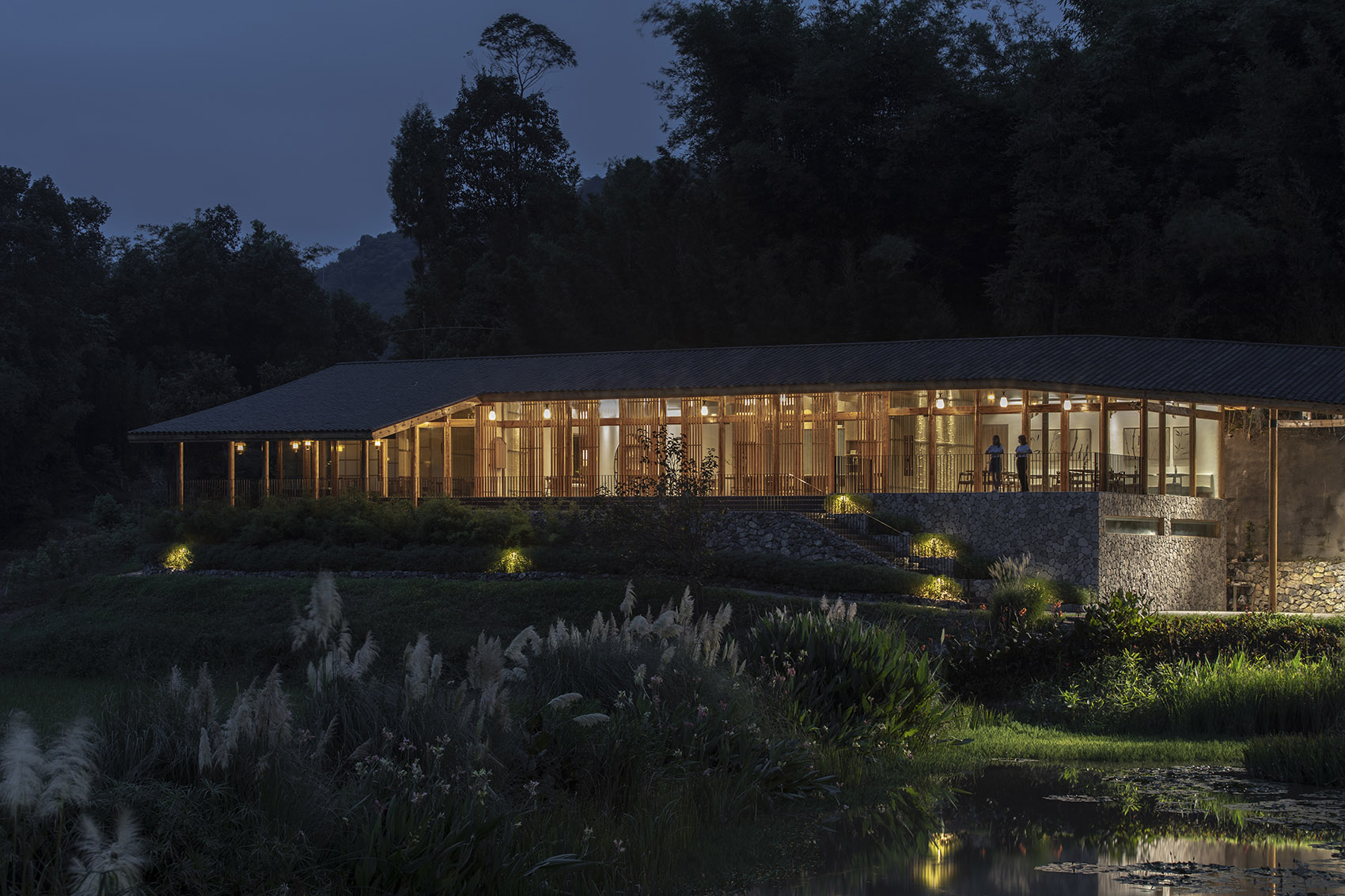
▼乐坊书院与竹林,the music workshop ©存在建筑
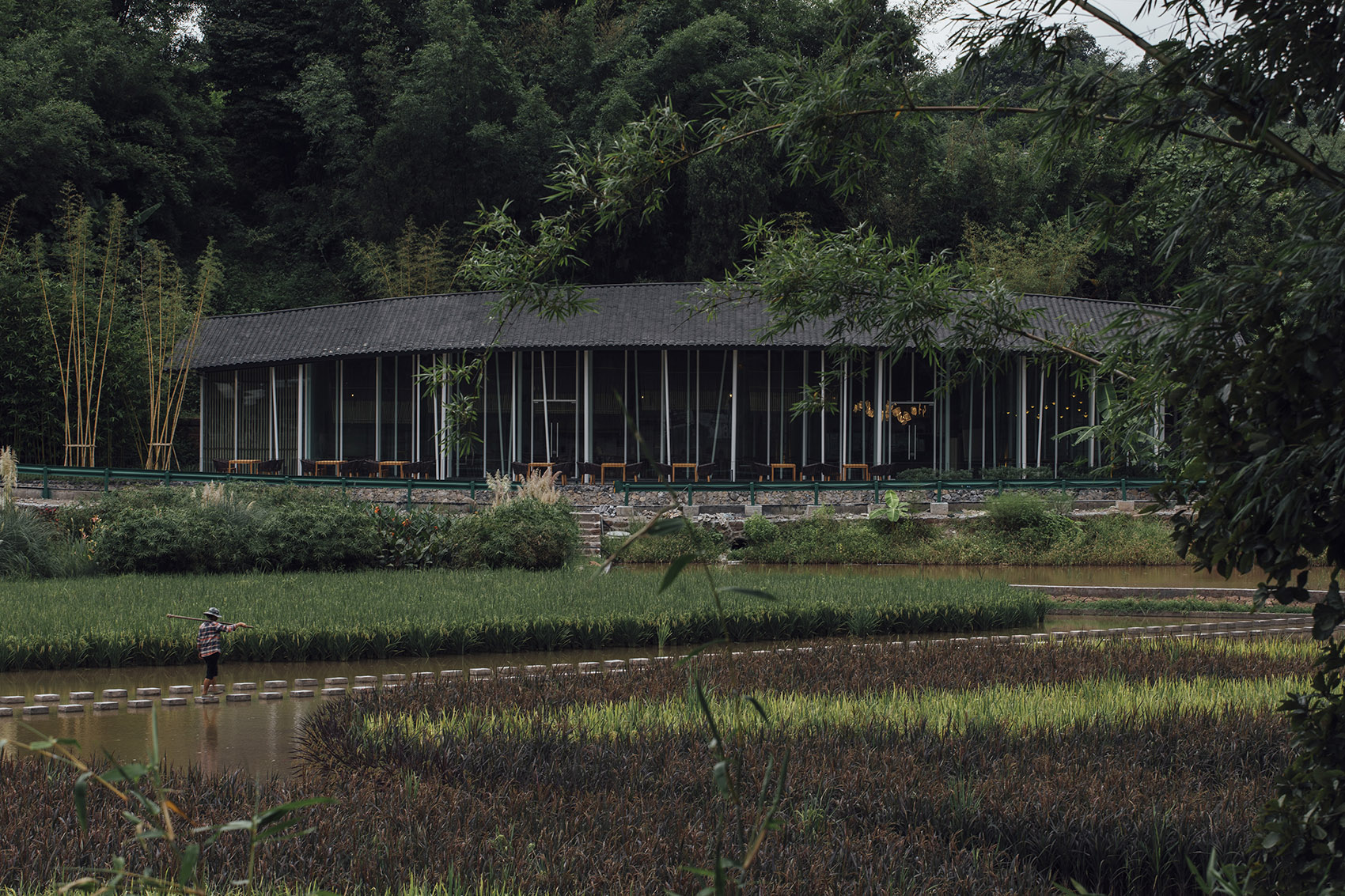
▼乐坊书院夜景,night view ©存在建筑
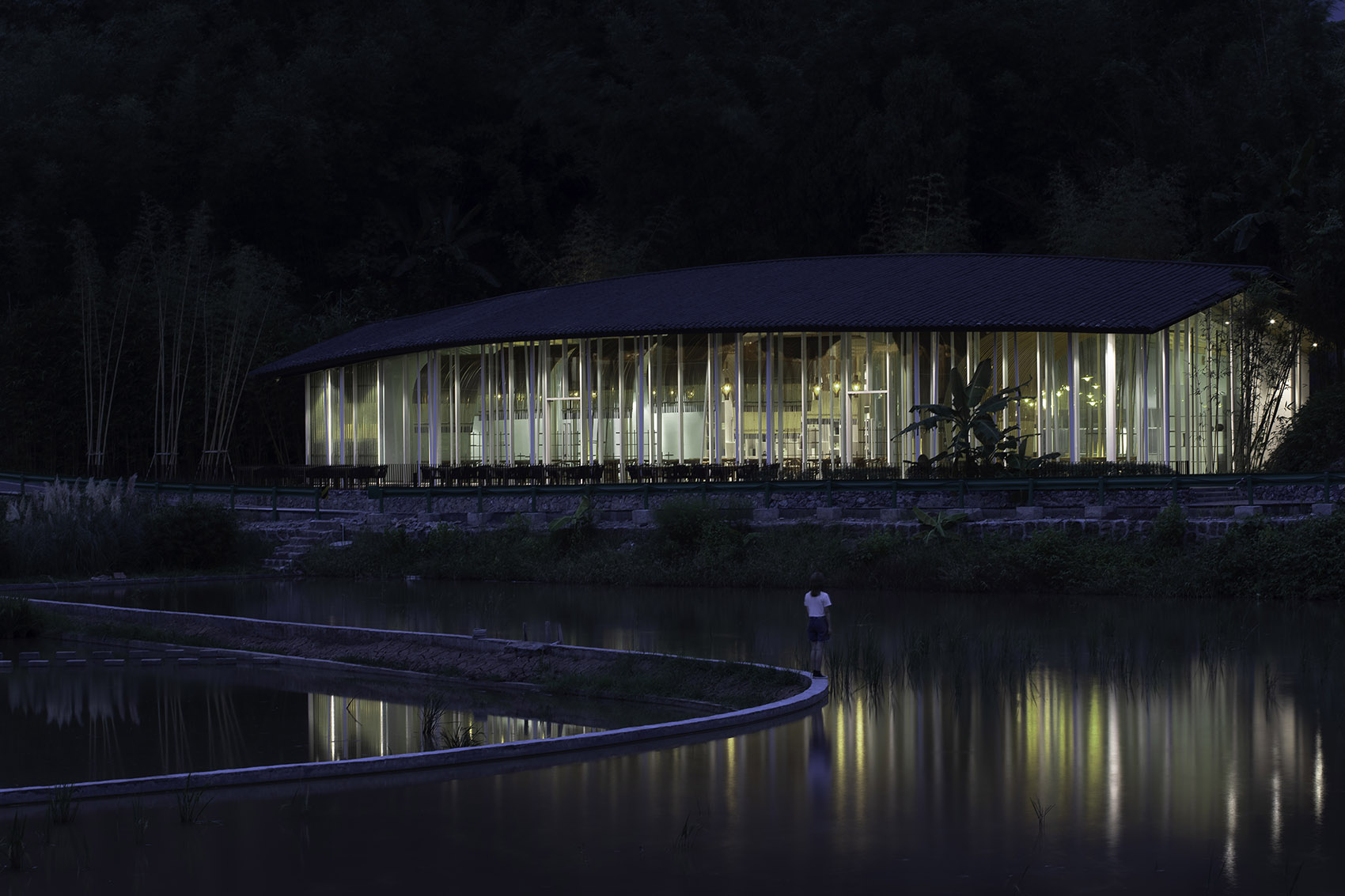
▼书院屋顶绕屋之象,the two academies are connected to create an image of “surrounding the house” ©存在建筑
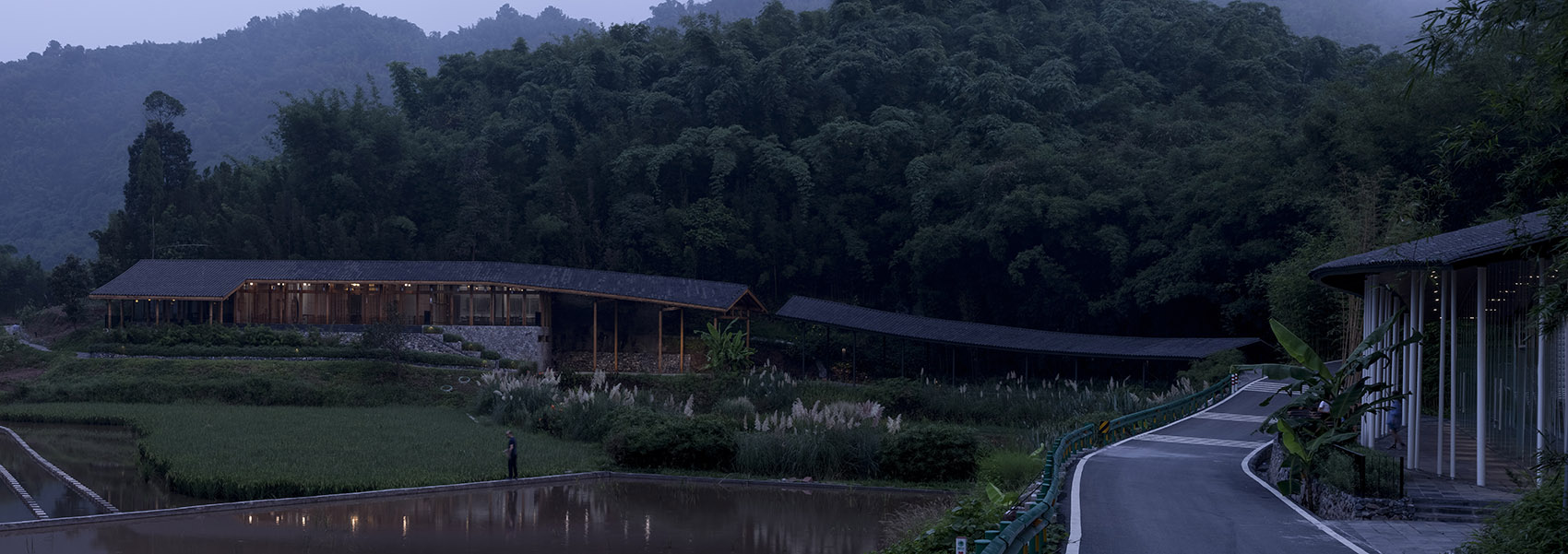
▼书院连廊,the connecting corridor ©存在建筑
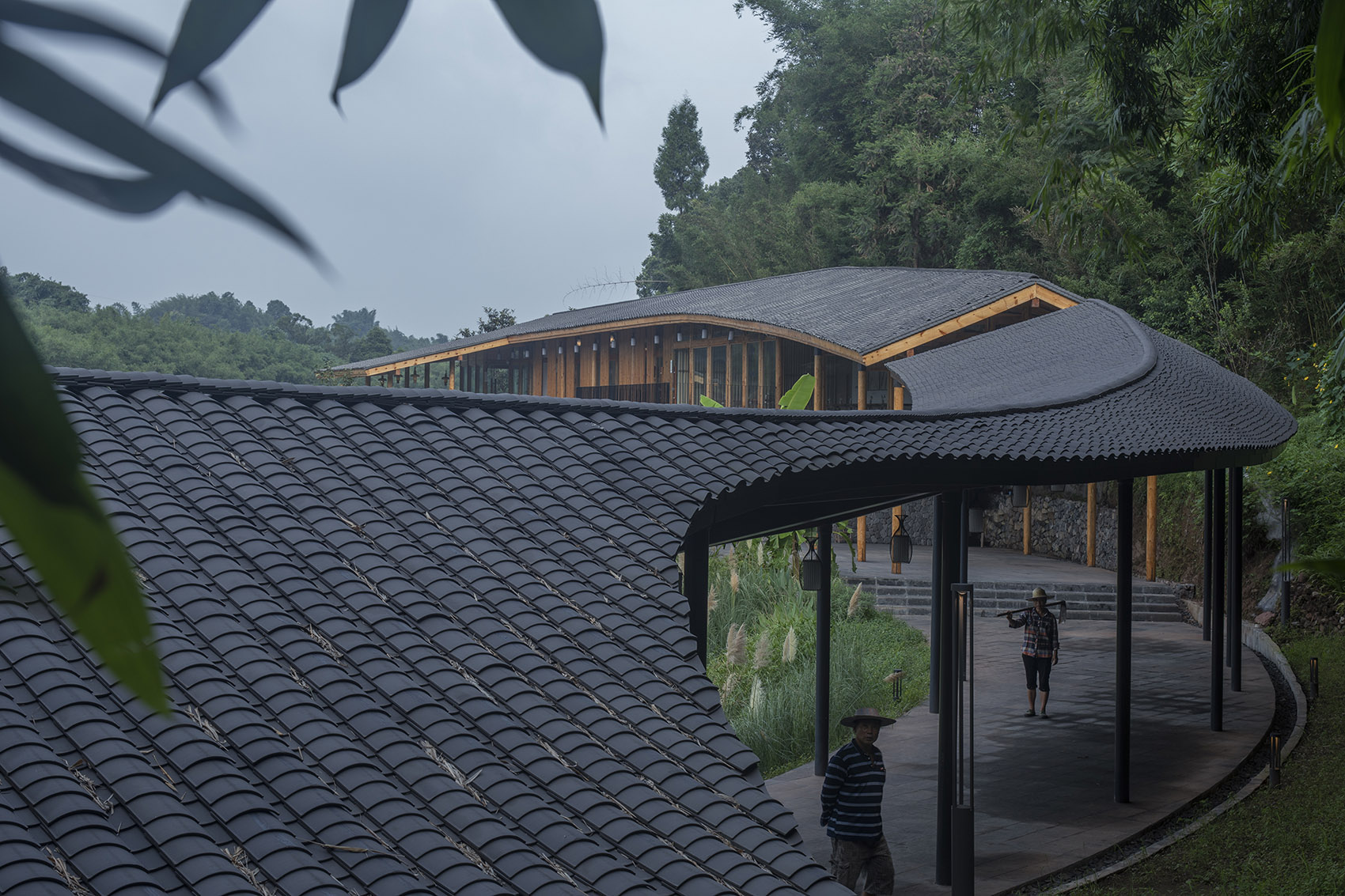
竹“虚怀若谷”之“意”与禅修“禅”之“意”有许多共通之处,“竹节”之“意”化为禅修书院内外空间之“象”,半户外的庭院、檐廊和通而不透的室内雅室均是竹节意象的具体呈现;竹“卓尔不群”之“意”与乐坊“中兴”之“意”相互融合,“竹丛、竹影斑驳、竹径通幽”之“意”化为乐坊书院整体空间之“象”,庭院的竹丛、外廊的白色钢圆管、室内的玻璃天井和竹装置挂饰都是对竹林、竹影、竹径意象的抽象再现。
The modesty of bamboo shares something in common with zen. The idea of bamboo knots is turned into the form of the interior and exterior of the academy for meditation. The image of bamboo knots is materialized with the semi-outdoor yard, the porch with eave and the ventilated yet non-penetrated inner room. The idea of the unrivaled nature of bamboo is integrated with that of liveliness of the music workshop. The idea of “bamboo groves casting shadows and flanking a winding path to tranquility” blends into the image of the whole space of the music workshop, and is represented in an abstract way by the bamboo thickets in the yard, the white steel pipes in the porch, the indoor glass patio and bamboo installations.
▼禅修书院庭院,the courtyard of the academy for meditation ©存在建筑
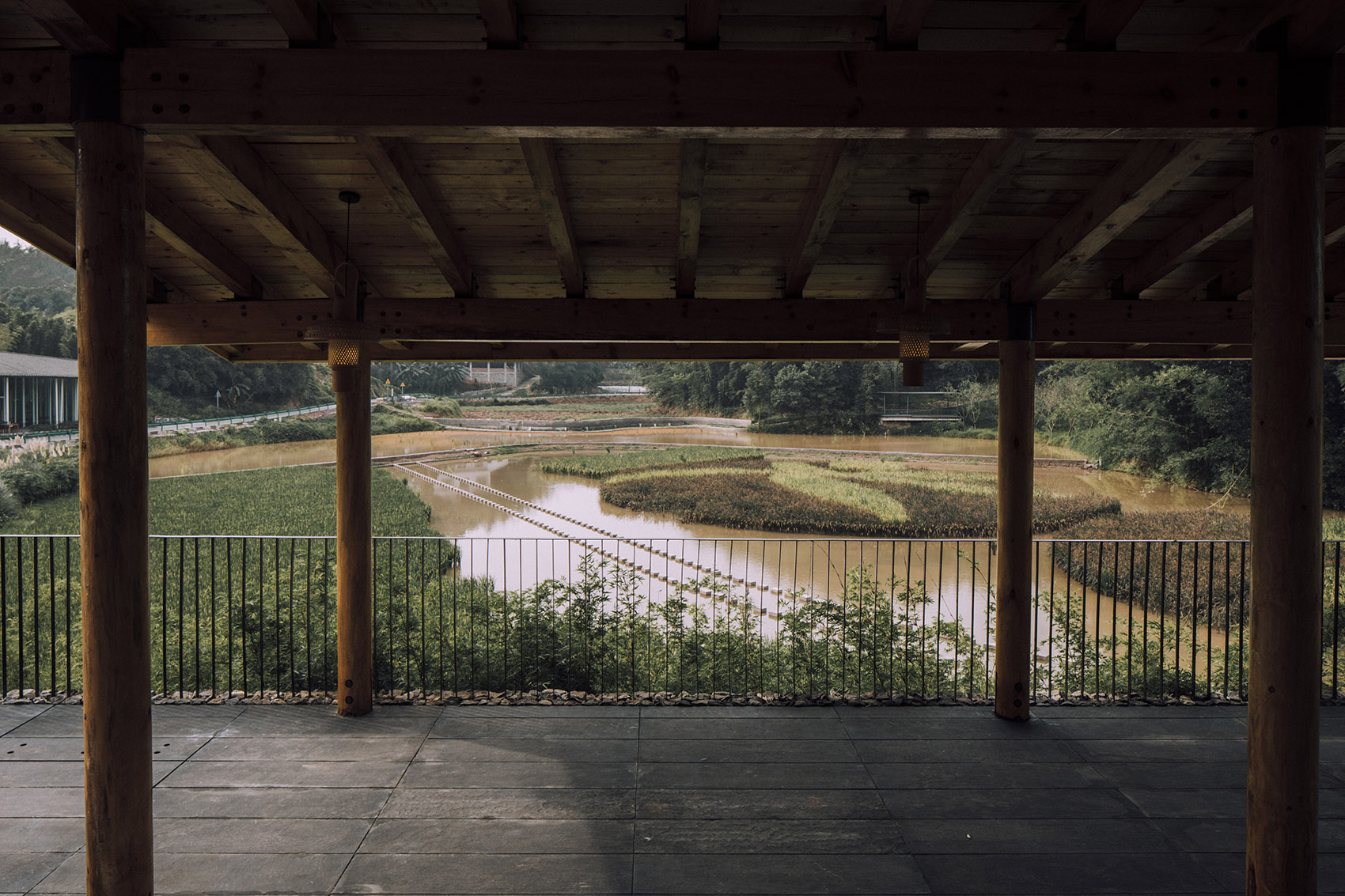
▼禅修书院檐廊,the covered gallery of the academy for meditation ©存在建筑

▼禅修书院禅茶,the tearoom of the academy for meditation ©存在建筑
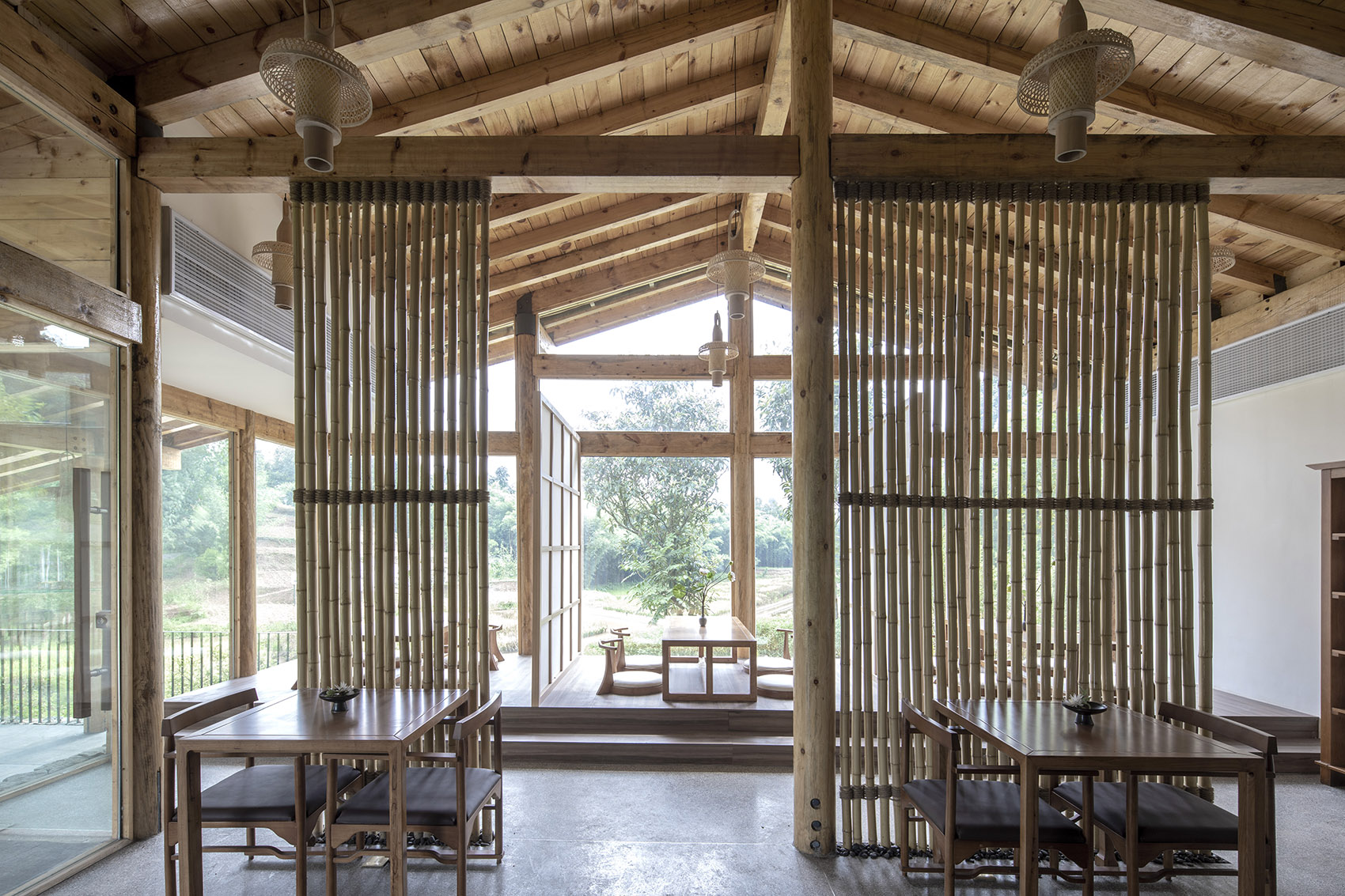
▼乐坊书院庭院,the courtyard of the music workshop ©存在建筑

▼乐坊书院檐廊和天井,the gallery and patio of the music workshop ©存在建筑
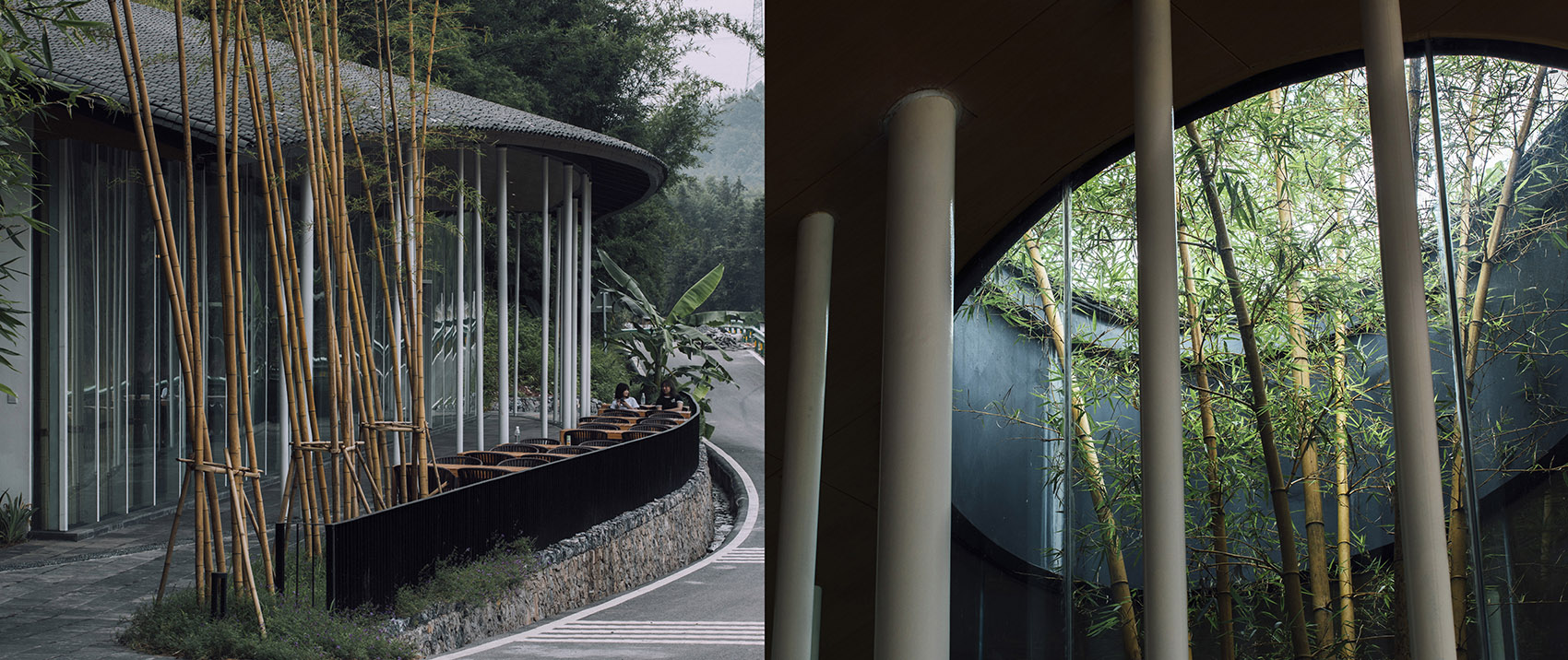
▼乐坊书院竹装置,bamboo installation ©存在建筑
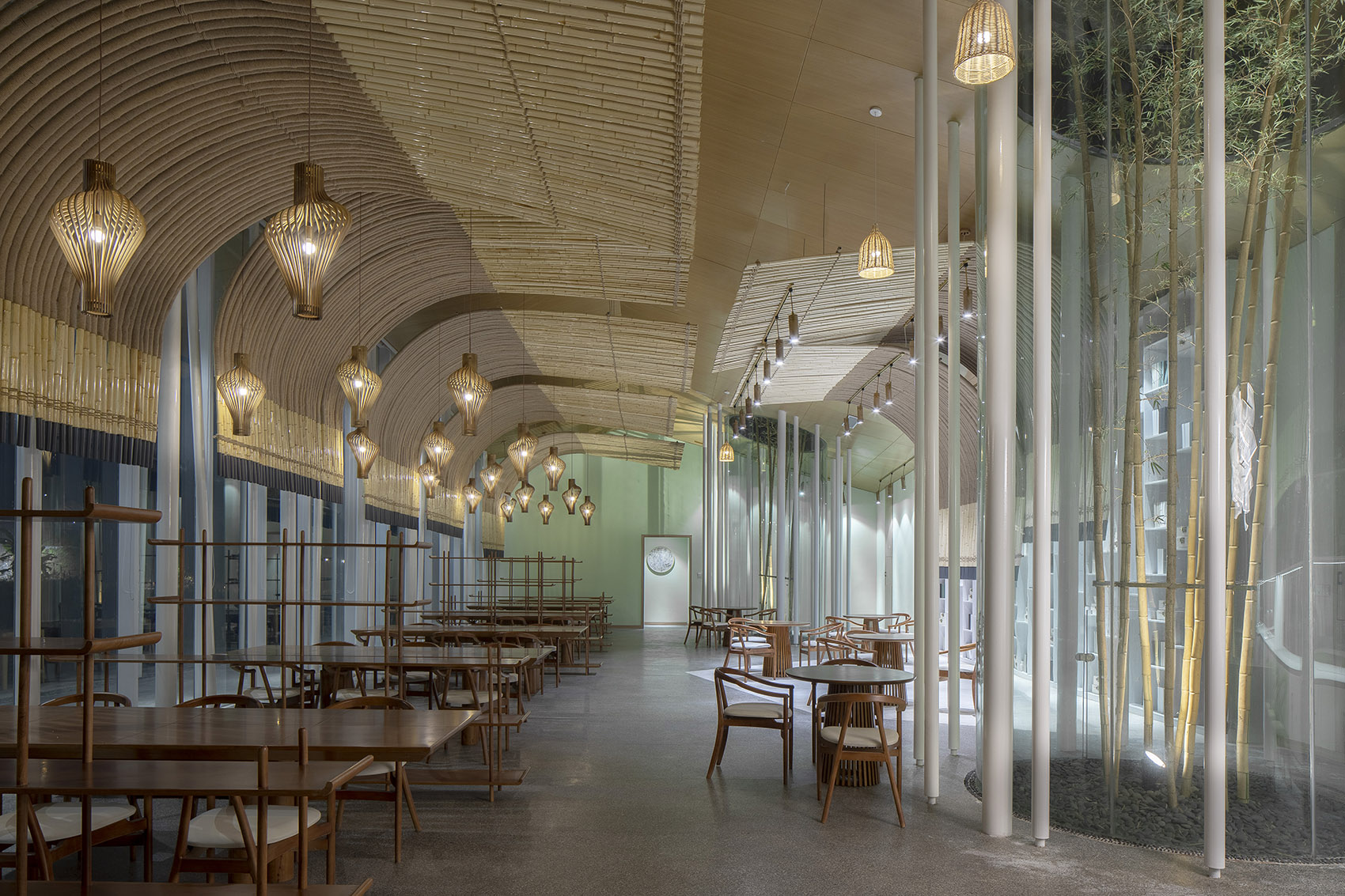
延绵起伏的小青瓦屋面即是“绕屋”意象的体现,也是与周围“爬满竹林的小山丘”的融合,亦是与当地民居“新旧共荣”的回应。芭蕉、竹丛、田间小路的重置融合,让“竹枝书院”这个新成员以“柔软的心”回归村子母亲的怀抱!
The undulating grayish blue tiled roof, the embodiment of the image that the “house is surrounded,” is compatible with the “hills covered with bamboo forests” in the vicinity, and a response to the requirements of local people for “prosperity of the new and the old.” The relocation and integration of plantain trees, bamboo groves and farm paths endow Bamboo Branch Academy with a gentle heart, which, as a new member, is once again embraced by the village!
▼竹枝书院与竹林山丘,Bamboo Branch Academy dialoguing with the mountain ©存在建筑
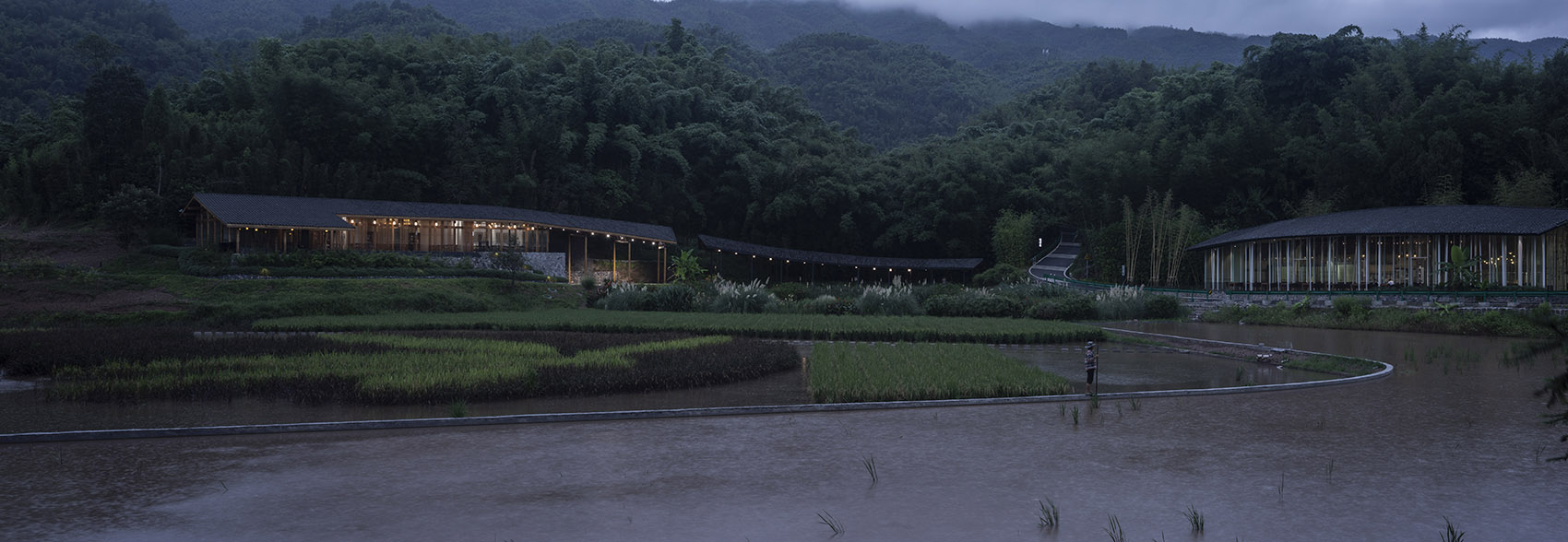
▼小青瓦屋面,the undulating grayish blue tiled roof ©存在建筑

希望“竹枝书院”在成为“宜宾永江村美丽乡村风景线”的同时,亦能为这个小村子带去更多的“诗情画意”。
Bamboo Branch Academy is expected to shape the scenery of and add “poetic and pictorial splendor” to Yongjiang Village, Yibin.
▼竹枝书院与芭蕉和村民,Bamboo Branch Academy, plantain trees and a villager ©存在建筑
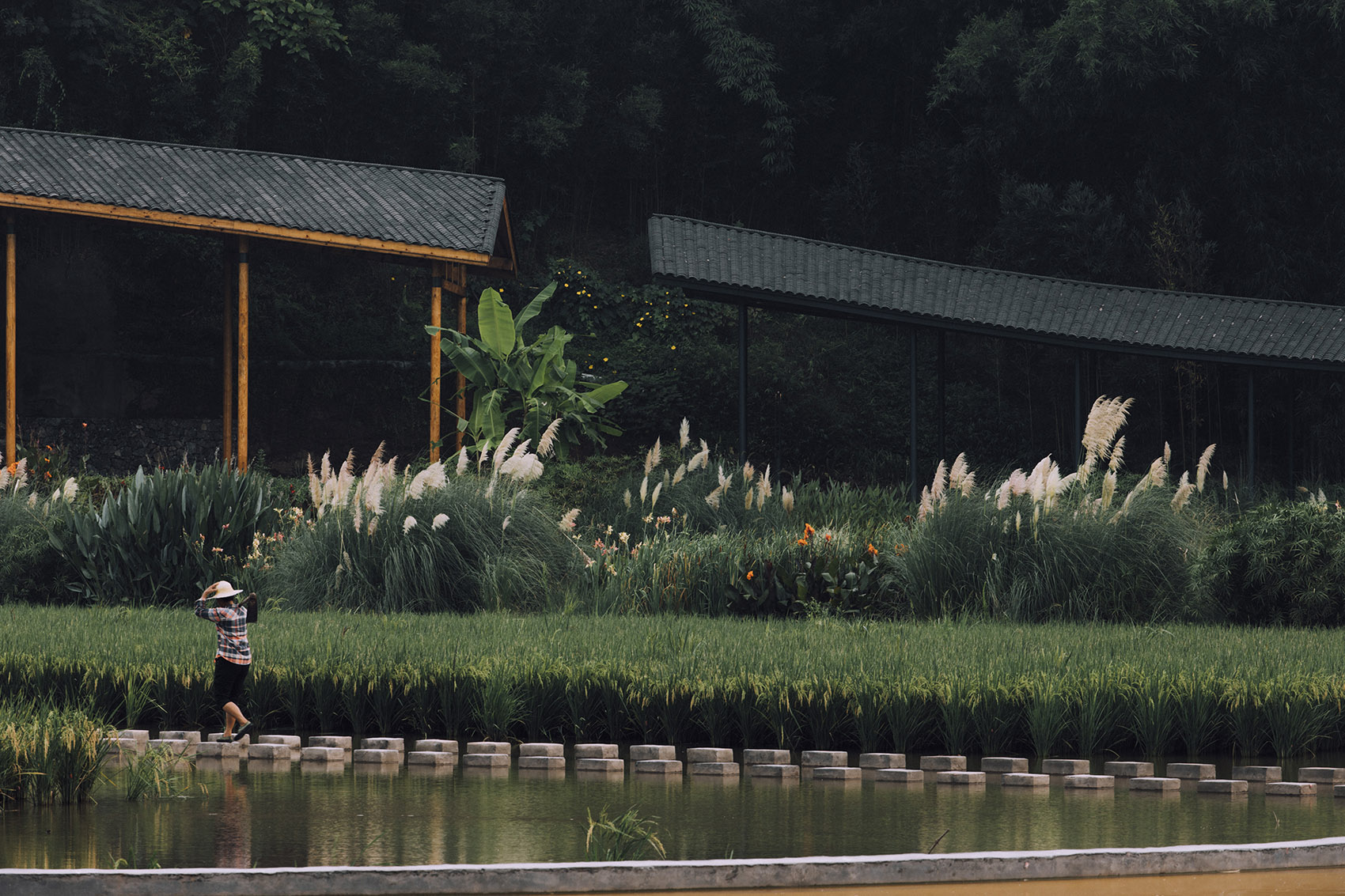
项目主创团队:小隐建筑事务所 Project Team: Archermit 主持建筑师:潘友才 Leading Architect: Pan Youcai 设计总监:杨喆(合伙人) Design Director: Yang Zhe (Partner) 技术总监:陈仁振(合伙人) Technical Director: Chen Renzhen (Partner) 结构工程师:杜旭 Structural Engineer: Du Xu 设计团队:李紫涵、胡沁梅、叶淑华、何仪、苟源君、葛祥鑫、杨锐、梁贵生、王茜、李刚、张伟 Design Team Members: Li Zihan, Hu Qinmei, Ye Shuhua, He Yi, Gou Yuanjun, Ge Xiangxin, Yang Rui, Liang Guisheng, Wang Qian, Li Gang, Zhang Wei 施工图设计公司:成都思纳誉联建筑设计有限公司 Construction Drawing Designed by: Chengdu CNASMITH Group Co., Ltd. 项目地址:四川省宜宾市长宁县竹海镇永江村 Project Location: Yongjiang Village, Zhuhai Town, Changning County, Yibin, Sichuan Province 建筑面积:533平方米 Floor Area: 533 square meters 设计时间:2019年2月-2019年5月 Term of Design: February-May 2019 业主单位:四川中瑞锦业文化旅游有限公司 Owner: Sichuan Zhongrui Jinye Cultural Tourism Co., Ltd.
